The Project Gutenberg eBook of Zoological Illustrations, Volume 2
most other parts of the world at no cost and with almost no restrictions
whatsoever. You may copy it, give it away or re-use it under the terms
of the Project Gutenberg License included with this ebook or online
at www.gutenberg.org. If you are not located in the United States,
you will have to check the laws of the country where you are located
before using this eBook.
Title: Zoological Illustrations, Volume 2
Author: William Swainson
Release date: April 17, 2012 [eBook #39472]
Language: English
Credits: Produced by Chris Curnow, Keith Edkins and the Online
Distributed Proofreading Team at https://www.pgdp.net (This
file was produced from images generously made available
by The Internet Archive)
*** START OF THE PROJECT GUTENBERG EBOOK ZOOLOGICAL ILLUSTRATIONS, VOLUME 2 ***
Transcriber's note: | The listed Addenda & Corrigenda have been applied. All corrections are highlighted like this, and the nature of the correction will appear when the mouse pointer is moved over the marked passage. |
Zoological Illustrations,
OR
ORIGINAL FIGURES AND DESCRIPTIONS
OF
NEW, RARE, OR INTERESTING
ANIMALS,
SELECTED CHIEFLY FROM THE CLASSES OF
Ornithology, Entomology, and Conchology,
AND ARRANGED ON THE PRINCIPLES OF
CUVIER AND OTHER MODERN ZOOLOGISTS.
BY
WILLIAM SWAINSON, F.R.S., F.L.S.,
MEMBER OF THE WERNERIAN SOCIETY OF EDINBURGH, ETC.
VOL. II.
London:
PRINTED BY JAMES MOYES, GREVILLE STREET;
FOR BALDWIN, CRADOCK, AND JOY, PATERNOSTER-ROW;
AND W. WOOD, STRAND.
1821-2.
TO
SIR JAMES EDWARD SMITH, M. D.
FOUNDER AND PRESIDENT OF
THE LINNÆAN SOCIETY OF LONDON,
FELLOW OF THE ROYAL SOCIETY, AND MEMBER OF THE
PRINCIPAL SCIENTIFIC SOCIETIES BOTH IN
EUROPE AND AMERICA,
THE FIRST AND SECOND VOLUMES
OF
Zoological Illustrations
ARE DEDICATED,
AS A SMALL, BUT SINCERE TRIBUTE TO THE EMINENT TALENTS OF
THE PHILOSOPHER,
AND THE EXCELLENT QUALITIES OF
THE MAN.
Pl. 67
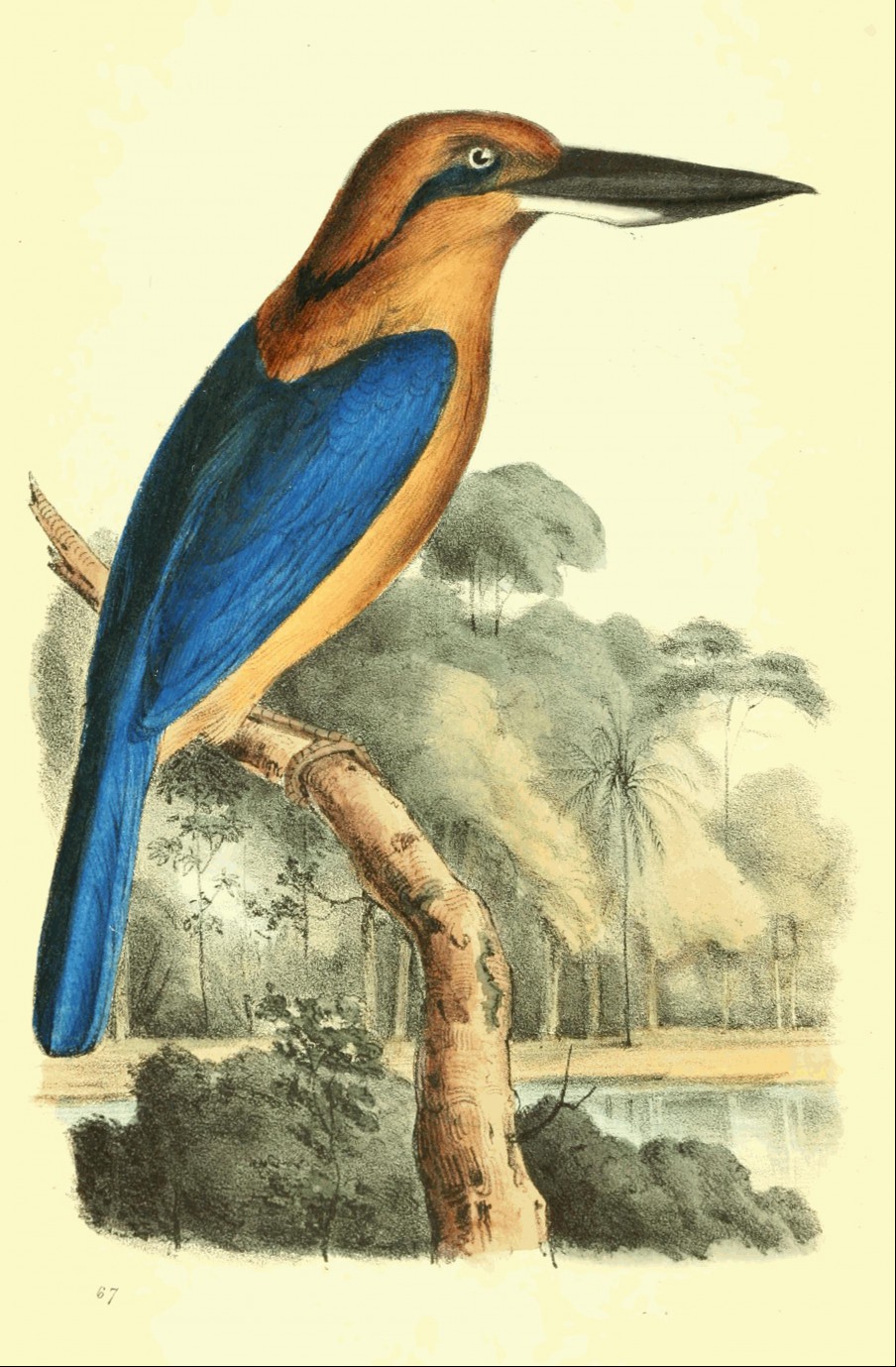
HALCYON cinnamominus,
Cinnamon Crabeater.
Generic Character.—See Pl. 26.
Specific Character.
H. cæruleo viridis; pileo, collo, plumisque totis subtùs pallidè cinnamominis; auribus viridibus;
nuchâ torque nigro gracili ornatâ.Blue-green; upper part of the head, neck, and all beneath, pale
cinnamon colour; ears green; round the nape a slender black collar.
As far as I can ascertain, this beautifully coloured bird is quite
new, and hitherto undescribed. It is in the possession of Mr. Leadbeater,
of Brewer Street, by whom it was received from New Zealand; and who gave
me the opportunity of now publishing the accompanying figure and
description.
The two extreme points of difference in the Linnæan kingfishers, are
seen in the Alcedo Ispida, and A. gigantea; the last of which has been made into the genus
Dacelo. It will, nevertheless, be found, that from among the birds
left in the old genus, there are a great number, (of which, indeed, this
bird is a striking example,) which are much nearer allied to
Dacelo than to Alcedo, where they now stand. It will
appear, therefore, more natural to consider Halcyon and
Dacelo as one genus—which may be called by either name, but
which must be distinguished by the characters herein given to
Halcyon, inasmuch as the generic definition of Dacelo
(founded on one bird) will be found too restricted to comprehend all.
Total length ten inches; bill two and a half from the gape, and one
and a half from the nostrils; the tip of the upper mandible with a slight
inclination downwards, and with an appearance of a notch; the whole head,
neck, and under plumage, of a delicate fawn colour; under wing covers the
same; the remaining upper plumage, with the wings and tail, changeable
blue green; ears sea green and dusky, united to a narrow black nuchal
collar; wings four inches long, and the tail, which is even, three and a
quarter; the hind head is slightly crested, and the feet pale brown.
Pl. 68
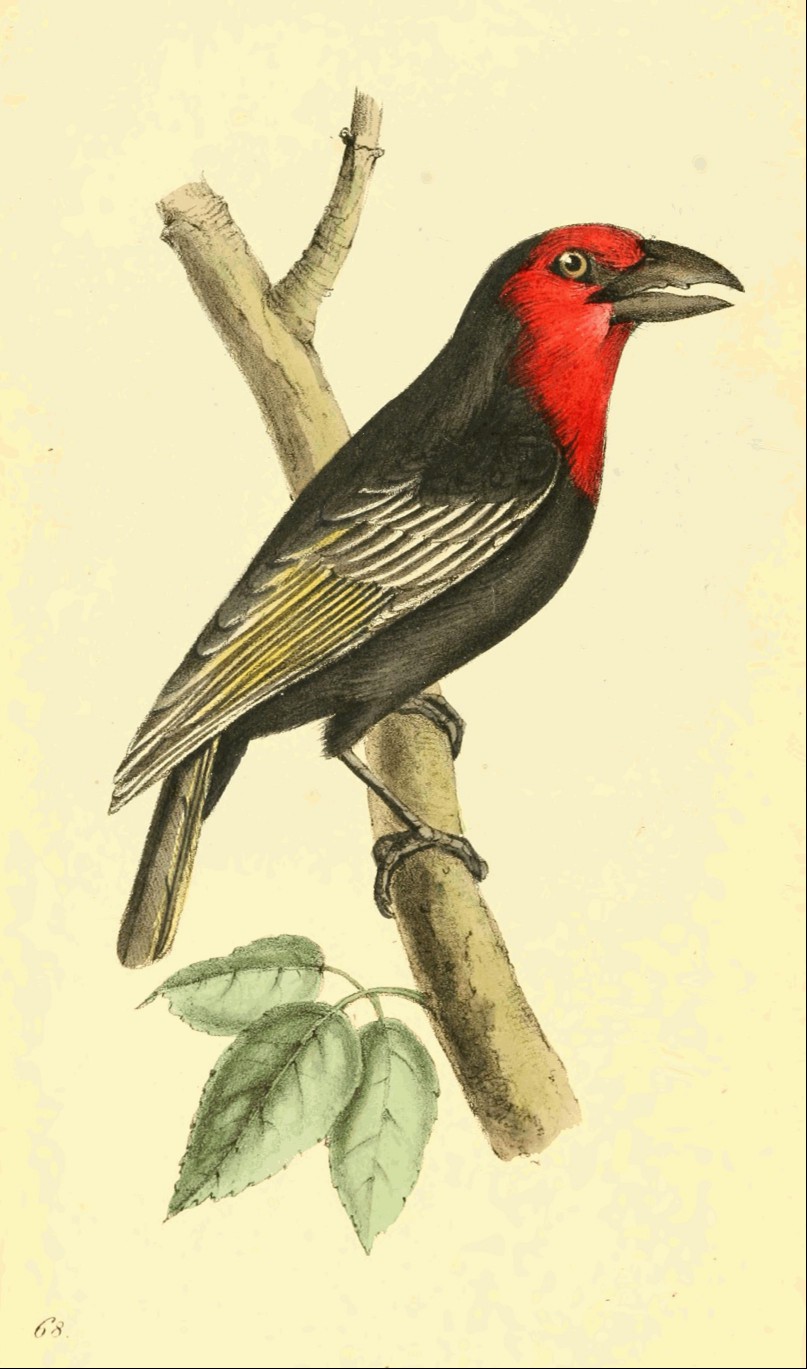
POGONIAS rubrifrons,
Red-fronted Toothbill.
Generic Character.
Rostrum mediocre, crassum, validum, basi latiore quam altiore,
vibrissis longis incumbentibus tectâ, lateribus ultra basin compressis,
culmine arcuato, subcarinato; mandibulæ superioris margine dentibus 1 vel
2 armato, mandibulæ inferioris marginem obtegente. Nares approximantes,
parvæ, rotundæ, per rostri basin perforatæ. Pedes scansorii, digitis
posticis versatilibus.
Typus Genericus Bucco Dubius Lath.
Bill moderate, thick, strong, the base broader than high, with long
incumbent bristles, the sides beyond compressed, the top arched, and
slightly carinated; upper mandible with one or two strong teeth on each
side, the margin folding over that of the lower mandible; nostrils
approximating, small, round, perforated through the base of the bill.
Feet scansorial. Hind toe versatile.
Generic Type Doubtful Barbut Lath.
Specific Character.
P. niger; sincipite juguloque rubris; alis et caudâ fuscis;
tegminum margine externo albo, remigum fulvo.Glossy black; forepart of the head and throat red; wings and tail
brown; external margin of the covers white, and of the quills yellow.
The Linnæan Barbuts, comprehended by Latham under one genus, contain
three distinct groups of birds; which, from their peculiar characters, no
less than their geographic position, have now received generic
distinctions. The first of these (which are still retained under the old
genus,) are natives of Asia; the next in affinity were first
characterized by Illiger under the name of Pogonias, and are
distributed on the African continent; while the prototype genus in
America is Tamatia (Cuvier), in which continent not any of the two
preceding have been found: thus each quarter of the globe lying within
the tropics have their corresponding groups of a family, possessing a
general, but at the same time an individuality of character.
I am obliged to Mr. Leadbeater for the opportunity of figuring this
new and rare species, which he believes to have come from Sierra Leone.
Its total length was six inches; the under-covers of the wings white; the
tail two inches long, the feathers broad and even.
Pl. 69
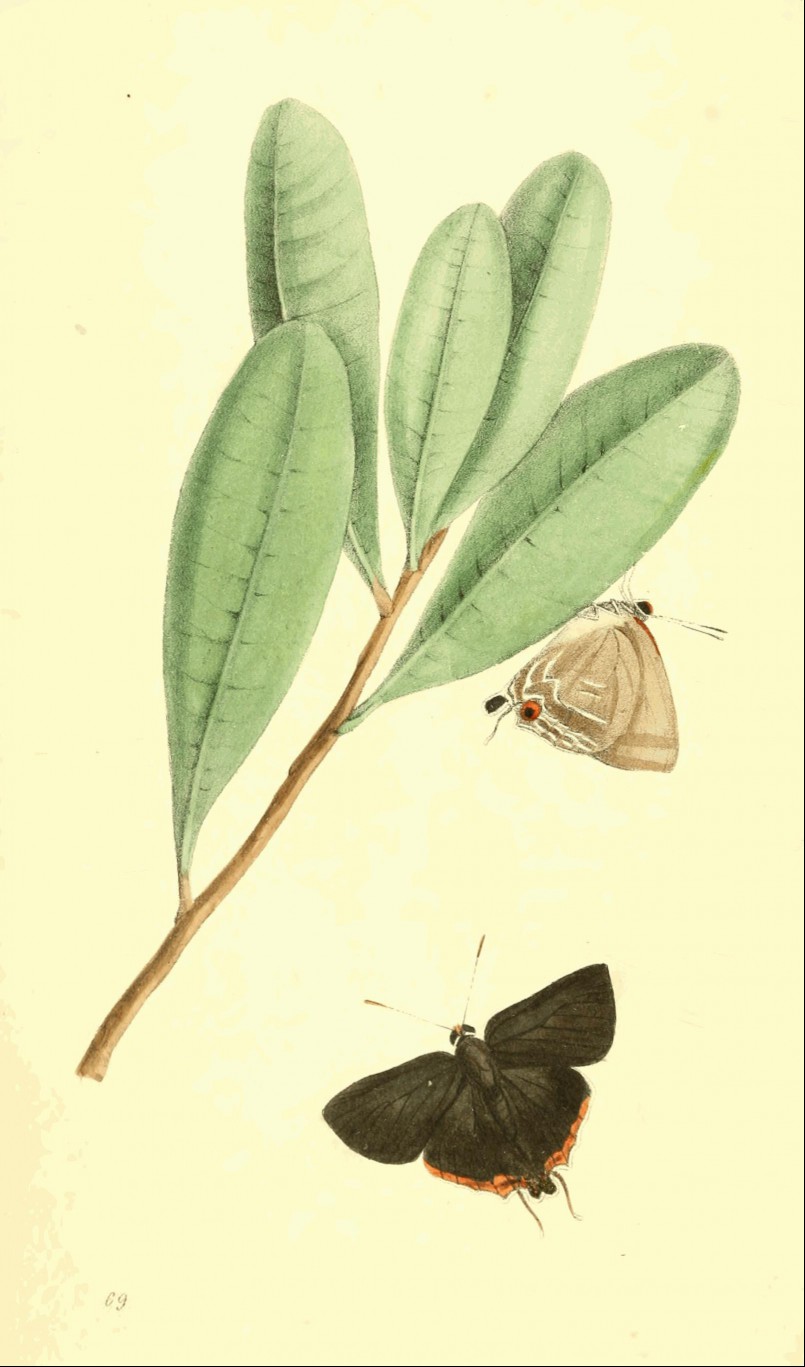
THECLA Galathea,
Red-bordered Hair-streak.
Generic Character.
Antennæ clavo elongato, compresso, obtuso terminatæ. Palpi exserti,
recti, approximantes, squamis obtecti, imberbes, articulo ultimo nudo,
gracili, acuto. Oculi semicirculares. Alæ anticæ trigonæ; posticæ
dentatæ, caudatæ, lobo ad angulum analem obtuso, concavo, quem sedentes
vibrant, instructæ. Thorax validus. Abdomen gracile.
Typus Genericus Papilio Betulæ, &c. Lin.
Antennæ ending in a lengthened, compressed, and obtuse club. Palpi
exserted, approximating, covered with scales, but without hairs,
the last joint naked, slender, acute. Eyes semi-circular. Anterior wings
trigonal, the hinder dentated, generally tailed, with an obtuse concave
lobe at their anal angle, which is generally in motion when the insect is
at rest. Thorax strong; body slender.
Generic Type Papilio Betulæ, &c. Lin.
Specific Character.
T. alis fuscis, colore violaceo nitidis, posticis caudatis, margine
rubro, subtus maculo nigro lunulâque rubrâ ornatis; lobo anali suprà
ærato, subtus nigro.Wings brown, glossed with violet; posterior tailed, with a red margin,
beneath with a black spot and red lunule, anal lobe above bronzed,
beneath black.
The beautiful little Butterflies included by Fabricius in this genus,
are scattered over all parts of the world, but are most numerous within
the tropics, and particularly in South America, for in Brazil alone I
collected near 120 species. They are an obvious and very natural family,
though the species are as yet but little understood, and not one half of
them described. I have observed a singular peculiarity in a great many of
these insects, which is, that when they are at rest in the sun, the lower
wings are constantly in a quick vibrating motion up and down, as if the
insect was rubbing them together, more particularly where the two lobes
(or obtuse tails) of the under wings meet, though what purpose this is
intended to accomplish remains unknown.
The upper surface of the wings in the greatest number of the Hair
streaks (as they are aptly called by English collectors) are of
various shades of vivid blue, so that the species can only be ascertained
from the under markings, which are usually very striking and delicate:
they are all of a small size.
This is an African species, and both sexes are in the cabinet of my
friend Mr. Haworth.
Pl. 70

CONUS terebra,
Screw Cone.
Generic Character.—See Pl. 65.
Specific Character.
C. cylindraceo-elongatus, albidus, striis transversis elevatis,
fasciisque binis flavescentibus, spirâ crassâ obtusâ.
Lam.Cylindric elongated; whitish, with two yellowish bands, and transverse
elevated striæ; spire thick, obtuse.Conus Terebellum. Gmelin, p. 3390. 44. (omitting the
varieties). Martini 2. tab. 52. fig. 577.
Seba, 42. fig. 13. (uncoated). Ency. Meth. 339.
fig. 1.Conus Terebra. Lamarck. Annal. du Mus. vol. xv. p. 427.
no. 144. Var. A, without bands.Ency. Methodique, 339. fig. 2.
Though this is not an uncommon Shell, it is rarely seen so large as
that now represented from the cabinet of Mrs. Bolton of Storrs. Of this
extensive genus Lamarck has written a valuable account in the Annals of
the French Museum, where he has rightly pointed out the mistake of Gmelin
in placing as varieties of this species, one or two other very distinct
shells: the colour of the bands is not always certain, for I have seen
specimens in which they were of a dark brown; but the very thick spire,
and slender form of the body whirl, with the distant, regular, and
greatly elevated striæ, render it a species not easily mistaken, though in general form
it comes very near to C. nussatella, and two or three others; the
spiral volutions are deeply concave, and the tip and base tinged with
violet.
It is a native of the Indian seas.
Pl. 71
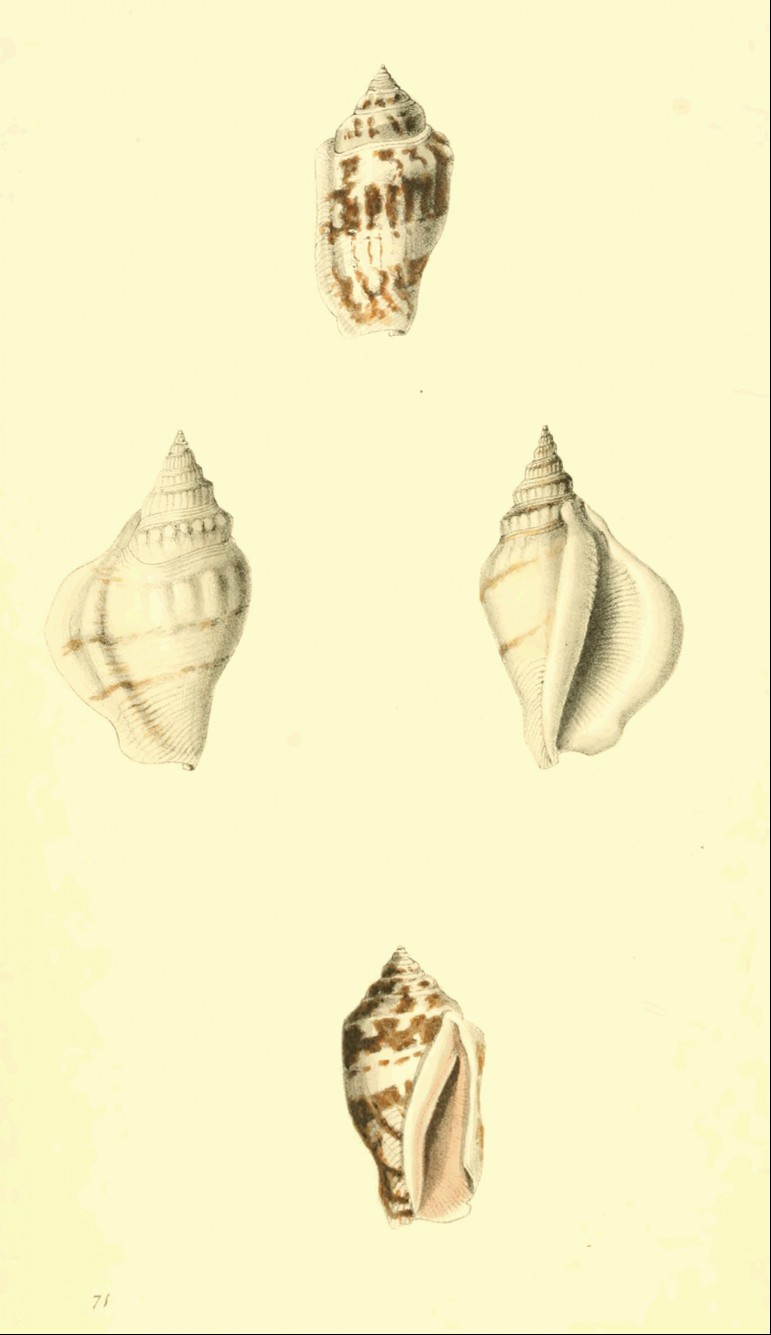
STROMBUS mutabilis,
Little pink-mouthed Strombus.
Generic Character.—See Pl. 10.
Specific Character.
S. anfractu basali nodoso; spirâ brevi tantum non lævi; lineâ
sulcatâ suturæ parallelâ; labio exteriore supra gibbo, margine recto,
interiore crasso, cum exteriore striato; aperturâ pallidè rubicundâ, basi truncatâ.Basal whirl nodulous; spire short, nearly smooth, with a sulcated line
parallel with the suture; outer lip above gibbous, the margin straight;
inner lip thick, both striated; aperture flesh colour; base
truncated.Seba, tab. 61. fig. 26 & 27, 32 & 33, 54.
tab. 62. fig. 42 & 43? Martini 3. tab.
77, 799. fig. 78, 807. Knorr. 2, 14. fig. 3.
Rump. 37. W.
The specific distinction given by Linnæus to Strombus urceus is so loose, that his followers have referred all the
small species of this genus to the numerous varieties he has quoted,
though few will doubt that many permanent species have been thus
overlooked; among these the one now characterized is an example, the most
striking distinctions of which are in the spire being never plaited, and
always much shorter than the mouth, which latter is either nearly white,
or of a flesh colour; in its external colouring no two specimens will be
found alike. It is not an uncommon shell from the East Indies, and seldom
grows larger than the figure.
STROMBUS dilatatus,
Winged Strombus—middle figures.
S. testâ transversè striatâ; spirâ mediocri, plicis numerosis gracilibus; labio exteriore dilatato, rotundato, crassissimo,
reflexo; interiore suprà crassescente, medio lævi; aperturâ
striatâ.
Shell transversely striated; spire moderate, with slender numerous
plaits; outer lip dilated, rounded, very thick, and reflected; inner lip
thickened above, smooth in the middle; aperture striated.
An undescribed species, and of the greatest rarity, for I have never
seen any other specimen, than one in my own cabinet, although perfect in
form, it is obviously faded in colour; yet it is too remarkable to be
mistaken for any other of this interesting family, which requires so much
illustration.
Pl. 72
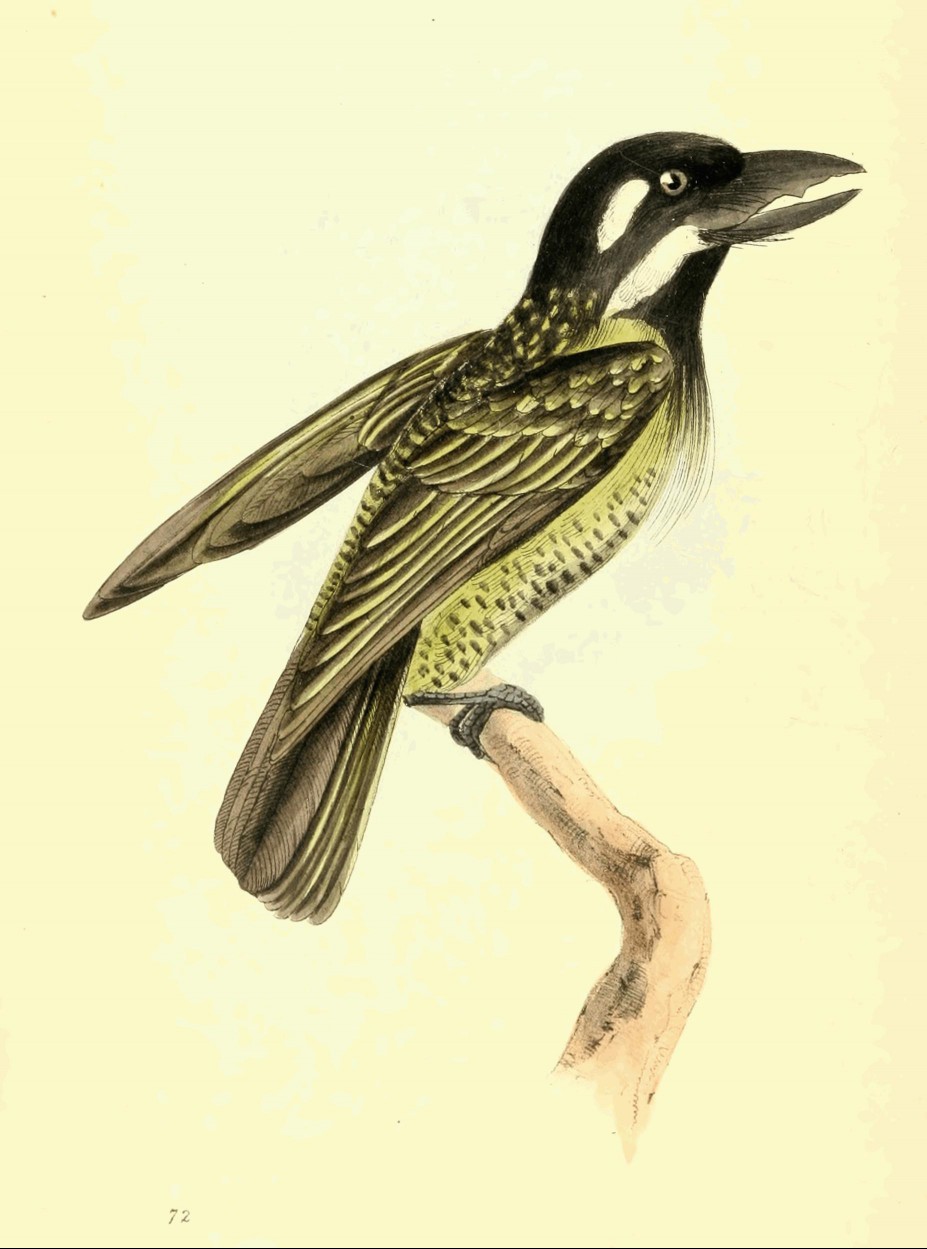
POGONIAS hirsutus,
Hairy-breasted Toothbill.
Generic Character.—See Pl. 68.
Specific Character.
P. supra fuscus, maculis sulphureis, subtus sulphureus maculis
nigris interstinctus, capite juguloque nigris; pectoris plumis elongatis,
pilis setaceis terminatis.Above brown, spotted with sulphur; beneath sulphureous, with black
spots; head and chin black; feathers of the breast lengthened, and ending
in long setaceous hairs.
I have before observed, that this genus of birds was first
characterized under the name of Pogonias, by Illiger, in 1811;
some years after (1815), M. Vieillot changed the name to Pogonia,
without taking any notice of Illiger's denomination, and Dr. Leach has
followed Vieillot without probably being aware of the plagiarism;
Vieillot's name must, however, be expunged, as Mr. Brown has some time
back affixed the name of Pogonia to a remarkable genus of
plants.
Total length about seven inches; bill blueish black, one inch two
lines long, and large in proportion; the tooth in the middle very
prominent; behind the eye is a short white stripe, and another much
longer begins from the under mandible, and goes half way down the neck;
the chin and part of the throat, together with the head and neck above,
deep black, which changes to a dark brown on the back, wings, covers, and
tail; a small round sulphur spot is on the tip of each feather of the
hind head, back, and lesser wing covers; the quills pale brown, margined
with sulphur; the under plumage is greenish sulphur, closely spotted with
blackish; the most extraordinary peculiarity of this bird consists in the
feathers of the breast, which are more rigid than the others, pointed,
and the shaft of the lower ones ending in fine incurved setaceous hairs,
many of which are near an inch long. The probable use this particular
formation is intended for, it is impossible to conjecture.
Mr. B. Leadbeater, to whom I am often obliged for the inspection of
rare subjects, received this from Africa, and it is the only individual
of the species I ever heard of.
Pl. 73
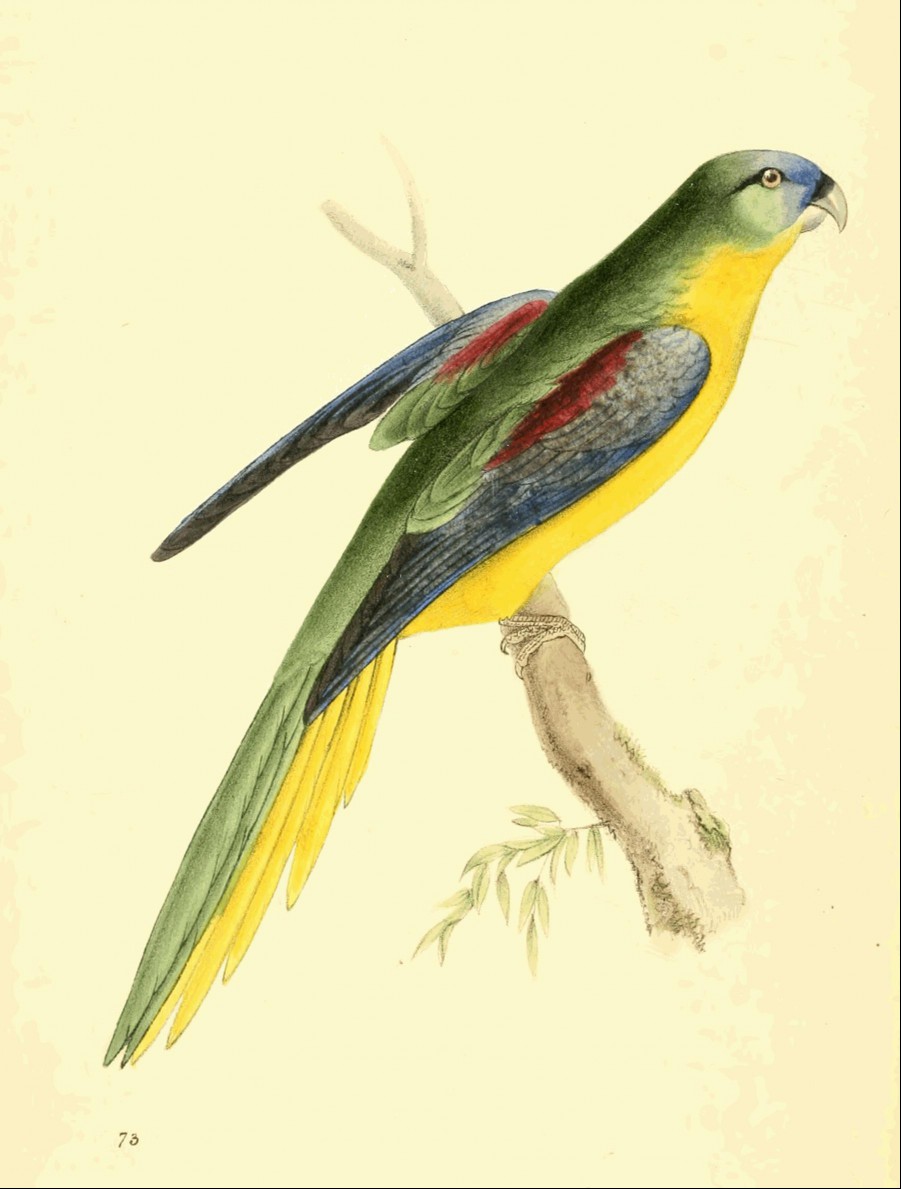
PSITTACUS pulchellus,
Turcosine Parrakeet.
Generic Character.—See Pl. 1.
Specific Character.
P. macrourus, suprà viridis, subtùs fulvus; sincipite, genis,
tegminibusque cyaneis, remigibus cæruleis; rectricibus lateralibus
fulvis.Long-tailed Parrakeet, green above; yellow beneath; forepart of the
head, cheeks, and wing covers light blue; quills deep blue; lateral tail
feathers yellow.Shaw, Naturalist's Misc. 3. pl. 96. Latham,
Suppl. 2. p. 88. no. 14.La Perruche Edwards, Le Vaillant, pl. 68. (female).
Gen. Zool. 8, 470.
It is impossible to represent this superbly coloured little creature
in its full beauty, though the figure will not be found very defective.
The only representation of the male is in the Naturalist's Miscellany,
where it cannot be recognized, and Le Vaillant's is of the female, which
differs considerably from the other sex. It is a rare species, and
peculiar to New Holland.
Length nine inches, with the tail, which is near four inches and a
half; the upper part of the plumage olive green, not so bright as is
usual in this tribe; the front of the head is a most brilliant turcosine
blue, which spreads on the cheeks, nearly to the ears, and then mixes
with the green; the shoulders and lesser wing covers of the same colour,
graduating to a deep mazarine blue on the greater covers, spurious wings,
and quill feathers, which latter are all deep black beneath, as well as
on their interior shafts; at the base of the shoulders is a large
irregular patch of dull red, partially hid by the scapulars; the under
plumage is yellow, tinged with olive on the throat and breast, and
verging towards orange on the belly; tail feathers narrow and pointed,
mostly green, with the inner shafts blueish, and margined with black; the
three outer on each side nearly yellow, the next tipt only with that
colour; under the wings brilliant blue, the greater covers and quills
deep black; bill very small; upper mandible without a notch, and
blackish; lower very convex, and, with the legs, flesh colour.
The female figured by Le Vaillant is much less brilliant in all its
colours, and without the red mark on the shoulders.
Pl. 74
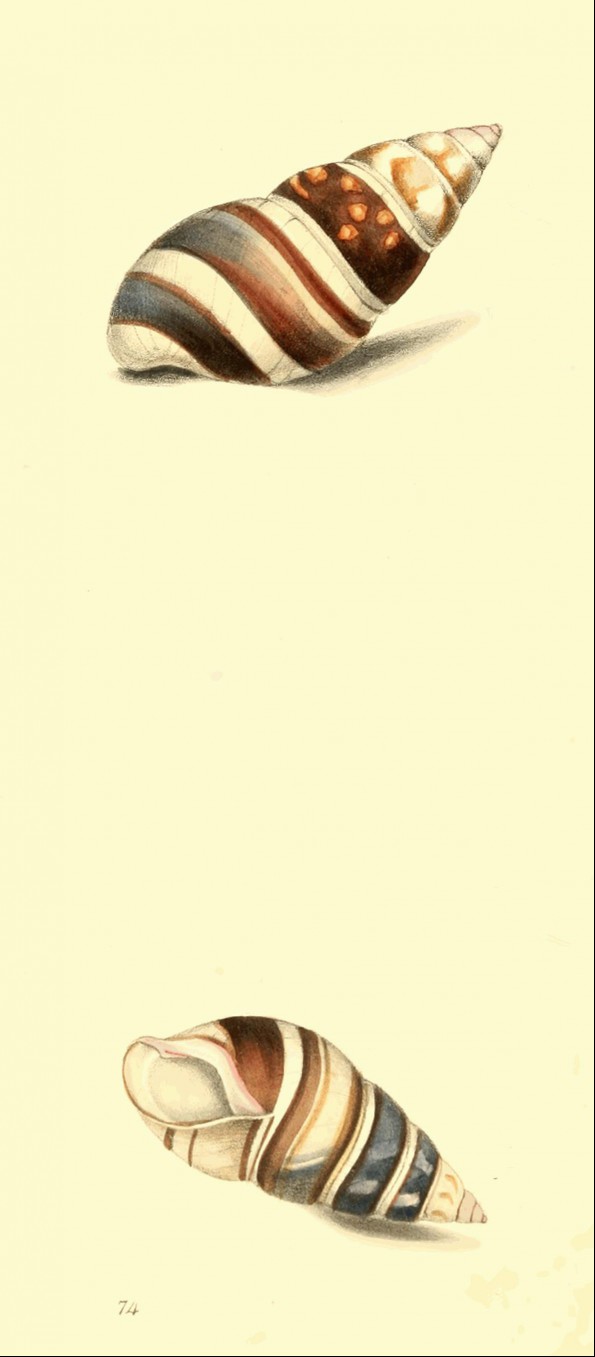
ACHATINA fasciata,
Chesnut-banded Achatina.
Generic Character.—See Pl. 30.
Specific Character.
A. testâ albâ fasciis latis lineisque castaneis ornatâ; spirâ
elongatâ, crassescente; labio interiore semi-circulari, intus depresso;
columellâ truncatâ, emarginatâ.Shell white, with broad chesnut bands and lines; spire elongated,
thickened; inner lip semi-circular, depressed within; columella
truncated, emarginate.Bulla fasciata. Gmelin 3430, 25. Martini 9. tab.
117, 1004 to 6.Lister 12, 7. Seba, tab. 39. fig. 62 to
74. Gualtieri, tab. 6. fig. C.
Having figured two or three species allied to this shell, it appears
advisable to subjoin a more particular notice of it, and to point out
those characters by which it may be detected through its numerous
variations: this has been endeavoured in the specific character now
formed, and appears to rest principally on the inner lip, which is always
semicircular, down which, if closely examined inside, there is a
depression as if it had been pared down with a knife; the base of the
pillar also is so strongly truncated as to appear notched, and the
broadest part of the mouth is always in the middle; these characters have
been very ill attended to in all the figures above quoted, of which Seba
gives no less than eleven, which vary only in the disposition and number
of their bands.
Gualtieri's figure at tab. 6. fig. D, is an admirable
representation of A. pallida, which, not having his work before me
at the time, I could not quote; the other at C is a very good one of the
present shell. The upper drawing is from one in my own cabinet; the lower
is in the possession of Mr. C. Dubois, who is continually adding to his
fine and valuable collection.
It is almost unnecessary to contradict the opinion of some writers who
have fancied this a fresh-water shell. It is not uncommon, but
seldom seen in perfection.
Pl. 75
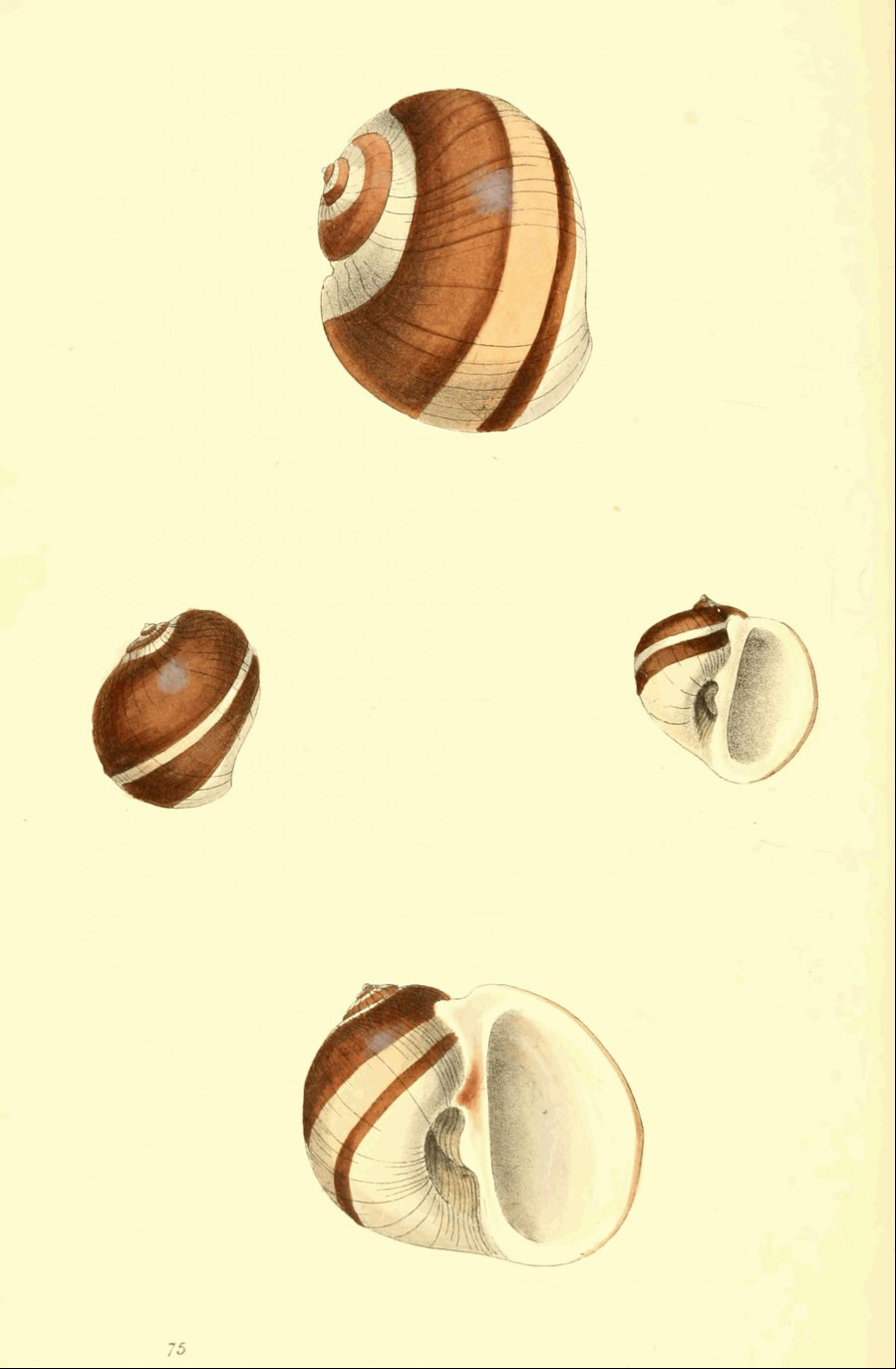
NATICA spadicea,
Banded Natica.
Generic Character.
Testa subglobosa seu ovalis, umbilicata. Spira depressa,
brevissima. Columella umbilici medio terminans. Apertura semiorbicularis,
operculo corneo vel testaceo clausa. Animal marinum, pede maximo; oculis
ad basin duorum tentaculorum simplicium positis.
Typus Genericus Nerita Glaucina Pennant.
Shell nearly globose, or oval, umbilicated. Spire depressed, very
small. Columella terminating in the middle of the umbilicus. Aperture
semi-circular, operculum either horny or testaceous. Animal marine, with
a large foot; the eyes placed at the base of two simple tentacula.
Generic Type Nerita Glaucina Pennant, &c.
Specific Character.
N. testâ sub-globosâ, fuscâ, albo fulvoque fasciatâ, juxta suturam
striatâ; labio exteriore suprà leviter emarginato; umbilico magno,
aperto; columellâ obsoletè terminante.Shell sub-globose, striated near the suture, brown, banded with white
and fulvous; outer lip above slightly emarginate; umbilicus large, open;
pillar termination nearly obsolete.Martini 5. pl. 187. fig. 1872 & 3.
fig. 1874 & 5? pl. 188. fig. 1896, 8
& 9.Seba, pl. 38. fig. 66. pl. 41. fig.
14, 15.
The Shells of this genus are composed of such of the Linnæan
Nerits as are umbilicated, from which latter they essentially
differ, both in the organization of the animal and the construction of
the shell, which is either closed by a shelly or horny operculum.
The species are numerous, and are found both in temperate and tropical
seas; two or three inhabit our own coasts, but by far the greater number
are found in the Asiatic Ocean. They are subject to variation in their
colour; and this, joined with a general resemblance in form, has rendered
the discrimination of the species very difficult. I have, however,
remarked, that the various modifications of the umbilicus, and the
termination of the pillar (which is indicated in many species by an
elevated ridge or rib within the umbilicus) is a certain and constant
indication, presenting the same peculiarity through all the individuals
of a species, even in the young state. This termination of the pillar has
been mistaken for the inner lip, which, on the contrary, is always above
the umbilicus, which, if closed, is not closed by the lip, but by the
thickened termination of the pillar or columella.
The two most striking varieties are here figured of this species,
which is sufficiently described in the specific character. I believe it
is found both in the Mediterranean and Red Seas.
Pl. 76

MEROPS Savignii,
Black-capped Bee-eater.
Generic Character.—See Pl. 8.
Specific Character.
M. viridis, subtus albescens, uropygio caudâque cæruleis; vertice,
strigâ oculari, fasciâque latâ collari nigris; mento, superciliisque
albis; rectricibus mediis elongatis.Green; beneath whitish; rump and tail blue; crown of the head, eye
stripe, and broad band across the neck, black; chin and eye-brows white;
two middle tail feathers lengthened.
This Bird was pointed out to me by Professor Temminck as described by
Le Vaillant in his work on this family, under the name here given; on
this authority, therefore, I have been obliged to rest, for I have in
vain turned over the catalogues of all the public libraries in the
metropolis, in the hope of seeing the work, and ascertaining the fact.
The book is modern, and, though expensive, one of standard excellence;
but a princely fortune is necessary to purchase such a library as a
student should have access to.
Total length eight inches and a half; size rather less than the common
bee-eater; the crown in young birds is greenish, in some a dull brown,
and in others deep black, margined in the front and sides of the head
with a line of white; the ears black, uniting to a broad band across the
neck of the same colour, which is margined on the lower part with
beautiful sea blue; the nape of the neck, inner covers, and quill
feathers, greenish fawn colour; the lesser quills tipt with black; the
rump, tail, and outside of the quills next the body changeable greenish
blue; the back and upper covers green beneath; the chin is white; the
body tinged with greenish, and the under tail covers with blue: the tail
three inches long, and in such specimens as have the two middle feathers
lengthened, three and a half; bill and feet black.
Inhabits Sierra Leone, and other parts of Africa.
Pl. 77
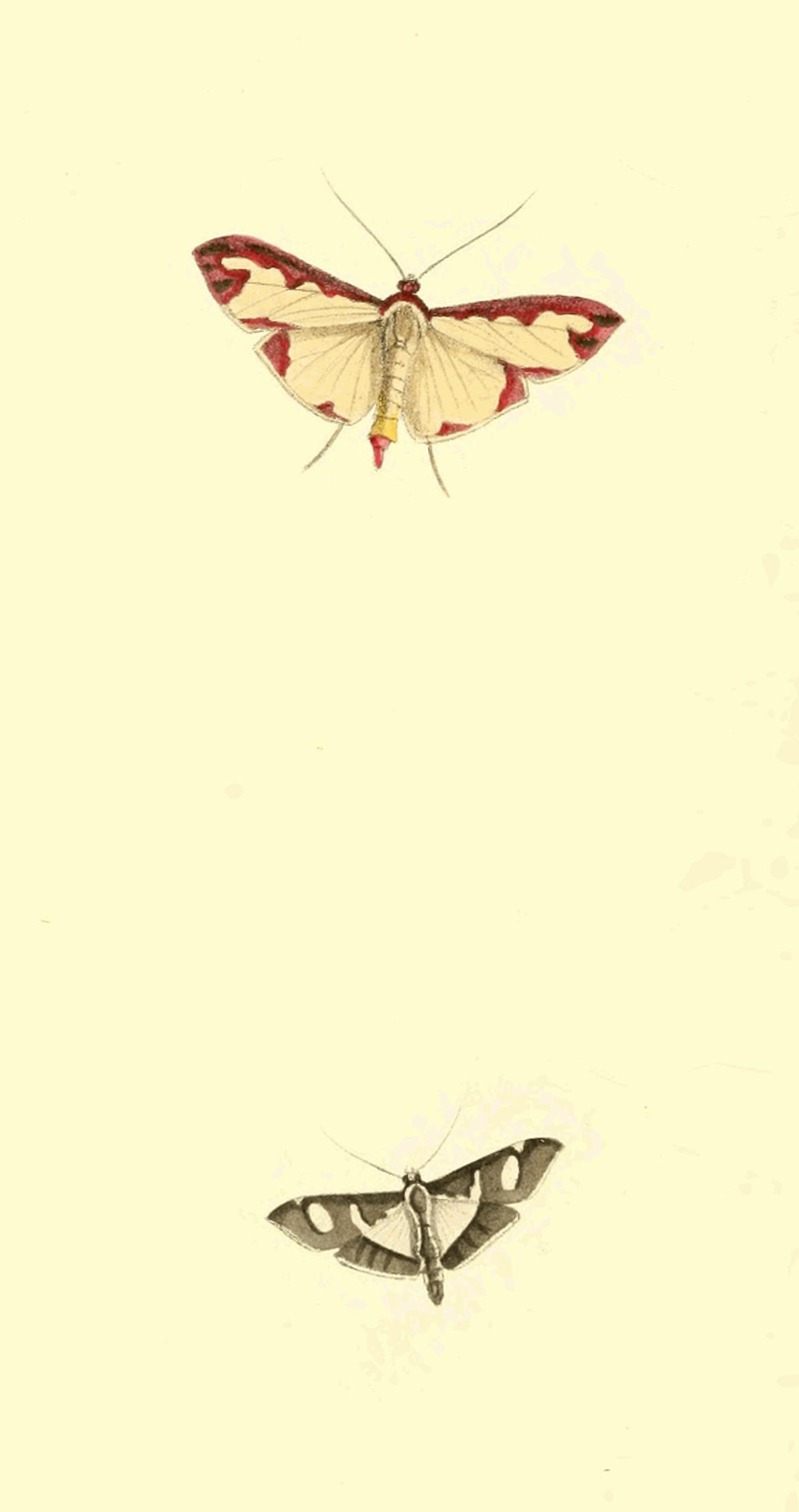
BOTIS,
Gauze-wing.
Generic Character.
Antennæ setaceæ. Alæ trigonæ, insecto sedente, cum corpore
triangulum subhorizontale efficientes, superiores margine externo recto.
Palpi quatuor exserti. Lingua conspicua. Latreille, Gen. Ins.
4. p. 229.
Typus Genericus Ph. Urticata Lin. &c.
Antennæ setaceous. Wings trigonal, forming a nearly horizontal angle
with the body when the insect is at rest. The outer margin of the
anterior wings straight. Palpi four, exserted. Tongue conspicuous.
Generic Type Ph. Urticata Lin. &c.
Botys. Latreille.
BOTIS marginata,
Pink-margined Gauze-wing.
B. alis hyalinis, stramineis, apicibus margineque flexuoso
rubro-purpureis.Wings hyaline; pale fulvous; the margins and tips with a waved reddish
purple border.P. Marginata. Cramer, pl. 400. I.—P. Simiata.
Fab. Ent. Sys. 3. 208.
There appears no end to the immense number of species referrible to
this genus, which will perhaps be found the most extensive tropical group
of all the Linnæan Phalænidæ. Of these, near eighty species I
found in Brazil; Dr. Horsfield has brought a great many from Java; near
fifty are found in North America, and I have little doubt that the whole
number existing in the cabinets which I have inspected may amount to
about three hundred and fifty. The thorough investigation of these is a
work of no ordinary labour; and, until this is done, it appears most
advisable to let the generic distinction remain, as given by Latreille,
though there can be no doubt that among them distinct groups will be
detected.
Cramer's figure will not indicate even the genus, and Fabricius
describes the body as white; the tip ferruginous; in this it is yellow,
tipped with red.
Mr. Haworth obliged me with this insect, which Fabricius notes as
African.
BOTIS bicolor,
Black and White Gauze-wing.
B. alis anticis fuscis, punctis duabus angulatis transversis albis;
posticis ad basin albis.Anterior wings, brown, with two transverse angulated white spots;
posterior white at the base.
From the same collection as the preceding; the margin of the thorax
and body are white. I apprehend it is an American species, which is
distinct from any figured by Cramer, the principal author on the Exotic
Lepidoptera.
Pl. 78
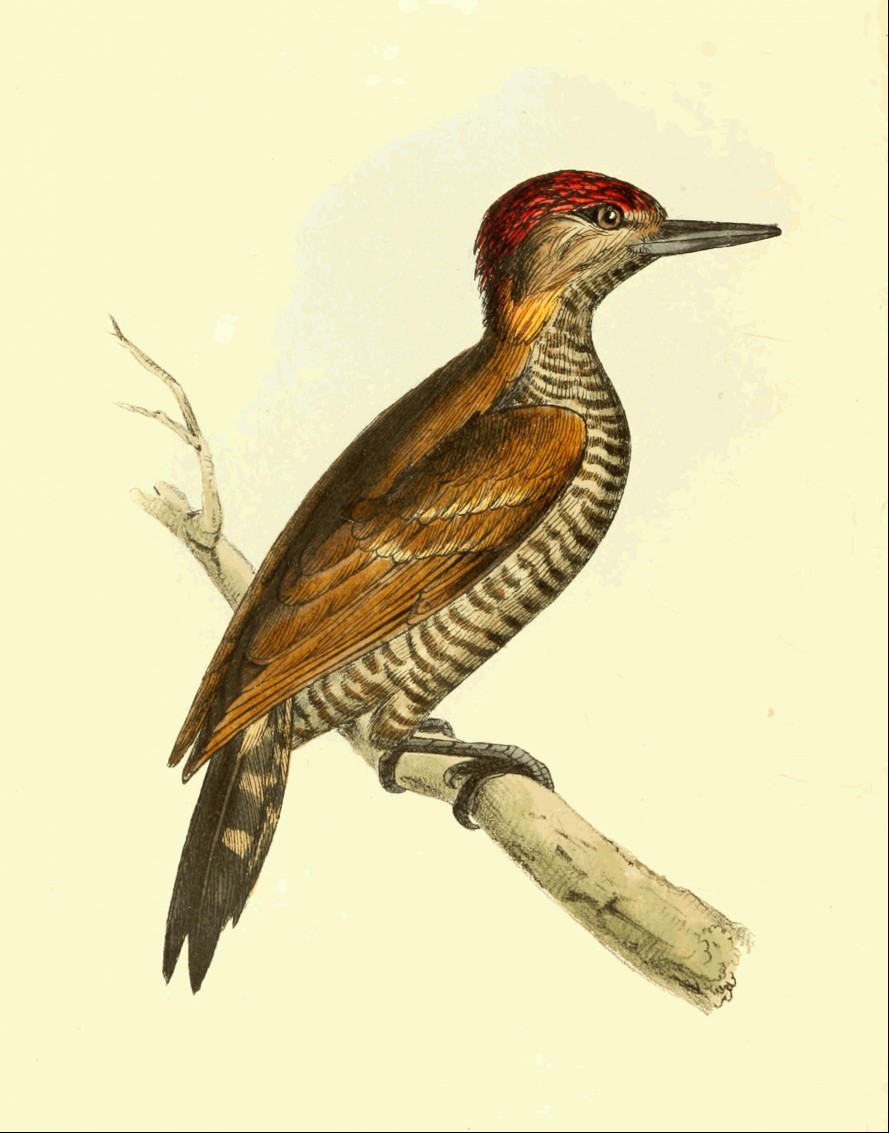
PICUS affinis,
Golden-naped Woodpecker.
Generic Character.—See Pl. 14.
Specific Character.
P. supra aureo-fuscus, subtus pallidus, fasciis nigris transversis
ornatus; capite (in maribus) rubro; nuchâ colloque supra aureis;
tectricibus secundis fulvo maculatis; caudâ nigrâ, fasciis fulvis
ornatâ.Above, orange brown; beneath, pale, with transverse black stripes;
head (in the male) red; nape and neck, above, golden yellow; lesser wing
covers with yellowish spots; tail black, with yellowish bands.
Ornithologists have either entirely overlooked this bird, or have
slightly noticed it as a variety of Picus icterocephalus, the
golden-headed Woodpecker, from which it is nevertheless quite
distinct.
Total length near seven inches; bill blackish horn colour, and one
inch long from the gape; the feathers on the upper part of the head are
short and pointed; the tips bright red; the base black; on the hind head
they are longer, and change to a bright golden yellow, which spreads
round the nape; the ear feathers and front of the head are greyish brown,
striped down the middle with whitish, and in some there is an appearance
of a whitish line over the eye, joining the nape. The upper parts of the
body and wings are of a rich golden brown, with indistinct brighter
spots; the lesser wing covers have a whitish spot at the top of each,
forming two bands; quills on the inner shaft black, with white spots.
Under plumage grey, tinged on the breast with rufous, and banded with
brownish black; tail short, black, with interrupted transverse bands of
obscure olive.
The female has the head blackish, the feathers tipt with dull white;
the ears darker; the plumage above more olive, the spots brighter, and
the bands on the body grey, paler, and more indistinct than in the male.
The feet in both sexes are greenish, and the wings three inches and a
half long.
It inhabits Brasil, but is not common; I found it both in the Province
of Bahia, and that of Rio de Janeiro.
Pl. 79
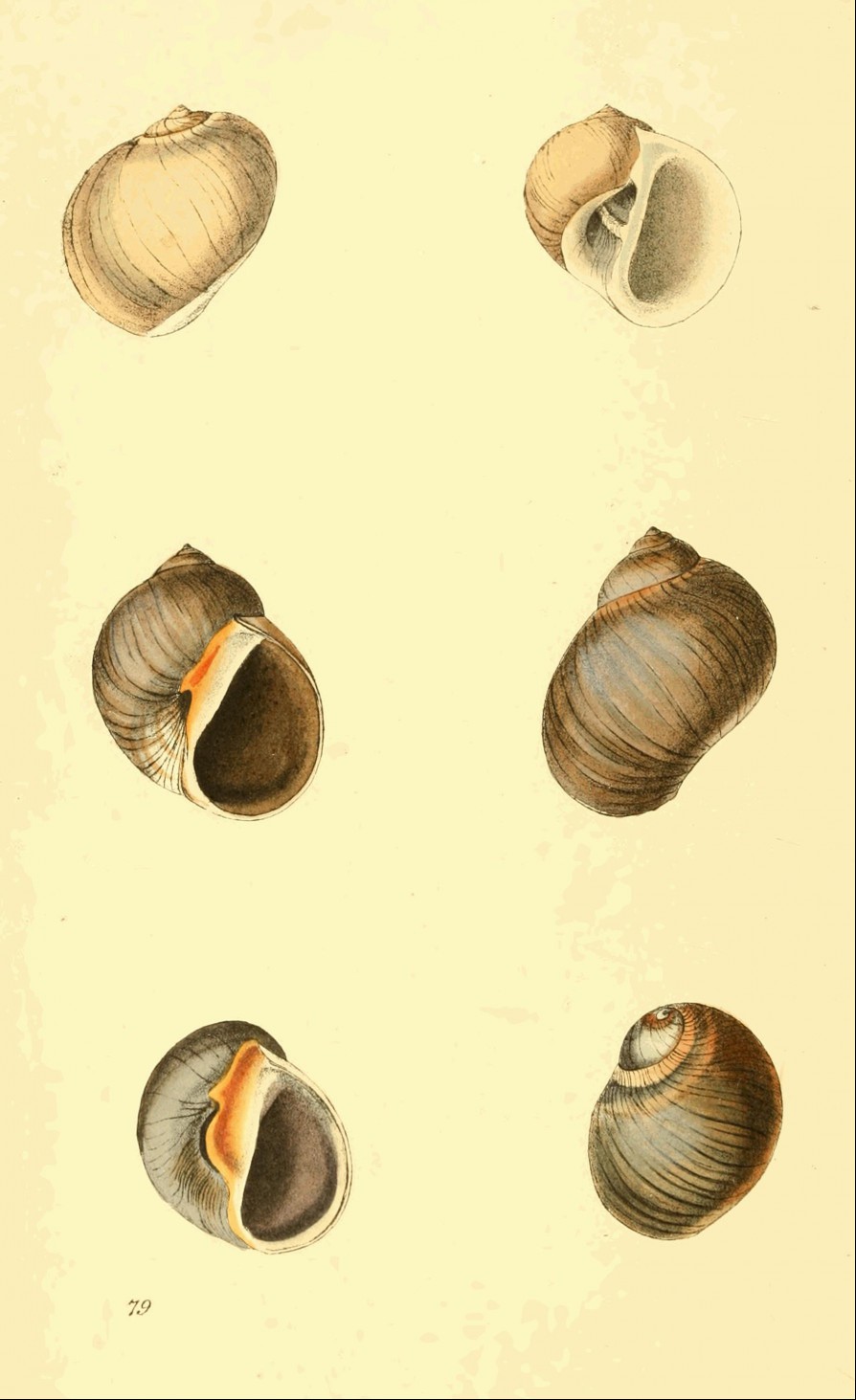
NATICA mustelina,
Belted Natica—upper figures.
Generic Character.—See Pl. 75.
Specific Character.
N. testâ subglobosâ, mustelinâ concolore, obsoletè rugatâ, fasciâ
levatâ basin cingente; spirâ depressâ, apice acuto; umbilico magno,
aperto; columellæ basi gracili, levatâ.Shell sub-globose, uniform, fulvous-brown, obsoletely wrinkled, base
with an elevated belt; spire depressed, the tip acute; umbilicus large,
open; pillar termination slender, elevated, and central.
The elevated belt at the base affords an excellent distinction to this
species. The specimen in my cabinet is the only one I have seen. Locality
unknown.
NATICA sordida,
Brown Natica—middle figures.
N. testâ subglobosâ, fused, spirâ prominente; aperturâ intus
fusco-purpureâ; umbilico parvo, labio interiore paululùm tecto; columellâ
obsoletè terminante.Shell sub-globose, brown; spire prominent; aperture within purplish
brown; umbilicus small, partially covered by the inner lip; pillar
termination obsolete.
This Shell is both undescribed and apparently unfigured; the spire is
more elevated than usual; the umbilicus small; and the termination of the
pillar not seen: it is not uncommon, and is often much larger than here
represented, but I am unacquainted with its locality. The little decision
in the figures given by authors of these shells, renders it hazardous to
quote them with certainty.
NATICA melastoma,
Black-mouthed Natica—lower figures.
N. testâ depressâ, fuscâ; spirâ complanatâ minimâ; ore intus
atro-purpureo; umbilico magno, clauso labio interiore rufo.Shell depressed, brown; spire flattened, very small; mouth within
purplish black; umbilicus large, closed up by the inner lip, which is
rufous.
In colour this bears a close resemblance to the last, but the shell is
flattened beneath, and the spire very short and depressed; the umbilicus
large, but, in general, quite closed up by the thickness of the pillar,
united to the inner lip. In some specimens a narrow crescent-shaped
groove is left on the outside margin. Its habitat is unknown.
Pl. 80
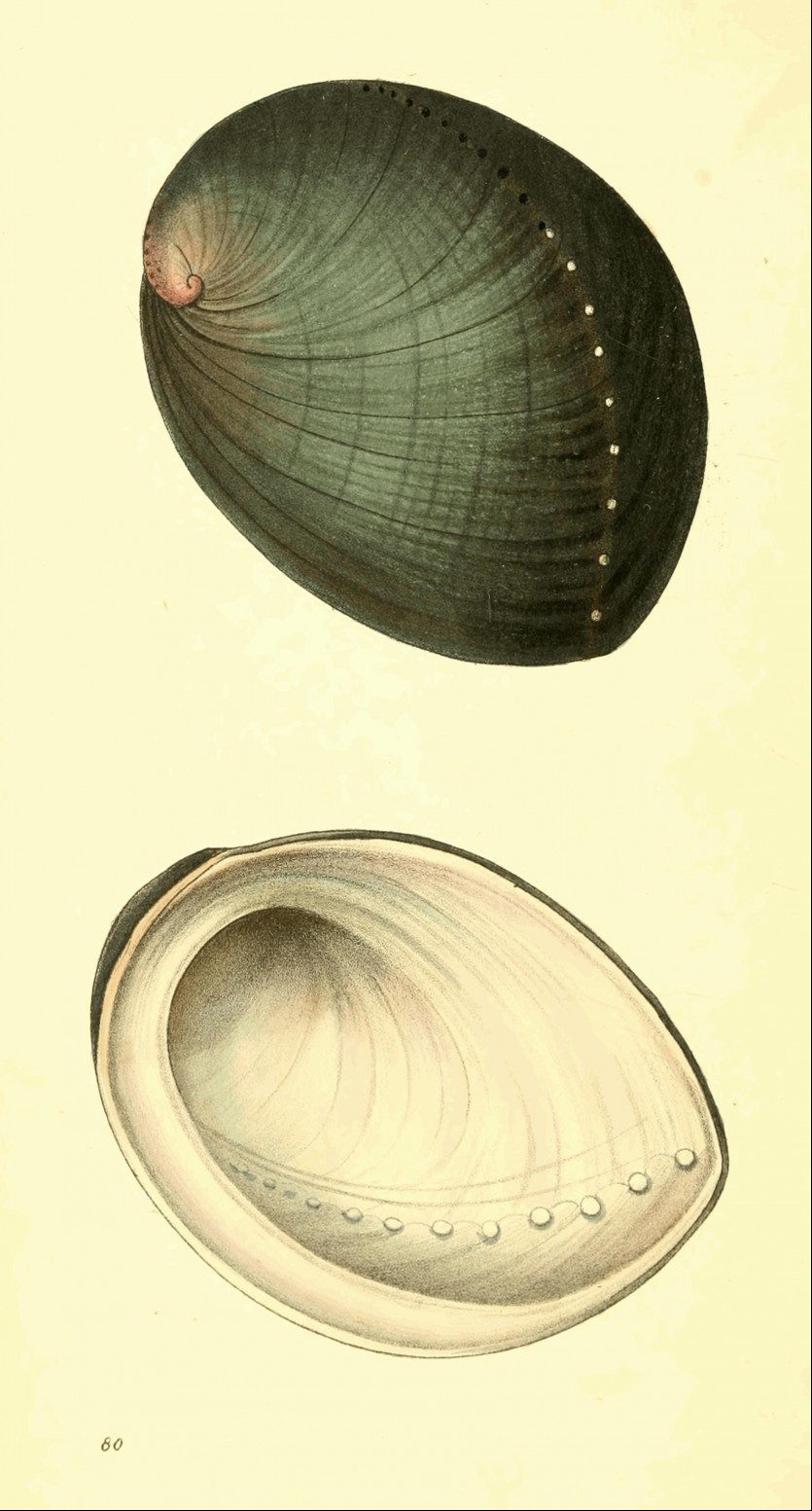
HALIOTIS Californiensis,
Small-holed Californian Ear-shell.
Generic Character.
Testa univalvis, depressissima, lata, auriformis. Discus admodum
perforatus. Spira minuta, depressa. Apertura testam magnitudine penè
æquans, intus margaritifera.
Typus Genericus H. Tuberculata Linn. &c.
Shell univalve, greatly depressed, broad, ear-shaped, the disk with
many perforations. Spire minute, depressed. Aperture nearly as large as
the shell; inside pearly.
Generic Type H. Tuberculata Linn. &c.
Specific Character.
H. Testâ ovali, lævi, obscurè thalassinâ; labio exteriore supra
immarginato, interiore lato, complanato, foraminibus numerosis, minutis,
orbicularibus, lævibus.Shell ovate, smooth, obscure sea green; outer lip above immarginate;
inner lip broad, flat; perforations numerous, very small, orbicular and
smooth.
The Ear-shells are strangely characterized by their peculiarity of
form, perforated holes, and rich pearly interior. They are found in both
temperate and tropical seas; but the definitions hitherto given by
conchologists are so imperfect, that they have left our knowledge of
these shells nearly the same now, as in the time of Linnæus. Seventeen
species only are enumerated in Mr. Dillwyn's work; although thirty-four
have fallen within my own observation the last few months.
The difference between this and the common black Californian Ear,
consists in its being a much deeper and smoother shell, always narrowest
at the base, the outer lip not having (as in that) a prominent curve or
gibbosity where it joins the spire; but principally in the perforations,
which in this are always half as large, and doubly numerous; it is also
generally a much smaller, and less common species: the spire is always
deeply tinged with pink. The genus Padollus, of Montford, resting
entirely in the unevenness of the outer lip, without any knowledge of the
animal, appears to me an unnecessary distinction, for such is the
character of all young shells, and also of mature ones, whose outer
surface is rugged or uneven.
Pl. 81
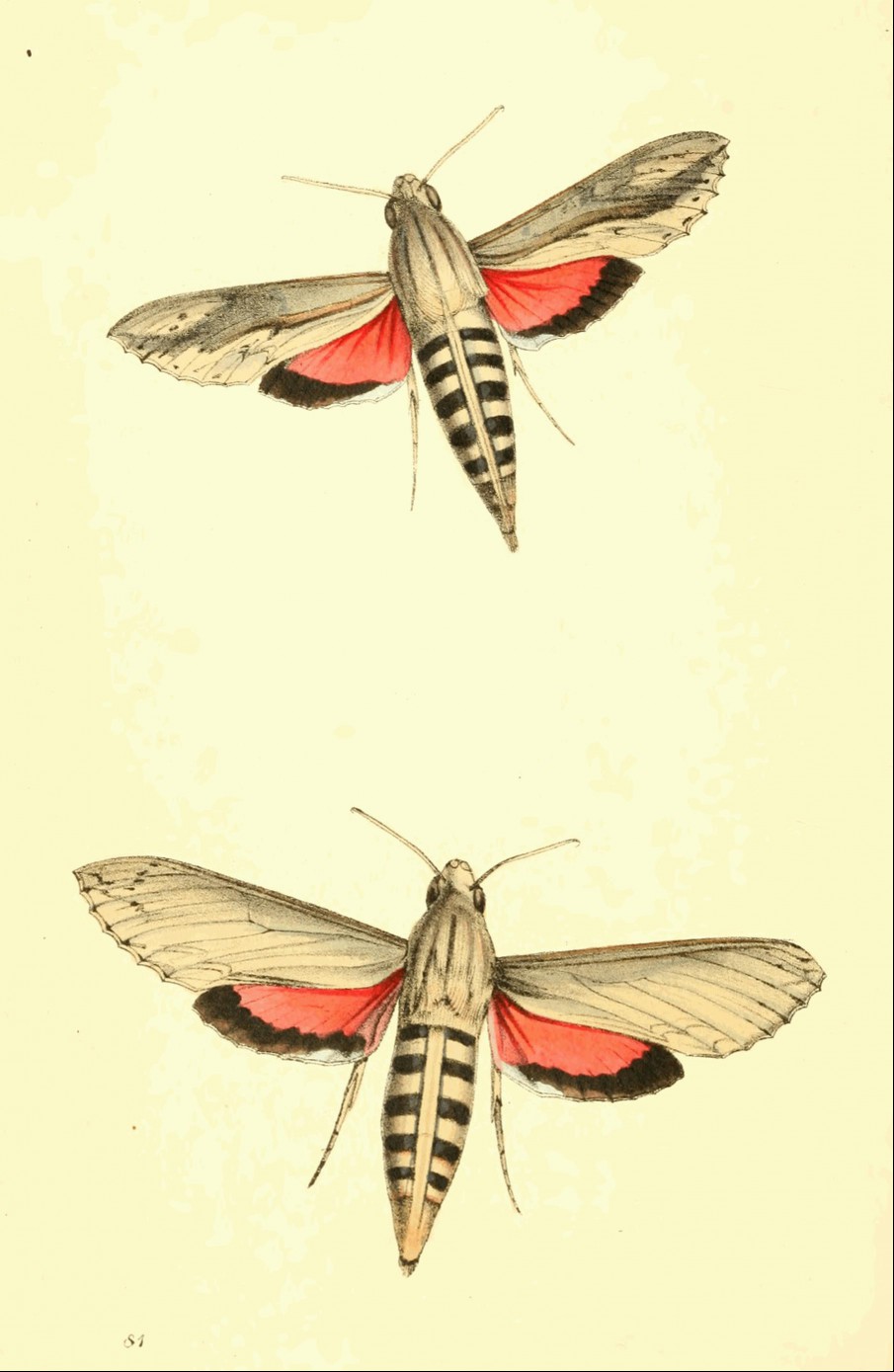
SPHINX Ello.
Generic Character.
Antennæ prismaticæ, in utroque sexu ad medium leviter
crassescentes, externè breviter piloso baciliatæ, mucrone arcuato,
producto, sensim terminantes. Palpi breves, obtusi. Lingua elongata,
convoluta, distincta, et in pupâ aliquando porrecta. Alæ sub-integræ.
Abdomen elongatum, conicum, ano acuto, imberbi.
Typus Genericus Sphinx Convolvuli Linn.
Antennæ three sided, in both sexes slightly thickened in the middle,
externally ciliated with double tufts of short hairs, and ending in a
gradually lengthened arcuated hook. Palpi short, obtuse. Tongue long,
convolute, distinct, sometimes porrected in the pupa state. Wings nearly
entire. Abdomen lengthened, conic; the tip pointed, and not bearded.
Generic Type Sphinx Convolvuli Linn.
Specific Character.
S. alis subdentatis, cinereis (in maribus lineis fuscis variatis);
posticis rufis, margine nigro; abdomine pallido, cingulis atris
circumdato.Wings slightly dentated, cinereous (in the male variegated with brown
lines); posterior rufous, with a black margin; abdomen pale, with black
belts.Gmelin 5. 2375. 13. Fab. Ent. Sys. 3. 362. no.
21. S. Ello. Drury, vol. i. p. 59. pl. 27. fig. 3.
(male.) Cramer, pl. 301. D.
It is in all things better to understand few subjects well than many
imperfectly; knowledge may be extensive, but it cannot be sound, if it is
at the same time imperfect; and, applying this observation to the present
article, it becomes as desirable, where necessary, to illustrate an
insect known to Linnæus, as to regard only the accession of new
species.
The two insects figured were received from Jamaica by my friend Dr.
Leach, and there can be no doubt they are the sexes of one species. The
upper is a male, and agrees with Drury's figure and description; the
lower insect is a female, of which no representation has been published:
as for Cramer's figure, if intended for the former, it is really so bad
that it can hardly be quoted as an authority, and it appears to have
misled Fabricius, in thinking that the female insect had a brown stripe
on the anterior wings, whereas that character is more applicable to the
male.
The insects I propose retaining under this genus are such as have the
body lengthened, pointed, and not bearded at the tip; the antennæ but
slightly thickened in the middle, and the terminating hook gradual,
arched, and not very acute: these comprehend the first section of
Latreille's genus, Sphinx, and are by him again divided into two
groups, the one having the wings entire, the other angulated.
Pl. 82
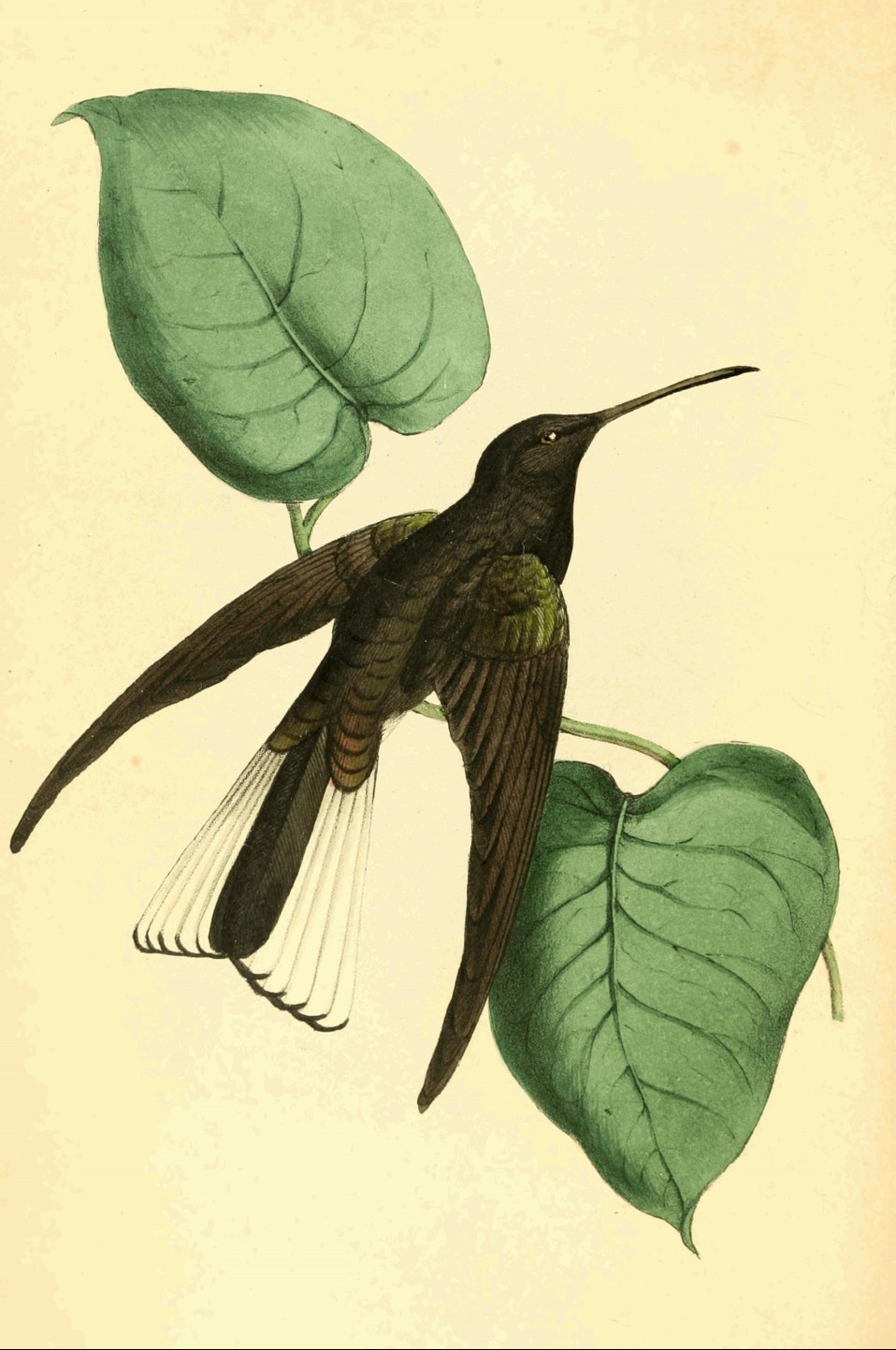
TROCHILUS niger,
Black Humming Bird.
Generic Character.
Rostrum elongatum, rectum vel arcuatum, flexile, gracillimum, ad
basin depressum, mandibulâ superiore inferiorem amplectente et tantùm non
obtegente. Lingua jaculatoria, bifida, tubulata. Nares basales, membranâ
tectæ, aperturâ in longum fissâ. Pedes sedentes, minimi. Alæ longissimæ,
subarcuatæ, remigibus prioribus longissimis, cæteris gradatim
brevioribus.
Typus Genericus T. Moschitus Linn.
Bill long, straight or curved, flexible, very slender, the base
depressed, the upper mandible folding over, and almost covering the
lower. Tongue long, extensible, bifid, and tubular. Nostrils basal,
covered by a membrane, and opening by a long slit. Feet sitting, very
small. Wings very long, curved, the outer quill longest, the rest
gradually becoming shorter.
Generic Type Ruby-crested Humming Bird Lath.
Specific Character.
T. niger; auribus aliquando rufis; tectricibus, caudâ uropygioque
colore subviridi nitidis; rectricium lateralium nivearum apicibus colore
chalybeio tinctis.Black; the ears sometimes rufous; wing covers tail and rump glossed
with green; lateral tail feathers snowy, tipt with steel blue.
Like the resplendent jewels of the earth, the Humming Birds are the
living gems of the air. United to the most delicate form, these fairies
of creation have the dazzling effulgence of every tint that sparkles from
the ruby, the topaz, the sapphire, and the emerald, lavished on their
plumage; they seem created but for our admiration, to sport in the ardent
beams of a tropical sun, and to feast on the nectar of the sweetest
blossoms; and, like sparks of many coloured fire, they shoot from flower
to flower, exulting in their little life of brightness and pleasure.
To return, however, to that now before us, it should be observed, that
it is the only species whose plumage does not in any way accord with that
of the rest of its brethren. No author appears to have described it,
although I met with it very frequently in Brazil: a specimen in the
British Museum has the ears reddish brown, but this seldom occurs. The
figure is of the size of life. All the species are natives of tropical
America.
Pl. 83

TROCHILUS falcatus,
Sickle-winged Humming Bird.
Generic Character.—See Pl. 82.
Specific Character.
T. viridis, gulâ pectoreque nitidè cæruleis; corpore anoque
cæruleo-viridibus; rectricibus paribus, rufo-cinnamominis; remigibus
exterioribus falcatis, scapis dilatato compressis.Green; throat and breast shining blue; body and vent blue green; tail
even, rufous cinnamon; exterior quills falcated, the shafts dilated and
compressed.
Nothing can exceed the dazzling brilliancy of colours united in this
little creature. It is, however, more remarkable from the extraordinary
construction of its wings, the outer quills of which are greatly curved,
and the shafts dilated to a most disproportionate size; a similar
structure occurs also in the Broad-shafted H. B. of Dr. Shaw, (T.
latipennis.) That it is intended to fulfil some important office in
their economy, will admit of no doubt, for in wisdom are all things made;
conjecture must, however, in numberless instances, supply our want of
real knowledge; and it may not be improbable that such additional
strength in the wings has been given them as a defence against the small
birds of prey, (Lanii. Lin.) which abound in tropical
countries.
The figure is the size of life; bill curved from the base, with a
black stripe between that and the eye; plumage above deep shining green,
most brilliant on the sides of the neck; ear feathers blue green; chin
and throat of a most brilliant deep violet blue, changing in some lights
to purple, becoming greenish on the breast, and blended with the green of
the neck; all these feathers are disposed like scales; vent golden green,
with two tufts of downy white feathers round the thighs. Tail even, the
feathers broad and truncately rounded, of a rufous cinnamon colour, tipt
with a purple black bar; the middle feathers darkest, and glossed with
green.
Of this rare and unrecorded species, a fine example existed in Mr.
Bullock's Museum, which was purchased to enrich that of Paris: another,
more imperfect, was sent Mr. Falkner from the Spanish Main. The male of
T. latipennis is undescribed, Dr. Shaw having only seen the
female; both sexes, however, are in my possession. The plant introduced
in the plate (Clitoria Plumieri) is a native of Brazil.
Pl. 84
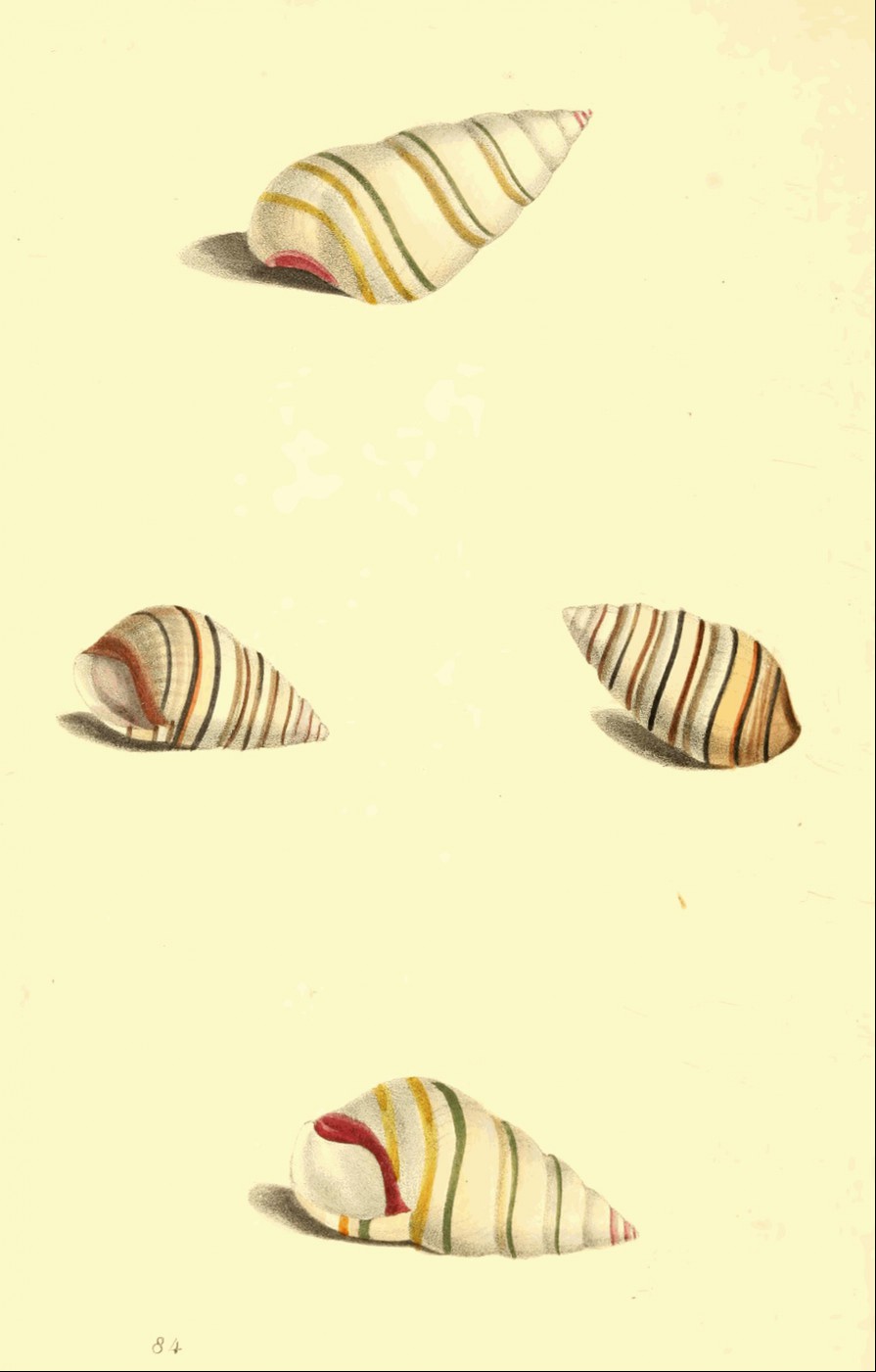
ACHATINA emarginata,
Notched Achatina.
Generic Character.—See Pl. 30.
Specific Character.
A. (div. 2.) testâ productâ, sub-flavâ, fasciis viridibus flavisque
ornatâ; aperturâ ovato-rotundatâ, albâ; labio exteriore medio inciso;
basi emarginatâ.Ach. (div. 2.) Shell elongated, cream colour, with green and yellow
bands; aperture ovately rounded, white; outer lip notched in the middle;
base emarginate.
A new and very delicate species, which may have been overlooked as a
variety of A. virginea, from which it differs in the comparative
length of the basal whorl, which in that is remarkably short, in being a
much more elongated shell, in the mouth being oval, but above all, in
having a conspicuous notch in the middle of the outer lip, where the
green band commences; the aperture (excepting the inner lip) is pure
white. It is in Mr. Dubois' possession, and its country unknown.
ACHATINA vittata,
Ribbon Achatina—middle figures.
A. (div. 2.) testâ ovato-oblongâ, crassâ, albente, vittis nigris
fuscisque angustis ornatâ; apertura ovatâ, sub-contractâ; columellâ
tantùm non rectâ; basi subtruncatâ.A. (div. 2.) Shell ovate-elongated, thickened, fulvous white, with
narrow black and brown bands; aperture oval, slightly contracted; pillar
nearly straight; base sub-truncated.Gualtieri, tab. 6. fig. A.
Although unnamed, this shell is obviously the same as that figured by
Gualtieri, who also describes it very tolerably. This figure, however, is
quoted by Gmelin and others for A. virginea; from which shell it
is quite distinct: it is a thickly formed shell, the base slightly
truncated, and the aperture very narrow, and reddish brown; the outer lip
within is thickened. From the same collection as the last.
Pl. 85
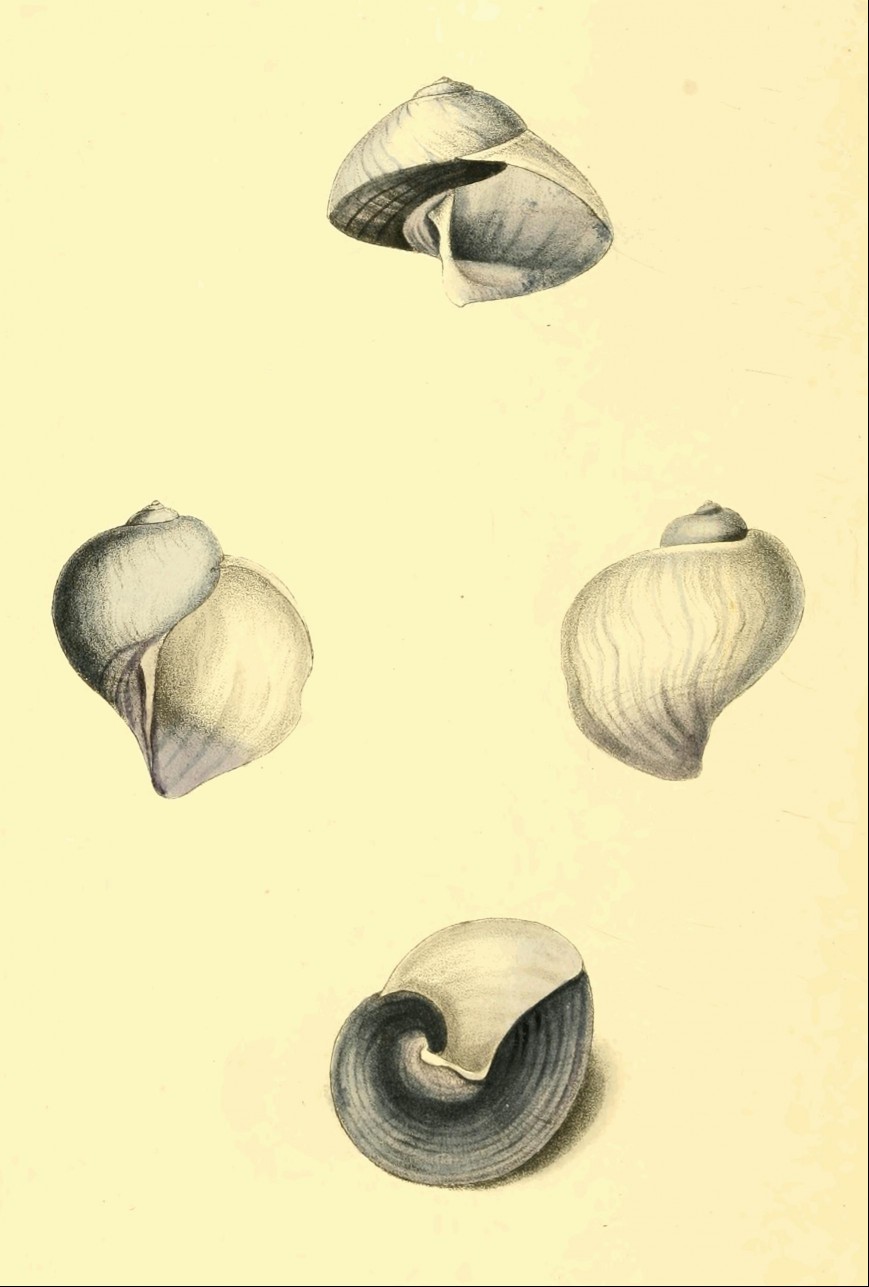
IANTHINA fragilis,
Common Oceanic Snail—upper and lower figures.
Generic Character.
Testa subglobosa, tenuis, fragilis. Spira depressa. Labium exterius
medio emarginatum. Columella ultra aperturæ basin producta. Animal
marinum, vesiculâ solidâ pede suppositâ instructum.—Cuvier.Shell subglobose, thin, brittle. Spire depressed. Outer lip notched in
the middle. Base of the pillar projecting beyond the aperture. Animal
marine, with a solid vesicle, placed under the
foot.—Cuvier.
Specific Character.
I. testâ pallidâ, anfractu basali angulato; basi complanatâ,
striatâ, violaceâ; aperturâ latiore quam longiore; labio exteriore
profundè emarginato.Shell pale; body whirl angulated; the base flattened, striated and
deep violet; aperture broader than long; outer lip deeply emarginate.Helix Ianthina. Gm. 3645. Lister. 572. fig. 23.
24. Turton. C. D. p. 58. Gualt. tab. 64. 0.
Mart. v. t. 166. fig. 1577.-8?Ianthina fragilis. Bruguiere. Ency. Meth. pl. 456.
fig. 1. a. b.
The singular shells of this genus float on the surface of the ocean,
where they principally live. Gmelin remarks that the animal emits a
phosphoric light; and Captain Cook observed that it is oviparous, and
discharged, on being touched, a liquor of the most beautiful purple. Dr.
Turton and Mr. Dillwyn have recorded several British localities for this
shell; and the former notes having seen it alive, but without giving any
original account of the animal. The extreme brittleness of the shell is
such, that, although common, it is very rarely seen so perfect as here
represented, from shells in my own cabinet. All the figures I have seen
are very defective.
IANTHINA globosa.
Globular Oceanic Snail—middle figures.
I. testâ ventricosâ, basi productâ; aperturâ longiore quam latiore;
labio exteriore leviter emarginato.Shell ventricose, the base lengthened; aperture longer than broad;
outer lip slightly emarginate.
The notch, which in I. fragilis extends the whole length of the
lip, in this, is very slight, and nearly central. Mr. Dubois has enabled
me to figure it from specimens in the greatest perfection; it is much
less common than the last.
Pl. 86

CONUS Princeps,
Prince Cone.
Generic Character.—See Pl. 65.
Specific Character.
C. conicus, coronatus, roseus; lineis fusco-purpureis
longitudinalibus subramosis; spirâ convexâ.—Lamarck.Coronated Cone, rosy, with brownish purple longitudinal lines, which
are sometimes branched; spire convex.—Lamarck.Conus Princeps. Gmelin. 3378. (omitting var. β and γ.)
Turton. 4. 313. (omitting var. 2. and 3.)Conus regius. Martini, vol. x. pl. 138. fig.
1276. Brug. no. 12. Ency. Meth. pl. 318.
fig. 3. Lamarck, Ann. du Mus. p. 31. no. 10.
The Cones are remarkable both for their beauty and the very high value
attached to many of the varieties. They are likewise a very numerous
family, and, with three or four exceptions, are all inhabitants of
tropical latitudes, particularly the Indian Ocean. Bruguière and Lamarck
have each written very able descriptions of the species, of which the
latter enumerates 179 recent, and 9 found only in a fossil state.
This is a shell of great rarity and beauty. Dead and injured specimens
are often seen, in which the deep reddish brown colour is bleached to a
pale rose, and the base worn round. Of the live shell I have never seen
more than two or three; and the finest of these is here figured from Mr.
Dubois' cabinet: it is a native of the Asiatic Ocean.
I see no reason why the original name of Linnæus for this shell should
have been changed, although, under it, he has evidently included other
species quite distinct; (his var. β being
C. ebræus): indeed, it too often happens, that in making those
alterations absolutely necessary in the present state of the science, the
spirit of innovation oversteps the justice due to those, whose labours
first laid the foundation of our own knowledge.
Pl. 87
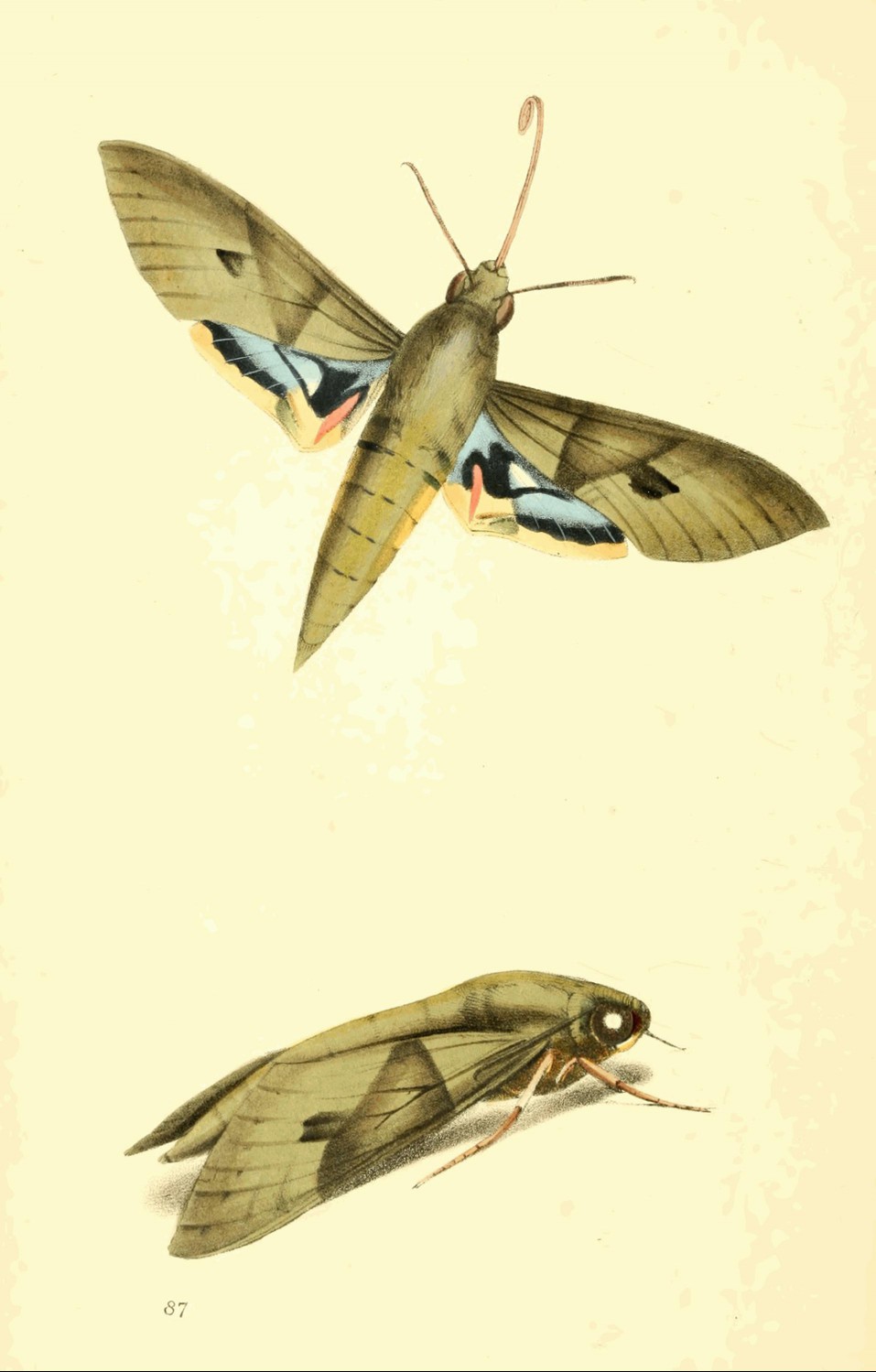
SPHINX Labruscæ,
Wild Vine Hawk-moth.
Generic Character.—See Pl. 81.
Specific Character.
S. alis integris; anticis virescentibus, fasciâ triangulari
centrali maculoque fusco ornatis; posticis medio cæruleo-nigris, margine
fulvo; abdominis lateribus punctis quinque niveis.S. Wings entire; anterior greenish, with a central triangular band and
black spot; posterior bluish black in the middle, the margin fulvous;
sides of the body with five snowy spots.S. Labruscæ. Gmelin, p. 2380. 14. Fab. Ent. Sys. 3. p.
377. Cramer, pl. 184. a.
Linnæus has well observed, that the great distinctions of his three
genera of Lepidoptera, were, that Butterflies are seen on the wing only
during the day; Hawk-moths, or Sphinxes, at the rising and setting of the
sun; and Moths during the night. The insects of Europe, indeed, offer but
few exceptions to these characters; but the habits of certain exotic
tribes, in each of these families, partake both of one and the other in a
remarkable manner. Thus, among the butterflies, there is a genus in South
America (hitherto unnoticed), which fly only during the dusk of evening:
a number of the Linnæan Hawk-moths prefer the meridian heat of the sun;
and there are not wanting several moths which are only seen during the
same period of the day.
The insect, however, before us, is of that tribe to which the remark
of Linnæus is strictly applicable; and, although included in the
Systema Naturæ, has remained without any correct representation,
for it would be difficult to delineate a worse figure of it than that
given by Cramer. Besides the row of five snowy white spots on each side
of the body, there are four pair of others, more dusky, down the middle,
and five small black dots near the outer margin of the fore wings; the
colour of all beneath is a buff yellow, with two faint dusky oblique
bars, and the middle of the fore wings sea green.
I have received this species from Jamaica; in its larva state it
appears to feed on the wild vine.
Pl. 88
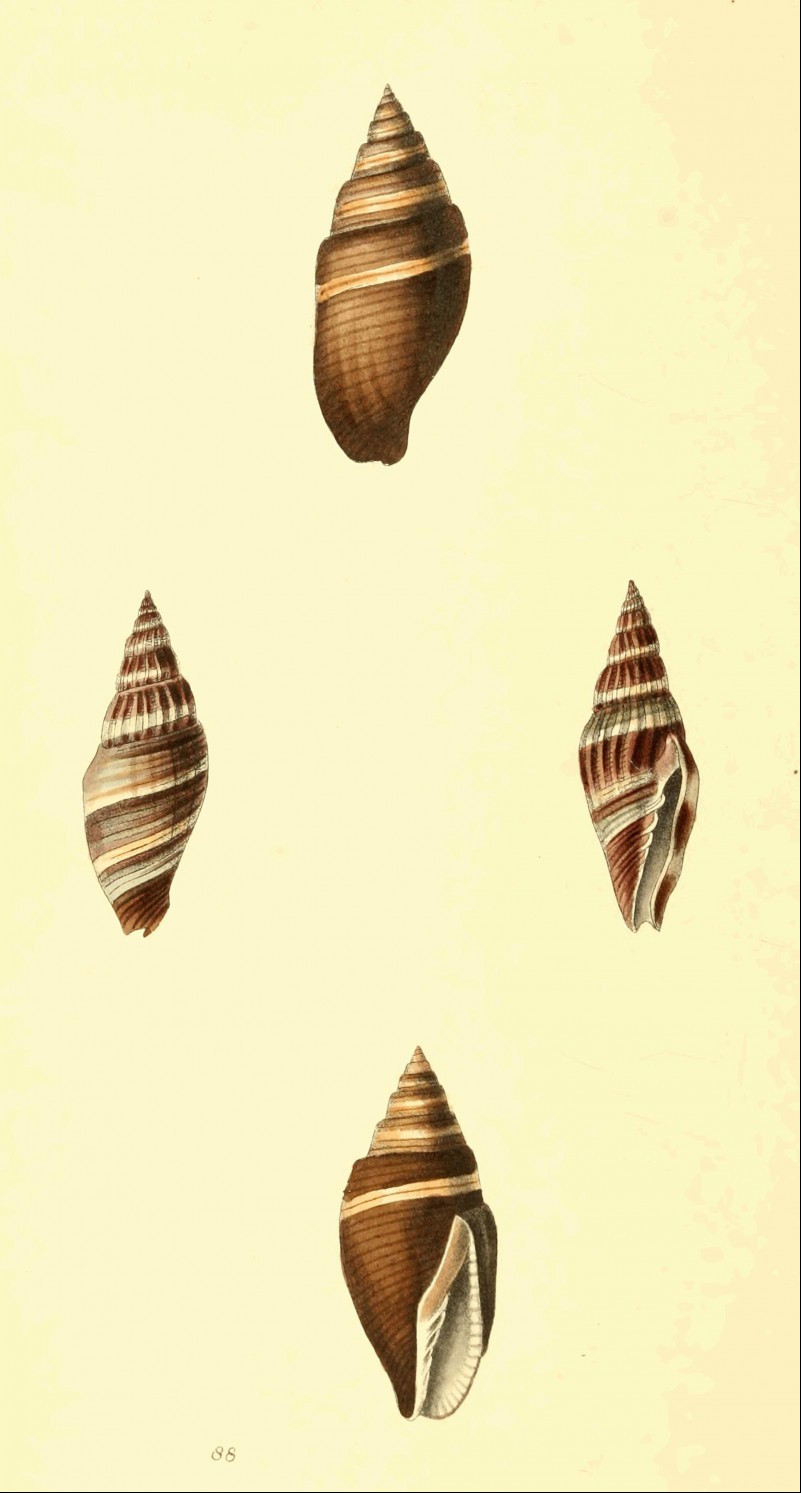
MITRA caffra,
Brown white-banded Mitre.
Generic Character.—See Pl. 23.
Specific Character.
M. (div. 1.) fusiformis, rufo-fuscata, albo fasciata, lævis, spirâ
plicato-striatâ, basi rugosâ, columellâ
quadriplicatâ.—Lamarck.Shell fusiform, reddish brown, with whitish bands; smooth; spire
plaited and striated; base rugose; pillar 4 plaited.Voluta caffra. Gmelin. 3451. Martini 4. tab. 148.
f. 1370.? Dill. p. 545.Mitra caffra. Lamarck. Ann. du Mus. vol. vii. p. 208.
no. 30.
It is not improbable that Mitra bifasciata, (Zool. Ill.
pl. 35.) may eventually be considered only a variety of the shell
here figured, which accords much closer with the characters given of the
Linnæan M. caffra, than any other; the two shells, however, at the
first glance, have a widely different appearance; yet not more so, than
the smooth and plaited varieties of Strombus vittatus Lin. I have
therefore retained the character given by Lamarck, as the best method to
be followed in doubtful cases. In this shell, the plaits commence halfway
round the body whirl; they are obtuse, crowded, and not angulated near
the suture; the striæ between are fine and decidedly marked; the base
half of the shell strongly grooved; the suture rather compressed; the
channel short and not recurved, and the aperture striated.
MITRA crassa
Thick Mitre—upper and lower figures.
M. (div. 3.) testâ lævi, mediâ crassâ, fuscâ, fasciâ angustâ
sub-albâ ornatâ; spirâ striatâ, striis intus punctatis; labio exteriore
dentato; columellâ 5 plicatâ.Shell smooth, thick in the middle, brown, with a narrow whitish band;
spire striated, the striæ with internal punctures: outer lip crenated;
pillar 5 plaited.
A species evidently unknown to Lamarck; the upper margin of each whorl
is thick and projecting; the striæ on the body whorl are nearly obsolete,
but on the spire become deep, remote, and having internally minute hollow
dots; the inner margin of the exterior lip is strongly crenated, the
aperture smooth, and the pillar with five strong teeth. I believe it was
brought from the South Seas.
Pl. 89

PSITTACUS murinus,
Grey-breasted Parakeet.
Generic Character.—See Pl. 1.
Specific Character.
P. viridis, genis, auribus, gulâque cinereis; vertice, remigibus
rectriciumque marginibus sub-cæruleis.Green; sides of the head, ears, and throat, grey; crown, quills, and
end of the tail, bluish.P. murinus. Gmelin. 1. 327. no. 80. Lath. Ind.
Orn. 1. p. 101.Grey-breasted Parrakeet. Lath. Syn. vol. 1. 247. Gen.
Zool. vol. viii. p. 456.
Those of our readers who visited Leamington during the last season,
may have observed this noisy little creature uttering its discordant
cries at the door of a small house near the pump-room. I borrowed it for
a day from the good woman to whom it belonged, and thus made the drawing
and description with the bird before me.
Dr. Latham observes on this species, that excepting where the grey
colour pervades, "the rest of the body is olive green, excepting the
quills, which are deep green;"—this may be the female. He adds a
quotation from Pernetty, who describes a bird from Monte Video, something
near this; but which, from having a very long tail, a flesh-coloured
bill, &c. may probably be distinct.
The live bird could not be conveniently measured, but it is rather
larger than the red-shouldered Parrakeet, (figured at pl. 62.) The skin
round the eye white, and the irides hazel; the whole upper part of the
plumage is a beautiful grass green, changing according to the light into
different shades; the top of the head, the quill feathers, and end of the
tail, greenish blue, in some lights appearing quite blue; the sides of
the head, ears, and throat, as far as the breast, bluish grey; all the
remaining under plumage yellowish green, with a shade of orange in the
middle of the body and vent; bill and legs dark grey; this latter colour
is so unusual in this tribe, that I at first thought it indicated an
imperfect plumage, but I have now seen it at two different seasons of the
year without any variation whatever. It is probably a South American
species.
Pl. 90

PTEROGLOSSUS inscriptus,
Lettered Aracari.
Generic Character.—See Pl. 44.
Specific Character.
P. fusco-viridis, capite gulâque nigris (feminæ castaneis;)
uropygio rubro; abdomine flavo; rostri fulvi culmine, basi et apice
nigris; marginibus dentatis, lineis nigris inscriptis.Obscure green; head and throat black, (in the female chesnut;) rump
crimson; body yellow; bill fulvous, the top, base, and tip, black; the
margins dentated, and marked with black lines resembling characters.
I was put in possession of this rare and unknown bird, by the
dispersion of the most magnificent assemblage of natural productions that
ever marked the zeal of an individual, or ornamented the capital of this
kingdom. Mr. Bullock's Museum is now scattered; yet the objects it
comprised were deemed worthy of enriching the public repositories of
every nation in Europe; who sent their learned men to purchase with
avidity, and share in the spoils of a Museum, the dispersion of which
will be long regretted by the learned, the inquiring, and "the many."
Total length, twelve inches and a half; bill, from the angle of the
mouth to the tip, two inches three tenths long, and eight tenths across
the base; the colour (which appears little changed from that in the live
state) is deep straw, or buff yellow; the top of the upper mandible and
tips of both are black; parallel with the marginal base of the upper, is
a black line, which is very broad on that of the lower; the edges of both
are serrated, and marked by short black lines, somewhat resembling
oriental characters; at the base of the bill there is an elevated rim of
deeper yellow; the ears, chin, and throat are deep chesnut, margined in
front with a narrow line of black, (which parts in the male are entirely
black;) the crown of the head and neck above also black, changing to a
dark bluish green on the wings, back, and tail; the rump crimson, and the
greater quills blackish; from the breast to the vent straw-coloured
yellow, with a greenish cast; the thighs and flanks olive; tail wedged,
near five inches long; the orbits appear to have been black, and the feet
green.
Mr. Bullock informed me he had the two sexes of this bird sent him
from the interior of Guyana.
Pl. 91
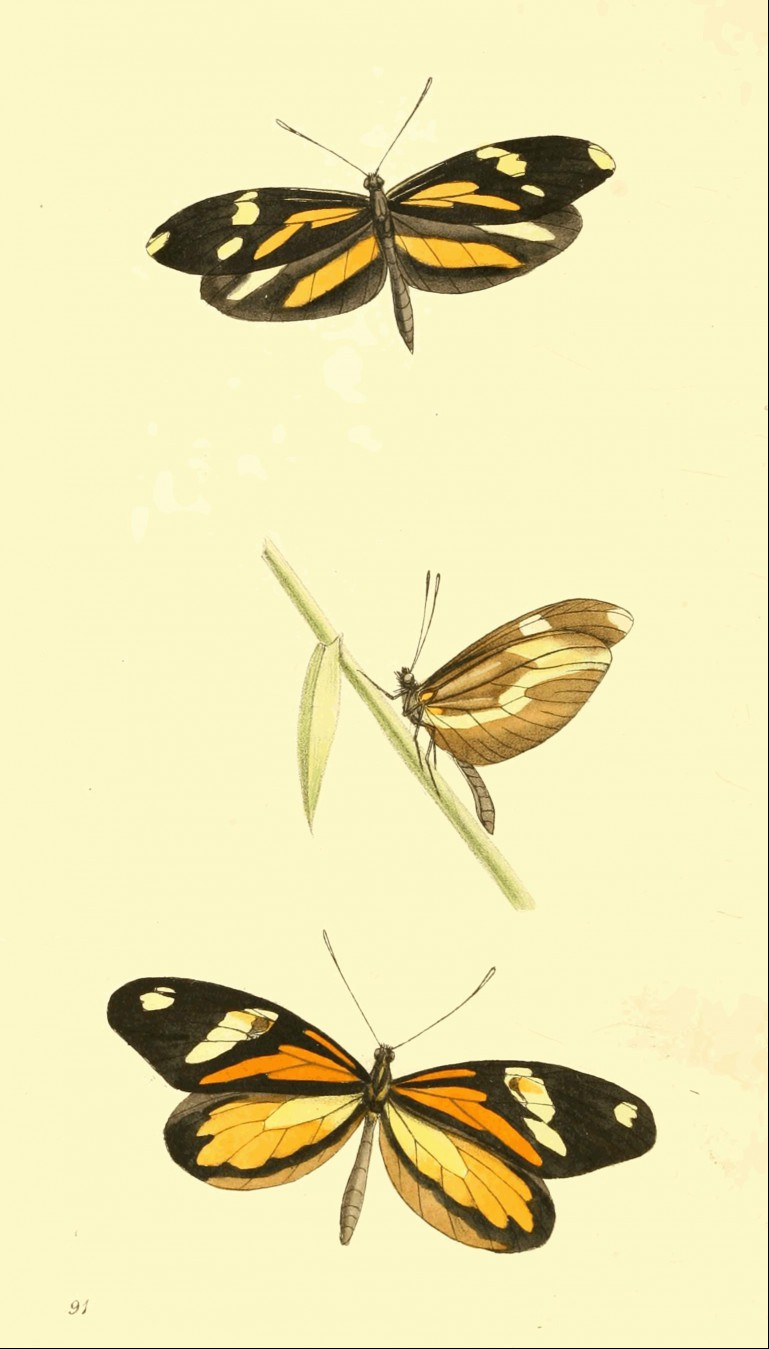
LICINIA Amphione.
Generic Character.—See Pl. 15.
Specific Character.
L. alis integris, suprà nigris; anticarum basi maculo aurantiaco,
triradiato, medio fasciâ flavâ, apice maculo flavo ornatis; posticis
strigâ aurantiacâ, margine ferrugineo; antennarum clavis albis.Wings entire, above black; anterior with a three rayed orange spot at
the base, and a central bend and terminal spot of yellow; posterior with
an orange stripe and brownish margin; club of the antennæ white.Papilio Amphione. Cramer, pl. 232. f. EF.
Pieris Amphione. Godart in Ency. Meth. vol. 9. p. 165.
(Female.)
This is the only species among those I have united under the genus
Licinia, which has any shade of red mixed in the colouring, all
the others being variegated only with white, yellow, and black. It is a
native of Brazil, and according to Godart of Guyana and the Antilles: though not
common, it is sometimes frequent in local situations, preferring the
borders of deep forests, and flying very slowly. I had the means of fully
ascertaining the two sexes, of which the two upper figures are of the
male, and the lower one the female. There can be no doubt the latter is
the Pieris Amphione, so admirably described by M. Godart, who,
however, makes no mention of the black marginal spots on the under side
of the posterior wings, represented in Cramer's figure, which may
therefore be a variety. More difficulty, however, exists in ascertaining
if the male is distinct from P. Laia, of Godart: the figures of
Cramer, in general, are so inaccurate, as always to excite a doubt in
cases of nice discrimination; Godart's description, nevertheless,
perfectly agrees with Cramer's figure: if it was, therefore, drawn up
from the insect itself, there can be little doubt that Laia is
distinct from Amphione; if, on the other hand, M. Godart made his
description only from Cramer's figure, the question remains in its
original uncertainty.
The club of the antennæ is white, tipt with pale brown. The under side
of the female very closely resembles the upper, excepting that the black
stripe on the lower wings is broken; and there are irregular blotches of
white at the tips of both wings, but no marginal spots, as represented by
Cramer.
It will be found that Licinia is the connecting genus between
those of Danais and Pieris, of Latreille, and that the
transition between the last of these and Colias is strongly marked
by that of Terias, (Zool. Ill. pl. 22).
What with the inaccuracy of figures, and the almost universal neglect
with which the most eminent entomologists have passed over this beautiful
order, the natural arrangement and affinities of the Lepidoptera
still remain in the greatest obscurity; and it is recommended to those
who may object to the additional generic distinctions I have made, to
examine, in the first instance, the relative validity they bear in
essential character to the innumerable genera that are continually
created in the Coleoptera, Hymenoptera, and
Diptera.
Pl. 92
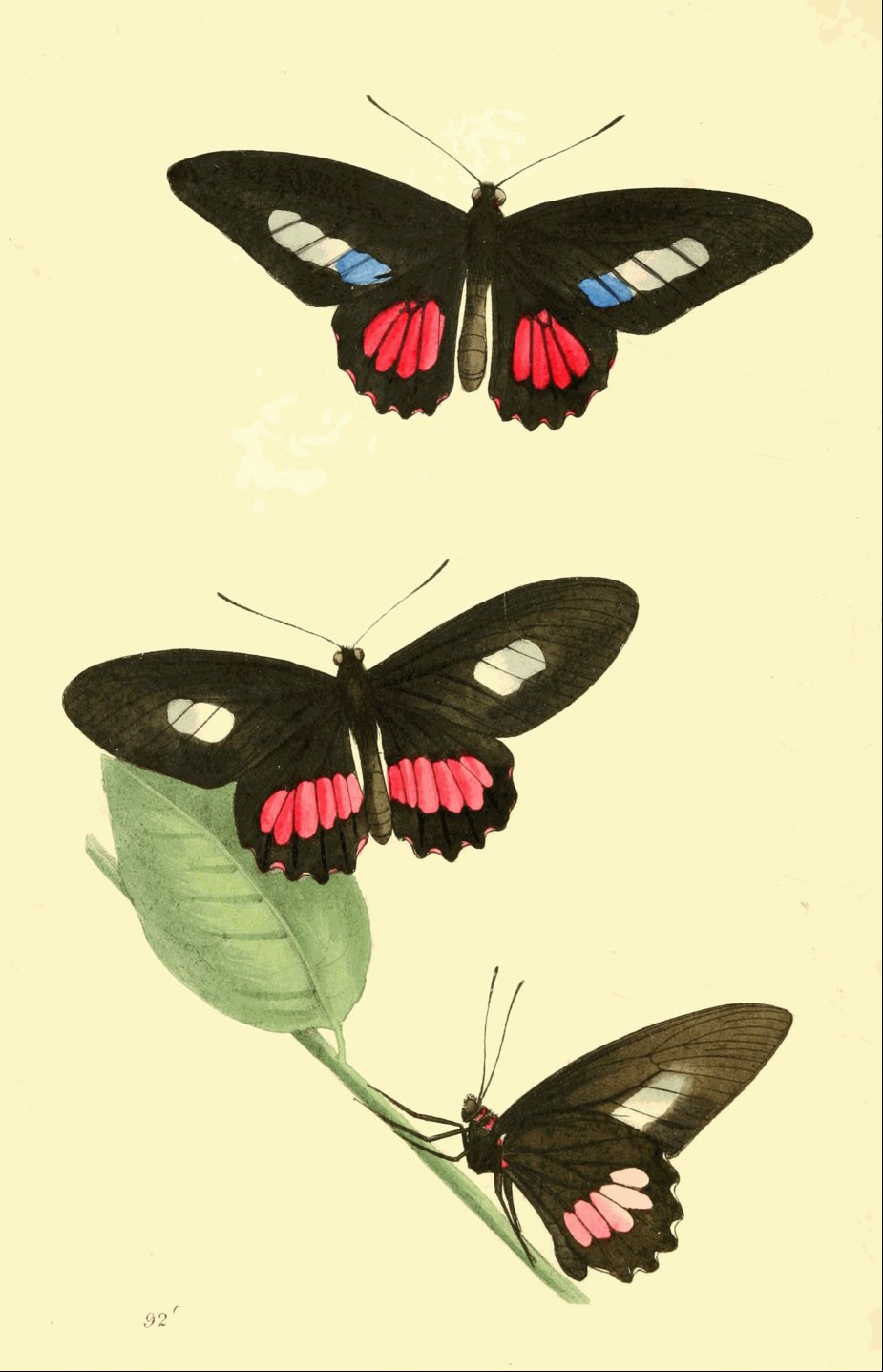
PAPILIO,
Butterfly
Generic Character.
Antennæ graciles, clavis elongatis, obtusis, sub-arcuatis, rarò
compressis. Palpi brevissimi, reflexi, remoti, linguæ basin vix
obtegentes, articulo ultimo obtuso, minimo. Pedes antici longi, articulo
secundo infrà gibbo.
Sectiones.
I. Græci.
Pectore maculis sanguineis carente.
a. Ecaudati, alis inferioribus elongatis, basi
angustâ.b. Percaudati, alis fasciis fulvis vel viridibus ornatis,
inferioribus caudis, elongatis, angustis, instructis.c. Caudati, alis inferioribus caudis obtusis, patulis,
instructis.
* Alis fulvo fasciatis.
** Alis nigricantibus.
d. Dentati, alis inferioribus dentatis.
e. Orbiculares, alis inferioribus brevibus,
orbicularibus.
II. Trojani.
Pectore maculis sanguineis insigni.
a. Ecaudati, alis inferioribus elongatis, basi latâ.
b. Caudati, alis inferioribus caudis obtusis, patulis,
instructis.c. Dentati, alis inferioribus dentatis.
d. Orbiculares, alis inferioribus brevibus,
orbicularibus.
Generic Character.
Antennæ slender, the club elongated, obtuse, slightly arched, and
rarely compressed. Feelers very short, reflected, remote, hardly covering
the base of the tongue, the last joint obtuse and minute; anterior feet
long, with a gibbous appendage on the under part of the second joint.
Sections.
I. Greeks.
Breast without sanguineous spots.
a. Tailless; lower wings elongated, and narrow at the base.
P. Sarpedon. Nereus C. Macleayanus G.
b. Long tailed; wings generally banded with yellow or
green.
P. Codrus. Sinon. Antheus. Podalirius. Machaon, &c.
c. Tailed; lower wings with obtuse patulous tails.
* Wings varied with yellow bands.
P. Torquatus. Thoas. C. Ilioneus (Donovan)
&c.** Wings generally dark, without bands.
P. Troilus. Paris. Severus. Pammon, &c.
d. Dentated; lower wings dentated, without tails.
P. Ægeus et Erechtheus. Don. Amphitryon. Drusius.
Demolius C.
e. Orbicular; lower wings short, orbicular.
P. dissimilis. Similis C. Assimilis (Drury).
Polydamas? Lin.
II. Trojans.
Breast with sanguineous spots.
a. Tailless; lower wings elongated and broad at the base.
P. Memnon. Polymnestor. Agenor. Hector. C.
b. Tailed; lower wings with obtuse patulous tails.
P. Polydorus. Romulus. Coon, &c.
c. Dentated; lower wings dentated.
P. Evander. (Godart.) Amosus? C.
d. Orbicular; lower wings short, orbicular.
P. Priamus. Panthous. Amphrisius, Harmonia et Cressida
(Donovan.)
From the earliest ages, the Butterfly appears to have attracted the
admiration of mankind; and we find it celebrated by their poets as
figurative of gaiety and pleasure, and by their sages as an emblem of the
human soul. It has been interwoven in one of their most beautiful
allegories, and has been consecrated in our own days by several poets,
though by none with such exquisite taste and moral feeling, as by the
venerable Historian of the Medici.
So few of those insects, generally called Butterflies, were known to
Linnæus, that he included them all in one genus, dividing them, for the
most part, into natural groups. Fabricius continued this arrangement,
with little variation, and has left us the description of near 1,150
species! Yet before his death, this laborious naturalist saw the absolute
necessity of dividing this immense genus into many others, and left among
his MSS. a sketch of his proposed arrangement, published afterwards by
Illiger, and partially adopted (we venture to think also very
imperfectly) by M. Latreille.
The insects which are therefore now left under the old genus
Papilio, are principally found out of Europe, and are remarkable
for their richness of colouring and immense size. M. M. Latreille and
Godart have described, with great precision, 146 species: it is, however,
to be regretted, that they have adopted no sections or divisions to
assist the student in his search after any particular species, among this
extensive number. The great disadvantage of this is very obvious, and it
has induced me to attempt something like a natural distribution of those
insects, which, with every care to avoid an unnatural separation of
kindred groups, I am fully aware, in some cases, is very artificial, and
it is only offered until a greater knowledge of the larvæ, &c. will
enable us to fix on more substantial characters than those I have
adopted. This, however, will be a work of time; and until then, I think
some guide to the ready knowledge of the species, however objectionable,
is better than none.
Much might be said on the affinities which connect this with several
other genera. Among the most striking is that existing between them and
the Noctuæ (N. Patroclus Fab.) by means of Pap.
Leilus Lin. which thus stands between the night and the day-flying
Lepidoptera. Many of the insects placed in our division of
Græci caudati, are allied to Danaus Lat. by the larva of both having retractile hornshaped
processes, and the two genera seem still further connected by Papilio
similis and dissimilis in one group, and by P. Priamus
in the other; while the clear winged species from New Holland seem to
indicate an affinity with the Heliconiæ.
The laborious and important investigations of M. Savigny into the
structure of the mouth of these insects are too well known, to require a
more particular notice in this slight sketch of the subject.
PAPILIO Polymetus.
Specific Character.
P. (Trojani orbiculares) alis atris; superis fasciâ breviori
(fœminæ albâ) anticè albâ, posticè cyaneâ, inferis dentatis, maculâ
coccineâ quadripartitâ.Papilio (T. orb.) wings black, superior, with a short white band,
which is blue at the base (in the female entirely white); inferior
dentated, with a four cleft crimson spot.Papilio Polymetus. Godart in Ency. Meth. vol. ix. p. 35.
no. 28.
First described by M. Godart; unless, indeed, it may hereafter prove a variety of P. Lycander (Cramer, Pl.
29. C. D.) which approaches as near to the male,
as P. Hippason does to the female. The first sex is here
represented at the upper and under figures; the middle is of the female,
which M. Godart has not described. It is a native of Brazil; I found it
at Bahia only in certain woods, and subsequently met with a variety in
the province of Rio Janeiro, differing only in being much larger.
Pl. 93
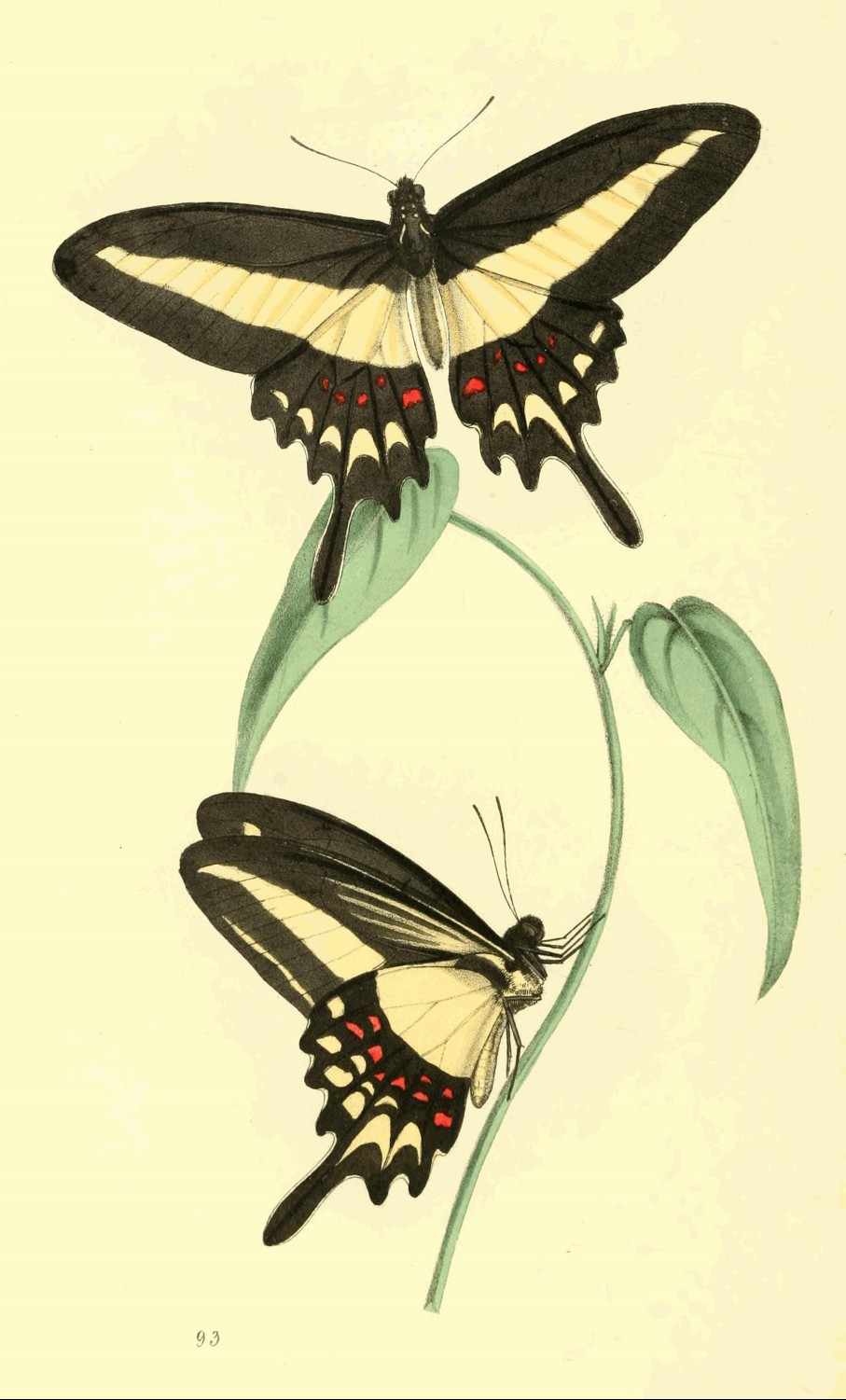
PAPILIO Pandrosus.
Specific Character.
P. (G. Caud.) alis atris, fasciâ communi posticarumque lunulis
marginalibus flavis; his caudatis, punctorum rubrorum striga
intermediâ. G.Pap. (G. Caud.) wings black; with the common band and marginal
lunules on the lower wings, yellow; lower wings with obtuse tails, and a
row of red dots between the nerves.—Godart.Pap. Pandrosus. Godart. En. Meth. vol. ix. p. 62.
No. 101.
M. Godart has anticipated me in the first publication of this, and a
great many other newly discovered Brazilian insects; it has, however, not
been figured; and I take this opportunity of expressing my doubts,
whether this and the next are not sexes of the same species, rather than
two, permanently distinct. I have not, at this particular time, the means
of referring either to my notes or my collections, by which the
recollection I have on the subject might be in some way confirmed; and,
until this is done, it is much better retaining the two insects as
distinct species: the figures of both will show their very close
resemblance, in every thing but the bands on the upper surface of the
wings. I found them common in the province of Rio de Janeiro.
Pl. 94
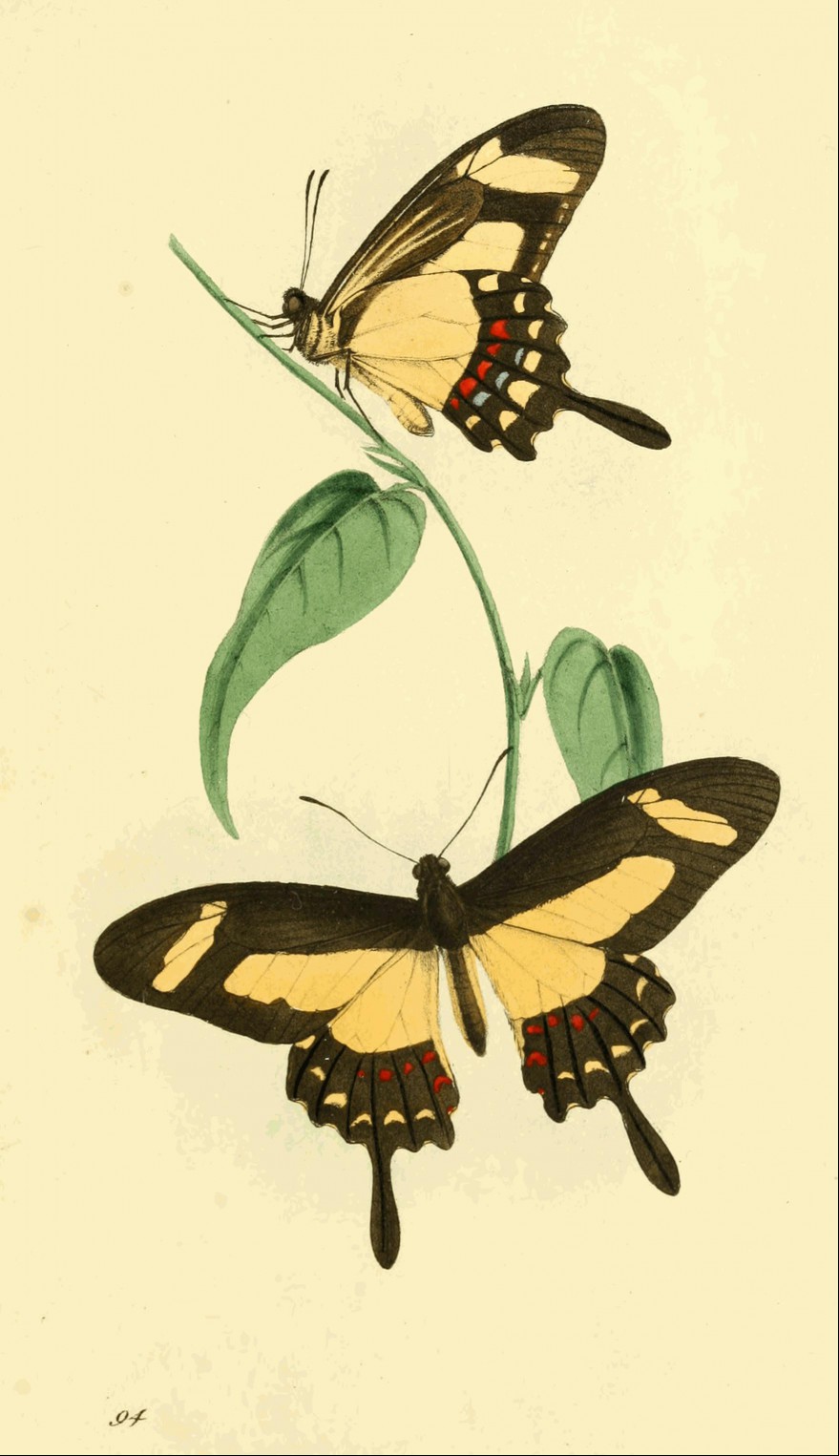
PAPILIO Torquatus.
Specific Character.
P. (G. Caud.) alis atris; anticis fasciis duabus, posticis disco
lunulisque marginalibus, flavis: his caudatis, punctorum rubrorum strigâ
intermediâ.—Godart.P. (G. Caud.) Wings black; two bands on the anterior wings, and
marginal lunules on the posterior, yellow; lower wings with obtuse tails,
and a row of red dots between the nerves.P. Torquatus. Cramer, pl. 177. fig. a. b.
Godart. En. Meth. v. 9. p. 62.
It is singular that Fabricius appears to have overlooked this species,
sufficiently well figured by Cramer to point out its leading characters,
though very inferior to the beauty of the insect. M. Godart has, however,
recorded it in his account of this superb genus in the Encyclopédie
Méthodique; and the minute and clear descriptions which this able
entomologist has given throughout that work, merit the highest eulogium.
Our own figures will, however, render a detailed description in this
place unnecessary.
M. Godart says, this insect is found both in Guiana and Brazil. In the
latter country, I met with it only in the province of Rio de Janeiro,
where it is common.
Pl. 95
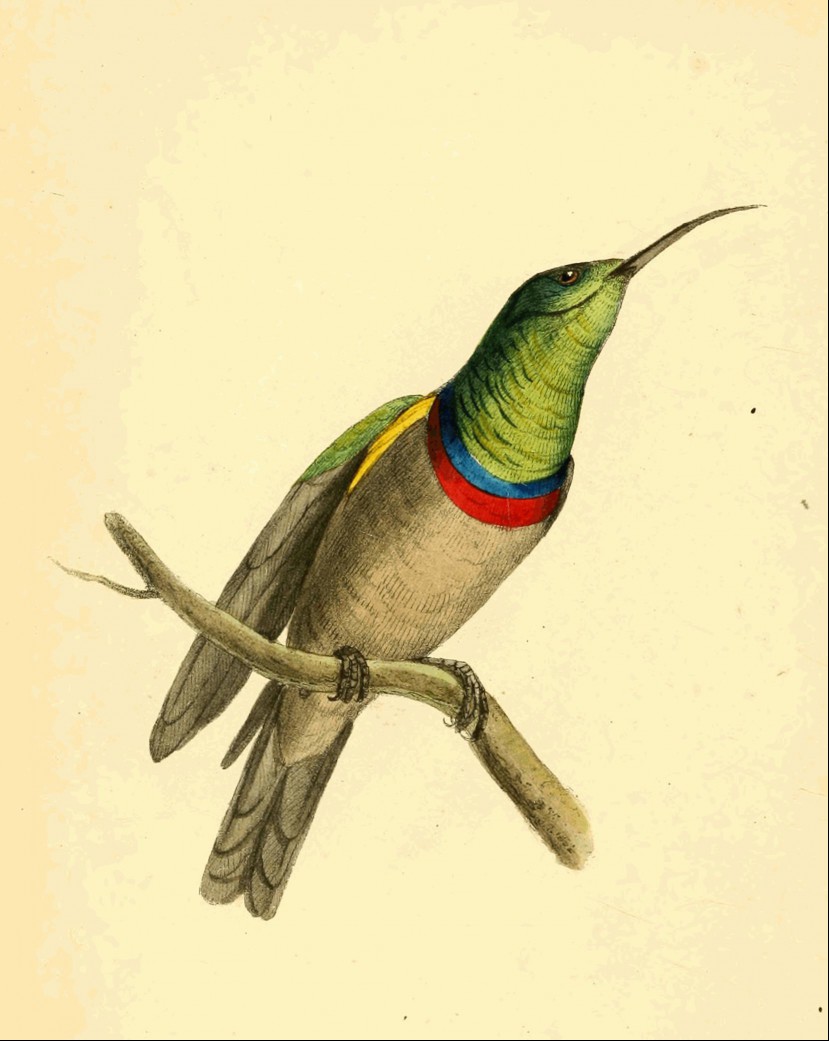
CINNYRIS chalybeia,
Lesser collared Creeper.
Generic Character.
Rostrum elongatum, gracillimum, arcuatum, apice acutissimo,
integerrimo, ad basin depressum, lateribus compressis, marginibus
inflexis, subtilissimè dentatis; mandibulâ inferiore convexâ. Lingua
jaculatoria, tubularis, furcata? Nares basales, breves, nudæ, ovatæ,
membranâ fissâ, juxta rostri marginem et basin aperiente, tectæ. Remigum
penna prima brevissima, secunda pennis 4 proximis paribus
brevior.Ob.—Maris cauda pennis elongatis 2 ornata, hypochondriorumque
pennæ longiores.
Typ. Gen. Upupa Promerops Lin.—Certhia famosa Lin.
Bill lengthened, very slender, arched, the base depressed, the sides
compressed, the tip very sharp and entire, the margins bent inwards and
minutely dentated; under mandible beneath convex. Tongue retractile,
tubular, forked? Nostrils basal, short, and broad, covered by a naked
oval membrane which opens by a slit near the margin of the bill. First
quill feather very short; the second shorter than the four next, which
are of equal length.Ob.—Male generally with long feathers in the tail, and
the side feathers under the wings rather lengthened.
Generic Types. Cape Promerops, and Shining Creeper. Lath.
Specific Character.
C. aureo-viridis, alis caudâque fuscis; fasciis pectoralibus 2
connexis, anticâ chalybeiâ, posticâ angustâ, rubrâ; caudæ tegminibus superioribus chalybeis.Golden green, with brown wings and tail, and narrow pectoral band,
bordered above by another of steel blue; upper tail covers blue.Certhia chalybeia. Lin. Gmelin. 475. Ind. Orn. 1. 284.
Brisson. 3 tab. 32. f. 1.?Le Soui-manga à collier. Vieill. Grimp. p. 40.
pl. 13. 14.Collared Creeper. Latham, Syn. 2. 709. Gent.
Zool. 8. 196.
This splendid family may be considered as the Humming-birds of the old
world, inhabiting (I think exclusively) the tropical regions of Africa
and Asia. To the personal observations of M. Vaillant we owe the first,
and indeed the only detailed account, of their real economy, and which
this enterprising ornithologist remarked during his travels in Africa,
and published in his work on the birds of that continent; a work which
will be valued and consulted when most of the systems framed by closet
naturalists will be forgotten.
M. Vaillant records a singular fact respecting these birds: which is,
that the males only assume their rich and vivid colours during the season
of courtship; at other times they are scarcely to be known from the
females, whose plumage in general is very plain. Another bird, very
nearly resembling this, has been figured by M. Vaillant under the name of
Le Sucrier à Plastron rouge (Ois. d'Af. pl. 300.); his reasons,
however, for separating them, are, I think, sufficient, at least until
more forcible ones are adduced than mere conjecture. Our figure is the
size of life; on each side the breast is a tuft of yellow feathers; the
back, neck, and head shining golden green, changing in various lights.
The female is said to be the Certhia Capensis of Lin., which is
greyish brown above, and paler beneath.
The different generic names which have been given to these birds by
modern systematic writers, require some elucidation. They were originally
placed by Linnæus among the Certhiæ; out of this genus Illiger
formed another by the name of Nectarinia, in which he included not
only these birds, but many others allied to them. From this genus of
Illiger's, Cuvier separated a part under the generic appellation of
Cinnyris, a genus which comprised those species of Illiger's
Nectarinia only which are found in the parallels of latitude of
the old world. So far these changes can be understood; but Professor
Temminck, without noticing this previous arrangement, places the birds
belonging to Cuvier's genus Cinnyris, under his own modification
of Illiger's Nectarinia, while to the Nectariniæ, as characterized by Cuvier, he gives the generic
name of Cœreba. This last change has introduced great
confusion; for the student must bear in mind, that Cuvier's genus
Nectarinia corresponds to Temminck's Cœreba; that
Cinnyris of Cuvier is Nectarinia of Temminck; and finally,
that all these are included under Illiger's original genus
Nectarinia! M. Vieillot has still further added to this
unfortunate multiplicity of names, by giving that of Mellisuga to
Cuvier's Cinnyris. This may truly be termed a war of words. In the
meantime, as Cuvier was the first who, by giving the name of
Cinnyris, designated the Sucriers of Vaillant, and those
only, his definition and generic name to these birds should
unquestionably supersede all others.
Pl. 96
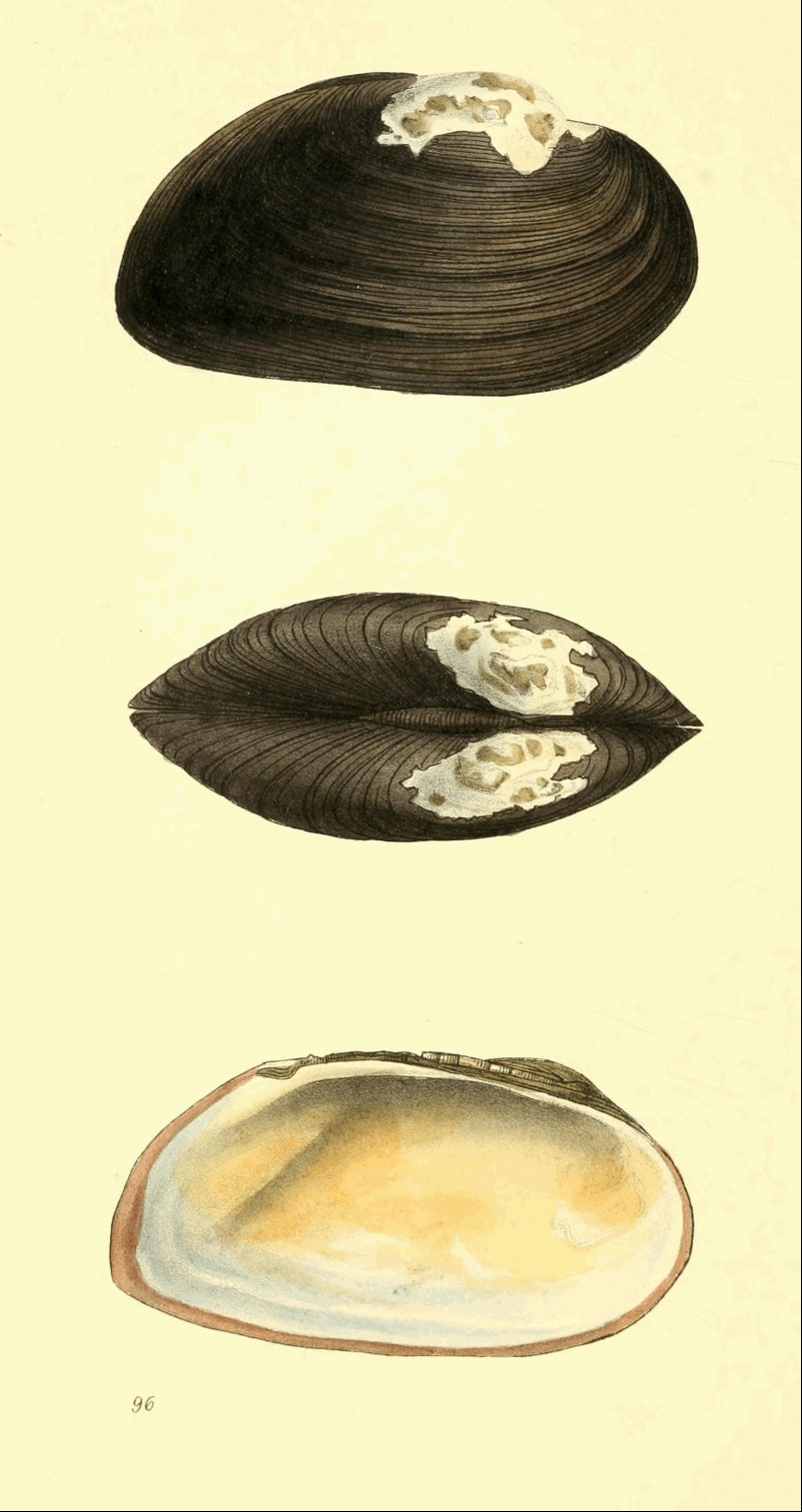
ANODON rugosus,
Wrinkled Horse Mussel.
Generic Character.
Testa transversa, plerumque tenuis. Cardo linearis, edentulus.
Lamina cardinalis glabra, aliquando levata, anticè sinu sub ligamento
desinens. Impressiones musculares 3. Ligamentum externum. Animal
fluviatile.
Typus Genericus Mytilus Anatinus Lin.
Shell transverse, generally thin. Hinge consisting of a simple
marginal lamina without teeth, smooth or slightly raised, terminating at
the anterior end in a curve or sinus below the ligament. Muscular
impressions three. Ligament external. Animal fluviatile.
Generic Type Duck Mussel Pennant.
Specific Character.
A. testâ ovato-oblongâ, crassâ, convexâ, anticè obliquè rotundatâ;
intus fulvâ, margine rufo; margine cardinali leviter curvato, infra
umbones crasso.Shell ovate-oblong, thick, convex, anterior obliquely rounded; hinge
margin slightly curved and thickened beneath the umbones; inside fulvous,
with a reddish margin.
The shells now arranged under the kindred genera of Unio and
Anodon are exclusively fluviatile, or inhabitants of fresh water,
and are dispersed both in the old and the new world. In the Linnæan
system, the first, being furnished with teeth, are placed among the
Myæ; and the latter, from having none, are arranged with the
Mytili. Two common shells, in our own rivers and ponds (Mya
pictorum, and Mytilus anatinus Lin.), will readily present to
the student the characters by which they are severally distinguished. The
shells of the present genus bear such a general resemblance to each
other, and are so simple in their construction, that a corresponding
minuteness of discrimination is requisite to characterize the species; I
have, therefore, selected for this purpose the modification of the upper
margin to which the ligament is attached, and which in other shells forms
the bases of the teeth. This I have termed the hinge margin. The form of
the notch or sinus which terminates this part will also be found of much
importance in discriminating the species; for no shells vary more in
their form, thickness, or convexity than these do, according to their
locality, age, or other circumstances.
Shell transverse, oval; rather thick and ventricose; both extremities
obtuse; the anterior side (from the umbones to the exterior margin)
obliquely rounded; umbones prominent; hinge margin rather thick, slightly
curved, and swelled immediately under the umbones; sinus short, abrupt,
curved; epidermis coarse, black, and much wrinkled; inside stained with
yellow, and having a narrow reddish rim or margin.
For this species, now, I believe, first made known, I am indebted to
G. C. Bainbridge, Esq. of Liverpool, who received several specimens from
the United States. It appears to have been unknown to Mr. Say, who has
published an account of the land and river shells of North America.
The student might be led to suppose, that the two genera of
Unio and Anodon are strongly characterized; for the first
includes many of the most ponderous bivalves yet discovered, and the
second some remarkably thin and brittle. Among the Uniones are
shells furnished with hinges of the greatest force, while most of the
Anodons are perfectly destitute of any; nevertheless, the
gradations by which these characters approach each other are very
remarkable, and some shells which partake of both have been arranged in
separate genera. Of these, the best defined are Hyria Lam. and
Dipsas of Leach; the one allied nearest to Unio, but having
the cardinal teeth assuming the appearance of lateral or lamellar teeth;
the other more resembling the Anodons, but furnished with a strongly
defined and elevated lamellar tooth, extending the whole length of the
hinge. Between these two genera should be placed another of Lamarck's,
called by him Iridinia, which has likewise only a simple lamellar
plate, but broken into a great number of crenated teeth. The observing
Mr. Say has likewise proposed another under the name of
Alasmodonta, which, however, I shall take another opportunity of
noticing.
I have ventured to exchange the ungrammatical name of Anodonta,
given by Bruguiere to this genus, for Anodon, at the suggestion of
the learned Dr. Goodall, Provost of Eton College.
Pl. 97
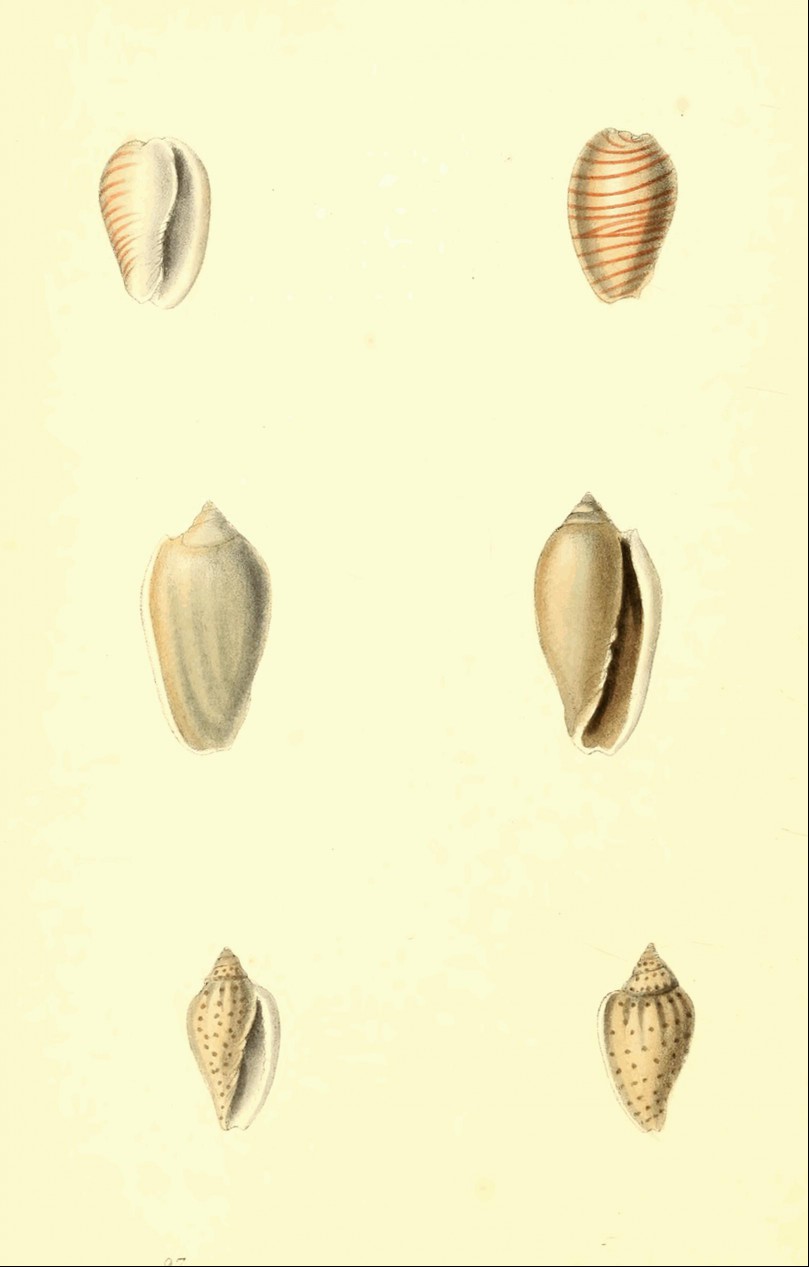
MARGINELLA,
Date Shell.
Generic Character.
Testa ovata. Spira brevissima aut nulla. Labium exterius
crassissimum, margine interiore crenato. Columella plicata. Basis
subintegra. Animal capitatum, capitis fronte profundè emarginato; oculis
ad tentaculorum 2 subulatorum basin externam adsitis; tubâ jugulari
simplici; pede magno, foliaceo, ponè attenuato; penulâ dilatatâ, testæ
latera obtegente.
Typ. Gen. Volutæ perspicula, glabella, prunum, &c. Lin.
Shell oval. Spire very short or concealed. Exterior lip very thick,
with the internal margin crenated. Pillar plaited. Base nearly entire.
Animal capitate; head notched in front, with lengthened, pointed
tentacula, at the external base of which are the eyes; neck with a simple
tube; foot large, foliaceous, pointed behind; mantle dilated, and folded
over the sides of the shell.
Generic Types Vol. perspicula, glabella, prunum, &c. Lin.
Lamarck first separated the shells comprised in this genus from the
Volutes of Linnæus; their principal distinction rests in the formation of
the outer lip, which has a very thick margin, more or less toothed on the
inner rim; the base likewise is nearly entire, and the inner lip quite
wanting.
By these peculiarities, the Date Shells are easily known from
the Volutes on the one hand, and the Cowries on the other;
and the invaluable researches of M. Adanson, who has described and
figured the animals of each of these genera, has established this
distinction on the most solid principles; it will, however, be
interesting to trace, by the shells only, how beautifully this
arrangement is developed.
The Marginellæ may be divided into two sections; the first
bearing in form and habit a strong resemblance to the Cyprææ, and
the second gradually losing these indications, and acquiring those of the
spiral Volutæ. Among the first are several species, which, like
the Cowries, appear destitute of any spire (as in M. cingulata);
this part, however, begins to show itself in other successive species
very progressively, until it becomes elevated and defined in M.
glabella. This shell may be considered the passage to the second
division, in which the species lose the simple oval form of the first,
and acquire a contracted base and pointed spire, perfectly resembling
Voluta undulata Lam. and its allies. The extreme developement of
these characters is shown in M. faba.
This genus must, then, be considered as connecting those of
Cypræa and Voluta (Lam.); excepting one, the whole of the
species are very small; and as the three here selected to illustrate
these remarks are frequently seen, and have been often described under
other names, little more is necessary than to detail their specific
characters.
MARGINELLA cingulata,
Banded Date Shell—upper figures.
M. testâ ovatâ, albidâ, lineis aurantiacis fasciatâ; spirâ
obsoletâ, umbilicatâ; columellâ 6 plicatâ.Shell oval, whitish, banded with orange lines; spire obsolete,
umbilicated; pillar 6 plaited.Voluta cingulata. Dill. 525. 56. Lister. 803. f.
9. Martini, 2. t. 42. f. 419 and 20.
Gualt. t. 25. c.? 28. b. Adanson,
t. 4. f. 4.
I am happy to record Mr. Dillwyn as the first systematic writer who
separated this from Mar. persicula, which has reddish spots, and
is quite a distinct species. The present is a pretty, though common
shell, and observed by Adanson in great plenty on the African coast.
MARGINELLA prunum,
Grey Date Shell—middle figures.
M. testâ ovatâ, griseâ, immaculatâ; spirâ parvâ, conicâ; aperturâ
fuscâ; columellâ 4 plicatâ.Shell oval, grey, immaculate; spire small, conic; aperture brown;
pillar 4 plaited.Voluta plumbea. Sol. MSS. L'Egouen. Adanson, tab. 4.
f. 3.V. prunum. Gm. p. 3446. 33. Martini, 2. t.
42. f. 422 and 3. En. Meth. 376. 8. Lister,
817. 28. (young.) Dill. 530. 69.
The plaits are very strong, and, together with the outer lip, white;
equally common, and from the same country, as the last.
MARGINELLA faba,
Fly-spot Date Shell—lower figures.
M. testâ ovatâ, plicatâ, fulvâ, punctis fuscis ornatâ; spirâ
conicâ; basi emarginatâ; columellâ 4 plicata.Shell oval, plaited, fulvous, with brown dots; spire conic; base
notched; pillar 4 plaited.V. faba. Gm. 3445. Lister, 812. 22. Martini, 2.
t. 42. f. 431? 432, and 3. En. Meth. 377. 1.
Gualt. 28. Q. Dill. 528. 63.
The whorls of this pretty shell are plaited into little nodules; it is
usually very small. The supposed variety figured by Martini, and
mentioned by Mr. Dillwyn, I am inclined to believe, may be a distinct
species.
Pl. 98
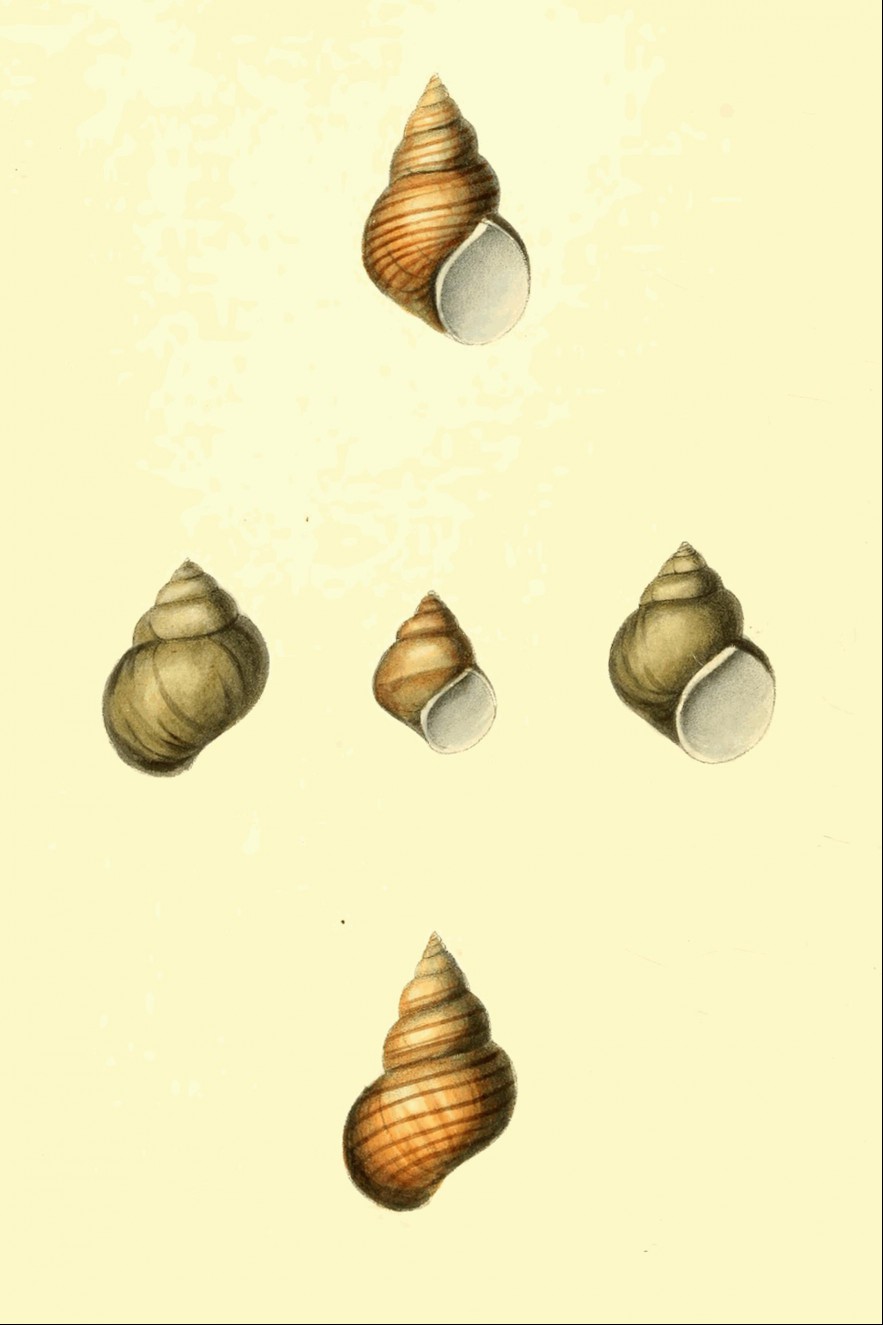
PALUDINA,
River Snail.
Generic Character.
Testa ovata, spiralis, tenuis, umbilicata. Apertura
semi-orbicularis, ad labii anterioris apicem subangulata. Operculum
corneum.Animal fluviatile, branchiatum, viviparum, rostro brevissimo;
oculis ad basin externam tentaculorum acutorum 2 appositis; pedis margine
antico duplici; lateribus anticè alis parvis instructis; alâ dexterâ
involutâ in canalem per quem aqua in tracheam introducitur.
Typus Genericus Helix vivipara, Lin.
Shell ovate, spiral, thin, umbilicated. Aperture nearly orbicular,
slightly angulated at the top of the inner lip. Operculum horny.Animal fluviatile, branchiated, viviparous; rostrum very short; eyes
placed at the external base of two pointed tentacula; anterior border of
the foot double; on each side the fore part of the body a small wing;
that on the right side is folded into a channel, by which the water is
introduced into the respiratory canal.
Generic Type Viviparous Snail Pennant.
The common Shell above quoted, inhabiting many of our rivers, will
serve as an excellent example of this genus, which is not numerous, and
confined to fresh waters; the animals, inhabiting the European species,
appear to have been thoroughly investigated by the continental
naturalists; and from their account of its singular construction, the
above description has been framed. Science should make no distinction of
persons or countries; but it is rather mortifying to observe, that these
important discoveries in the organization of animals, are pursued with
zeal and ability by foreign naturalists, while most of our own content
themselves with expatiating on its impossibility, and even go so far as
to hint its uselessness, because we can never become acquainted with the
animals of all the species of shells in our cabinets: so far this
latter part of the argument is most true; but, to ascertain, for
instance, the animal of the Cowry, it is surely not requisite we should
see those of all the species (near 80 in number), before we
venture to describe it? any more than it is necessary completely to
dissect every species of Locust before we pronounce it to be one.
Science would, indeed, receive incalculable and lasting benefit, if those
of our conchologists who reside near the coast would pay greater
attention to the inhabiting animals, and less to the shells, of their
neighbourhood; for the first would supply that information they
acknowledge is so desirable, and the latter would prevent our indigenous
Catalogue from being crowded with many dubious, and even foreign
shells.
English conchologists appear not to be aware of the vast number of
testaceous animals which are now known. Among those truly eminent men who
have prosecuted this study, M. Adanson stands foremost, in having
minutely described all those he found on the African coast; in the
magnificent work of Poli nearly all the Mediterranean bivalves are
exquisitely figured; and those of the land and fresh water will receive
complete illustration from M. Ferrusac. Cuvier, Lamarck, Say, and even
our own countrymen, Dr. Leach and Montague, have all contributed, more or
less, to form a mass of information which it is full time should be
employed as the basis of natural classification.
PALUDINA elongata,
Long-spired River Snail—upper and lower figures.
P. testâ olivaceo-fuscâ, fasciis castaneis ornatâ; spirâ productâ,
attenuatâ, aperturâ multo longiore; apice acuto.Shell olive brown, with chesnut bands; spire lengthened, attenuated,
much longer than the aperture; tip acute.
Inhabits the rivers of India. It is rather thicker than most of the
others, and the umbilicus nearly obsolete.
PALUDINA unicolor,
Olive River Snail—side figures.
P. testâ subventricosâ, totâ olivaceâ; apice acuto; spiræ et
aperturæ longitudine æquali; umbilico clauso.Shell subventricose; uniform olive; apex of the spire acute; aperture
and spire of equal length; umbilicus closed.
Distinguished from the Helix vivipara of authors, by having a
less convex, and more pointed spire, hardly any umbilicus, and no bands.
Inhabits China.
PALUDINA carinata,
Carinated River Snail—middle figures.
P. testâ parvâ, olivaceâ; spirâ aperturâ longiore, apice obtuso,
rufo; anfractu basali medio leviter carinato; umbilico obsoleto.Shell small, olive; spire longer than the aperture; the tip obtuse,
rufous; basal whorl slightly carinated in the middle; umbilicus
obsolete.
A distinct species, which is never found larger than the figure. I
once saw near 100, which had been picked up on the banks of the Ganges;
the spire is rather lengthened, always obtuse, and the umbilicus even
less than the last.
Pl. 99
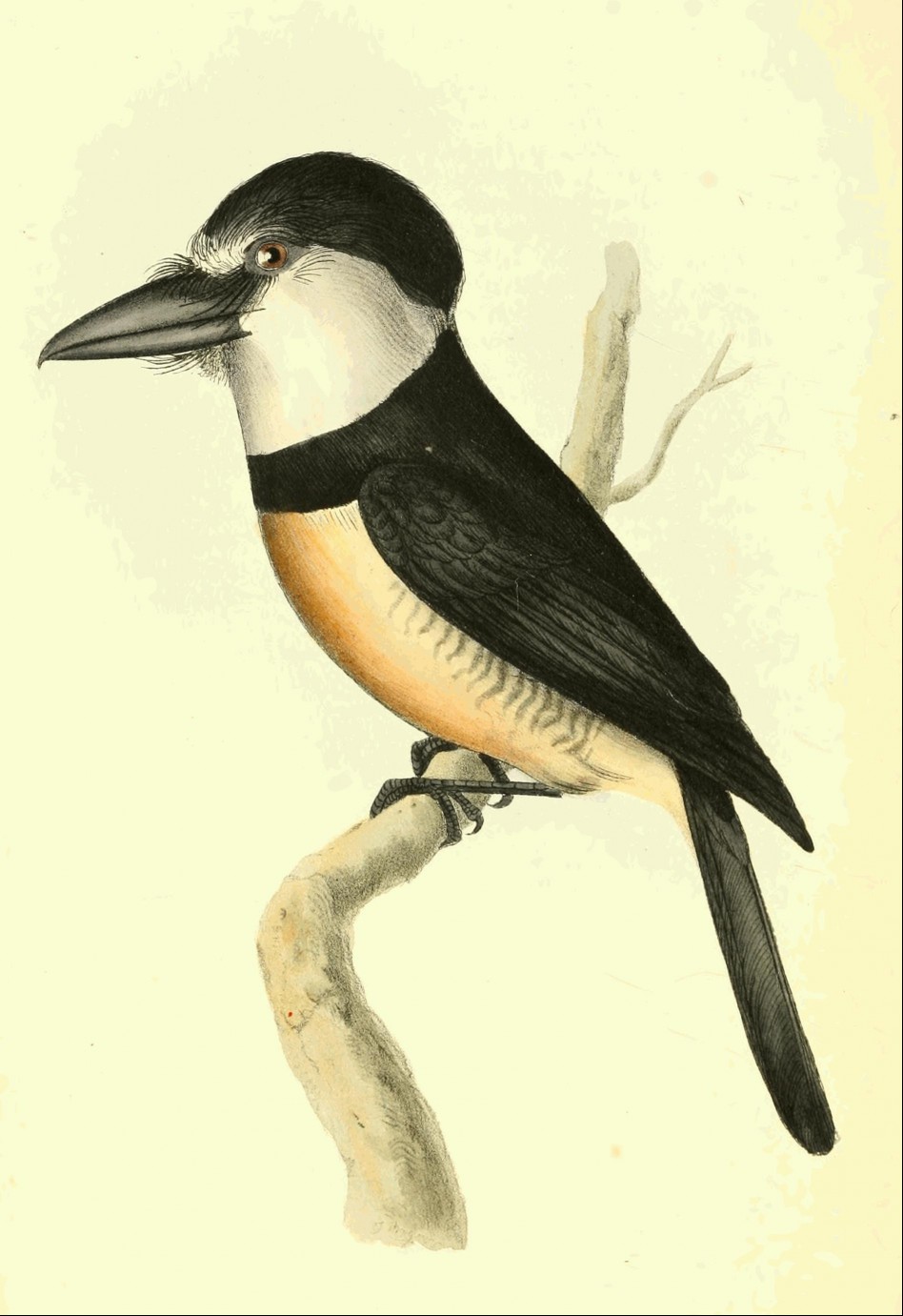
TAMATIA macrorhynchos.
Greater pied Puff-bird.
Generic Character.
Tamatia. Cuvier.—Capito. Viell. Tem.
Rostrum validum, compressum, sub-rectum; mandibulâ superiore ad
apicem obtusè aduncâ, emarginatâ, superioris margine inferioris marginem
obtegente. Nares basales sulcatæ, aperturâ terminali, rotundâ parvâ,
plumis rigidis incumbentibus tectâ. Frons, rictus, et mentum vibrissis
rigidis, elongatis, armati. Pedes scansorii, versatiles; digiti
exterioris elongati articulo primo cum digito exteriore connexo.
Rectrices 12, lineares, subrotundatæ.
Typus Genericus Bucco tamatia Linn. Lath.
Bill strong, compressed, nearly straight; the tip of the upper
mandible curved, notched, and obtuse; the margin folding on that of the
lower mandible. Nostrils basal, sulcated; the aperture terminal, round,
small, hid by bristly incumbent feathers. Chin, front, and gape, with
strong lengthened bristles. Feet scansorial, versatile; the outer toe
long, and connected by the first joints to the inner toe. Tail feathers
12, linear and slightly rounded.
Generic Type Spotted-bellied Barbut Latham.
Specific Character.
T. niger; fronte, gulâ, jugulo, caudæque apice albis; abdomine albo
vel fulvo; fasciâ pectorali nigrâ.Black; front, throat, forepart of the neck, and tips of the tail
feathers, white; body white or fulvous; pectoral bar black.Bucco macrorhynchos. Gmelin 406. In. Orn. 1. 203.
Gen. Zool. vol. ix. p. 33.Greater pied Barbut. Lath. Syn. 2. p. 498.
There is something very grotesque in the appearance of all the Puff
birds; and their habits, in a state of nature, are no less singular. They
frequent open cultivated spots near habitations, always perching on the
withered branches of a low tree; where they will sit nearly motionless
for hours, unless, indeed, they descry some luckless insect passing near
them, at which they immediately dart, returning again to the identical
twig they had just left, and which they will sometimes frequent for
months. At such times the disproportionate size of the head is rendered
more conspicuous by the bird raising its feathers so as to appear not
unlike a puff ball; hence the general name they have received from the
English residents in Brazil; of which vast country all the species, I
believe, are natives. When frightened, their form is suddenly changed by
the feathers lying quite flat; they are very confiding, and will often
take their station within a few yards of the window; the two sexes are
generally near each other, and often on the same tree.
Total length rather more than eight inches; bill, one inch and three
quarters from the gape, and half an inch less from the nostrils; it is
very strong, thick, black, and slightly compressed; the tip of the upper
bifid; the bristles at its base covering the nostrils are long and
incurved, and those situated at the base, under the eye, very stiff; the
upper part of the head black, the feathers much lengthened; the sides,
front, ears, and forepart of the throat white, uniting at the back of the
head into a narrow collar. The whole of the remaining plumage above is
black, glossed with greenish; across the breast a black bar, which
separates the white of the throat from the buff colour which tinges the
abdomen and vent; the flanks are marked with dusky transverse stripes;
the tail is slightly rounded and three inches and a half long, some of
the feathers with a very fine line of white at their tips; all the quill
feathers have the base half of their inner shafts white, as well as the
greater covers inside, the lesser being black; legs and claws
blackish.
I am disposed to consider this bird only as a variety of the
Greater pied Barbut of Dr. Latham, differing in having the plumage
on the under part of the body pale ferruginous, or buff colour, instead
of white, as in the specimens he described from Cayenne; mine are from
Southern Brazil, where the species is not uncommon.
This genus includes the American species of the Linnæan Barbuts; the
birds connecting this group with the cuckows are arranged by Vieillot in
a separate genus, named by him Monassa; which I think should be
retained, as it is of much importance to designate strongly connecting
links between families apparently very opposite.
Pl.
100
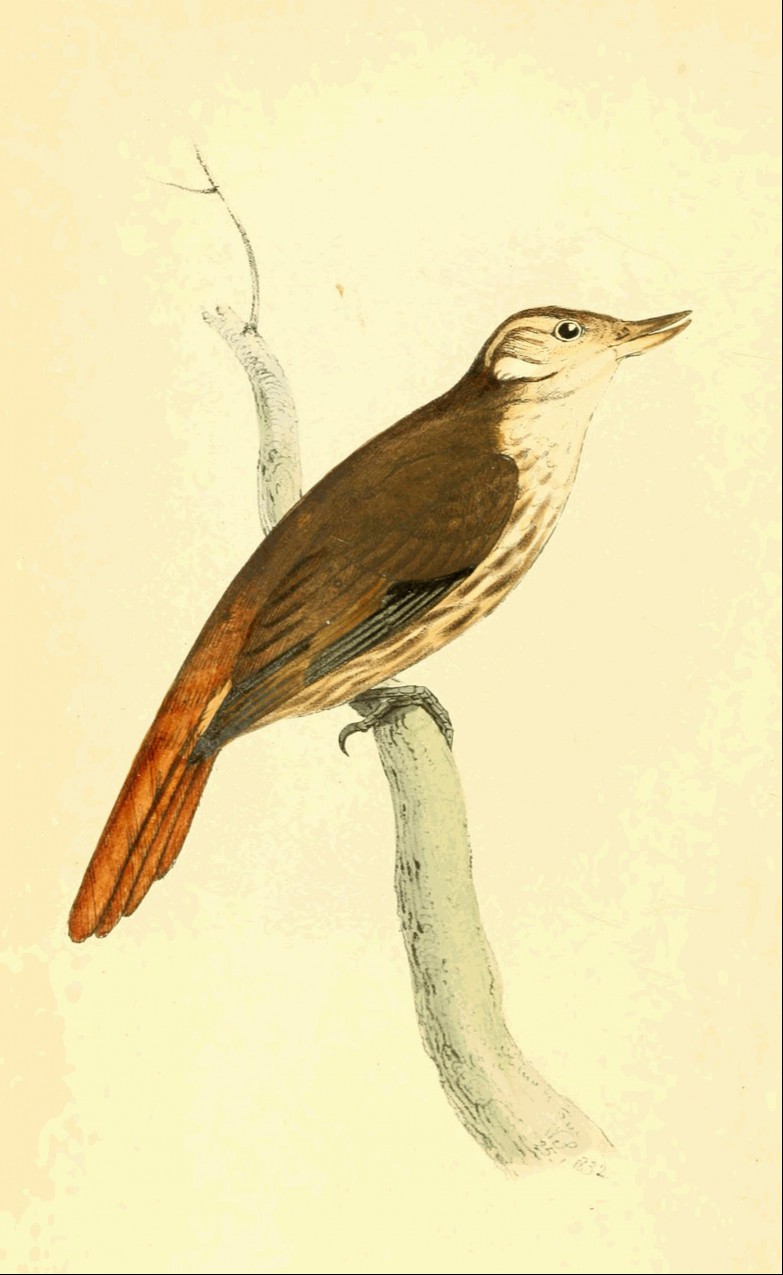
XENOPS genibarbis,
Whiskered Xenops.
Generic Character.
Xenops. (Hoffmansegg. in Illiger. Prod. p. 213).
Rostrum mediocre, rectum, acutum, valdè compressum, inversè
cultratum, i. e. culmine recto, gonyde recurvâ ascendente. Nares
basales, laterales, ovatæ, parvæ, patulæ. Lingua—? Pedes mediocres,
congrui. Digiti antici basi coadnati, laterales subæquales. Hallux
digitum medium æquans. Illiger.Bill moderate, straight, acute, much compressed, and inversely curved;
the top of the upper mandible being straight, and the edge of the lower
ascending or recurved. Nostrils basal, lateral, oval, small, and covered
by a naked membrane. Tongue—? Feet moderate, claws united at their
base, the lateral ones nearly equal; the hind claw as long as the leg and
the middle toe.
Specific Character.
X. suprà fusco-rufa, infrà griseo-fusca; mento, superciliis
maculisque jugularibus et pectoralibus albentibus; maculo infra aures
niveo; remigum secundorum nigricantium basi fulvâ, apicibus marginibusque
rufis.Above reddish-brown, beneath grey-brown; chin, eyebrows, and spots on
the throat and breast, whitish; beneath the ears a snowy spot;
lesser-quills blackish, the base fulvous, the tips and margins
rufous.Xenops genibarbis Illiger Prod. p. 218. (1811.)
Neops ruficaudus Vieillot. Orn. Elem. p. 68. (1816.)
A very extraordinary and not inelegant little creature, having a bill
totally different from any other bird. Its general habit evinces a close
connexion with the Sittæ, particularly those of New Holland; some
of which have their bills (which are slender) slightly inclining upwards,
thus forming a connexion between Xenops and the straight billed
Sittæ of the old world.
The figure is of the male, and its natural size; the head dark brown
with pale spots; the back of a reddish tinge, and the rump and tail
rufous; tail much rounded, and of twelve feathers; the three outer and
the two pair in the middle entirely rufous, the other pair having the
inner shafts black; the greater quills black; the last having an internal
bar of pale fulvous. Beneath the eye a spot of white downy feathers, with
a dusky border above and below; there is a little difference between this
and Illiger's bird, but it may be only sexual.
Inhabits Brazil, but is rare.
Pl.
101

PAPILIO Evander.
Generic Character.—See Pl. 92.
Specific Character.
Pap. (Tro. dent.) Alis dentatis, nigris; posticis suprà maculis
quinque violaceo-chermesinis; anticis subtùs fasciâ albidâ, transversâ,
mediâ. Godart.Pap. (Tro. dent.) Wings dentated, black; posterior above with a
five-cleft, violet-crimson spot; anterior beneath with a transverse,
central, whitish band.P. Evander. Godart, En. Meth. vol. ix. p. 32.
no. 18.
Both sexes of this newly described insect are here, for the first
time, figured; that above is of the male, and beneath is represented the
under side of the female. The crimson spots (which finely relieve the
brownish velvet-like black on the upper surface of the wings) are, in
some lights, most beautifully glossed with changeable violet, and appear
either darker or paler according to the position in which the insect is
viewed.
Southern Brazil is, undoubtedly, more rich in this splendid family
than the northern provinces of that vast country. I never saw this
species except in Rio Janeiro, where it is common: nor do I know of any
other, belonging to the division of Trojani, which have the lower
wings sharply dentated, and with an appearance of obsolete acute
tails; a character more developed in the female of this species than in
the male.
Pl.
102
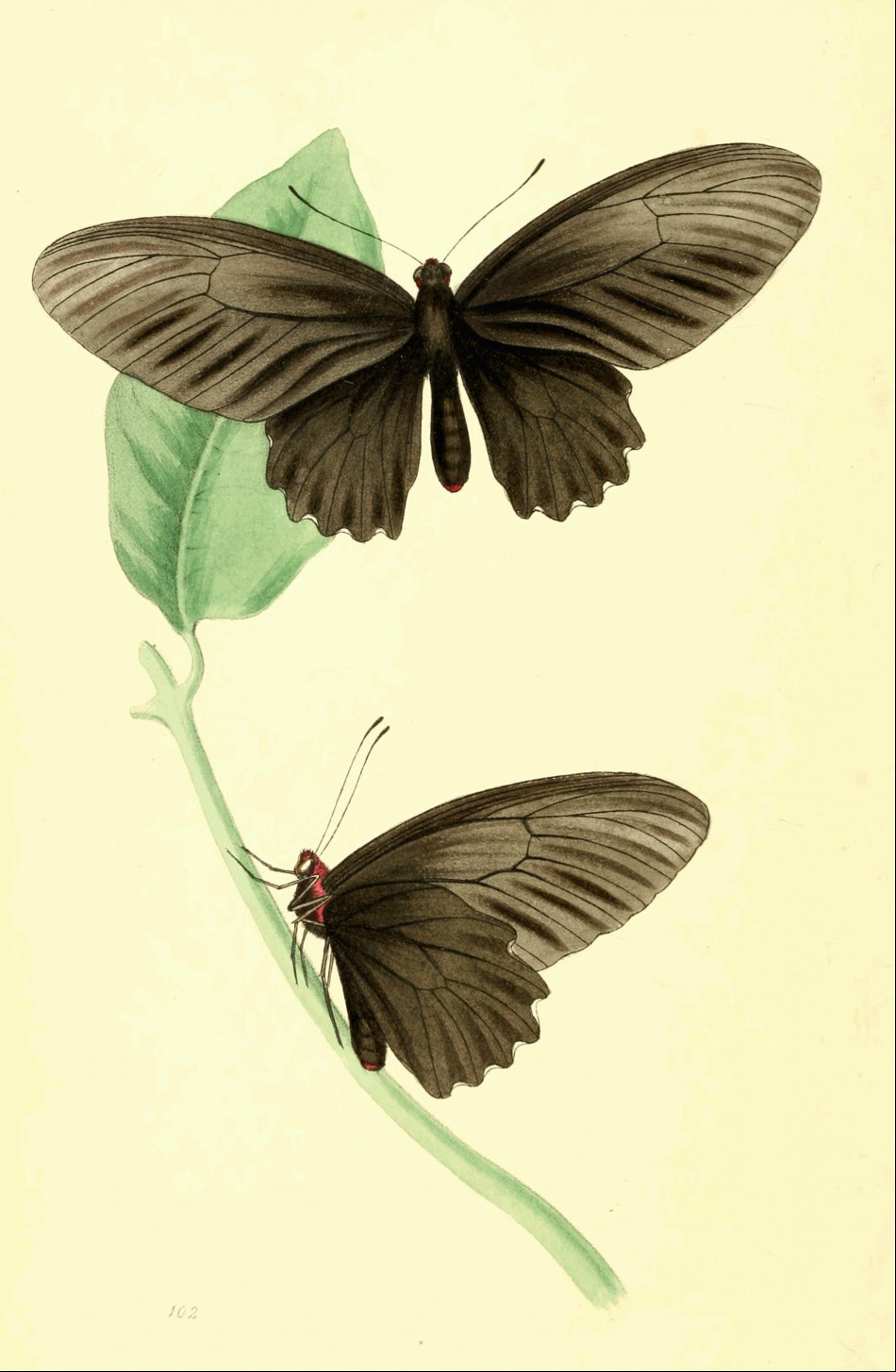
PAPILIO Nox.
Generic Character.—See Pl. 92.
Specific Character.
P. (Troj. orb.) Alis immaculatis fuscis, inferis orbiculatis,
ecaudatis; fronte, strigâ laterali subthoracicâ anoque rubris.P. (Troj. orb.) Wings immaculate, brown; lower orbicular, not tailed;
front, lateral stripe on the thorax beneath, and tip of the body red.
The colours of this insect are unusually sombre, and present a
striking contrast to the gaudy tints by which the majority of these gay
creatures are ornamented; it is so far remarkable, but it is more
interesting to the entomologist, as being an unpublished addition to this
genus. It was discovered in Java by Dr. Horsfield; and the drawing was
made from an unique specimen which I observed while engaged in a long and
laborious arrangement of the Linnæan Papilionidæ, (as they now
appear at the India House,) collected by that zealous naturalist for the
India Company.
Between the nerves of the anterior wings (which are remarkably large)
are parallel central stripes, of a darker brown; a character common to
many Indian species, but not found, I believe, in any of those from the
New World.
Pl.
103
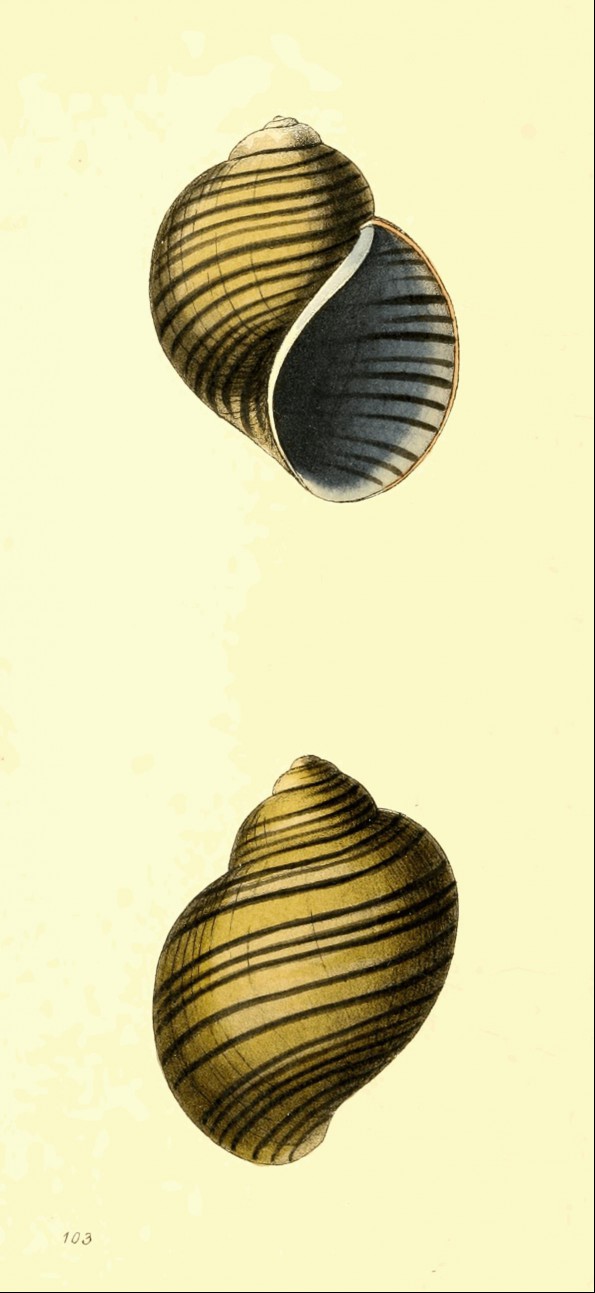
AMPULLARIA fasciata,
Banded Apple Snail.
Generic Character.
Testa globosa, umbilicata. Spira depressa vel brevissima. Apertura
integra, magna, ovata. Operculum testaceum vel corneum. Animal
fluviatile.Shell globose, umbilicated. Spire depressed or very short. Aperture
entire, large, oval. Operculum shelly or horny. Animal
fluviatile.—Generic Type Helix ampullacea Lin.
Specific Character.
A. testâ ovato-globosâ, olivaceâ, fasciis obscuro-purpureis
angustis ornatâ; spirâ brevi, levatâ, apice acuto; labii margine tenui;
umbilico mediocri.Shell ovate-globose, olive, with narrow bands of obscure purple; spire
short, elevated, the tip acute; margin of the lip thin; umbilicus
moderate.Am. fasciata. En. Meth. pl. 457. f. 3. f.
4. (reversed and young).Helix ampullacea. Linn. Lister, 130. f. 30. Seba,
t. 38. f. 1 to 6, 58, 59. Chemnitz, 9.
t. 128. f. 1135. Gualt. t. 1. R.
In the selection of generic characters, sufficiently important to
separate Ampullaria from Paludina, great difficulty at present exists; as
the fundamental principle on which they should be founded (the formation
of the animal) is entirely wanting. It is only known that these shells,
like the Paludinæ, are furnished with an operculum. The absence or
presence of this organ has been found of the first generic importance;
though the substance of which it is composed, as well as the form it
assumes, can be considered only as indicating specific distinctions. This
is proved from the fact, that among the Naticæ some have horny, and some
shelly, opercula: in Phasianella, this part is, in some species, almost
flat, in others remarkably convex; in Turbo, Lam. its form is even
more variable, and in the present genus a similar uncertainty exists. One
species alone has been positively described as having this part shelly,
while in two others the operculum is as certainly known to be horny; to
these last may be added a third, found by myself in the lakes of
Pernambuco in Brazil, but to which I have not immediate access. The
shells here figured were, however, received from the same place by Mrs.
Mawe, and, I think, are of the identical species. The spire is sometimes
worn, and the whole shell very thin.
Several fossil shells of this genus are mentioned as existing in the
extinct volcanoes of Ronca, in bituminous marl near Pont St. Esprit,
&c. as quoted (on the authority of the illustrious Cuvier) by Mr.
Bowdich.
Pl.
104

NATICA punctata,
Spotted Natica.
Generic Character.—See Pl. 75.
Specific Character.
N. testâ ovato-globosâ, crassâ, albâ, strigis undatis punctisque
castaneis ornatâ; umbilico magno, aperto, simplici; columellæ basi
obsoletâ.Shell ovate-globose, thick, white with waved stripes and minute
chesnut dots; umbilicus large, open, simple; base of the pillar
obsolete.Nerita punctata. Martini 11. pl. 197. f. 1903
and 4. Seba, pl. 38. f. 33? Gualt.
pl. 67. f. M. and T. (good.)Gochet. Adanson Sen. pl. 13. f. 4.
The undulated brown lines in this shell, are sometimes broken into
three irregular bands of either lines or spots, between which are
numerous minute dots; in other varieties these dots are only round the
suture, and in some totally wanting. Its most constant character rests on
the umbilicus, which is rather large, very deep, and without any
appearance of the base of the pillar. The mouth is also more contracted
than usual. It is said by Adanson to be common on the coast of Senegal;
and this observing naturalist adds, that the operculum is testaceous, of
a pure white, and marked with numerous concentric grooves at the upper
angle.
NATICA effusa.
N. testâ depressâ, albâ, maculis castaneis ornatâ; spirâ
brevissimâ; columellæ basi crassâ, planâ, ad labium interius sinu
annexâ.Shell depressed, white, with chesnut spots; spire very small;
umbilicus large, open, spreading; base of the pillar thick, flat, and
united to the inner lip by a sinus.
In form, and sometimes in colour, this shell bears a close resemblance
to the oval variety of N. mamilla (Nerita mamilla Lin.); but, the
umbilicus, instead of being entirely closed up, is remarkably open, very
deep, and the pillar forming an elevated ridge within; colour in the
shells of this genus is a very secondary, and, in many cases, a most
fallacious guide for the discrimination of the species; for this is
sometimes pure white, and I have specimens of N. mamilla entirely
orange. This is a rare shell, probably from India.
Pl.
105

TROCHILUS recurvirostris,
Recurved-bill Humming Bird.
Generic Character.—See Pl. 82.
Specific Character.
T. aureo-viridis, jugulo smaragdino; pectore medio corporeque
nigris; rectricibus lateralibus subtùs topazinis; rostro recurvo.Golden green; throat shining emerald green; middle of the breast and
body black; lateral tail feathers beneath topazine; bill recurved.
The extraordinary formation in the bill of this beautiful little
creature, is without parallel in any land bird yet discovered, and
presents in miniature a striking resemblance to that of the Avoset. It is
almost impossible to conjecture rightly the use of this singular
formation; but it appears to me not very improbable, that the principal
sustenance of the bird may be drawn from the pendent Bignoniæ, and
other similar plants, so common in South America, whose corollæ are long,
and generally bent in their tube; the nectar, being at the bottom, could
not be reached either by a straight or incurved bill, though very easily
by one corresponding to the shape of the flower.
The figure is the size of life. Bill black, depressed along the whole
length, but more especially at the tip, which is rounded, thin, obtuse,
and recurved in both mandibles; the under of which, towards the middle,
has a convex swelling, which gives the recurvature a stronger appearance.
All the upper plumage and body beneath golden-green; the throat, to the
breast, shining with scale-like feathers of a vivid emerald-green. From
the breast to the vent is a stripe of black down the middle; thighs
white; tail even, the two middle feathers dull greenish-blue, the rest
above obscure coppery-brown, but beneath of a rich shining topaz
colour.
I believe this bird is unique; I purchased it at Mr. Bullock's
sale, and that gentleman received it from Peru. It presents so much of
the genuine habit of the Trochili, that I have retained it under
that genus; for, though the bill is differently formed, that exception
does not point out any important difference from the general economy of
those birds.
Pl.
106
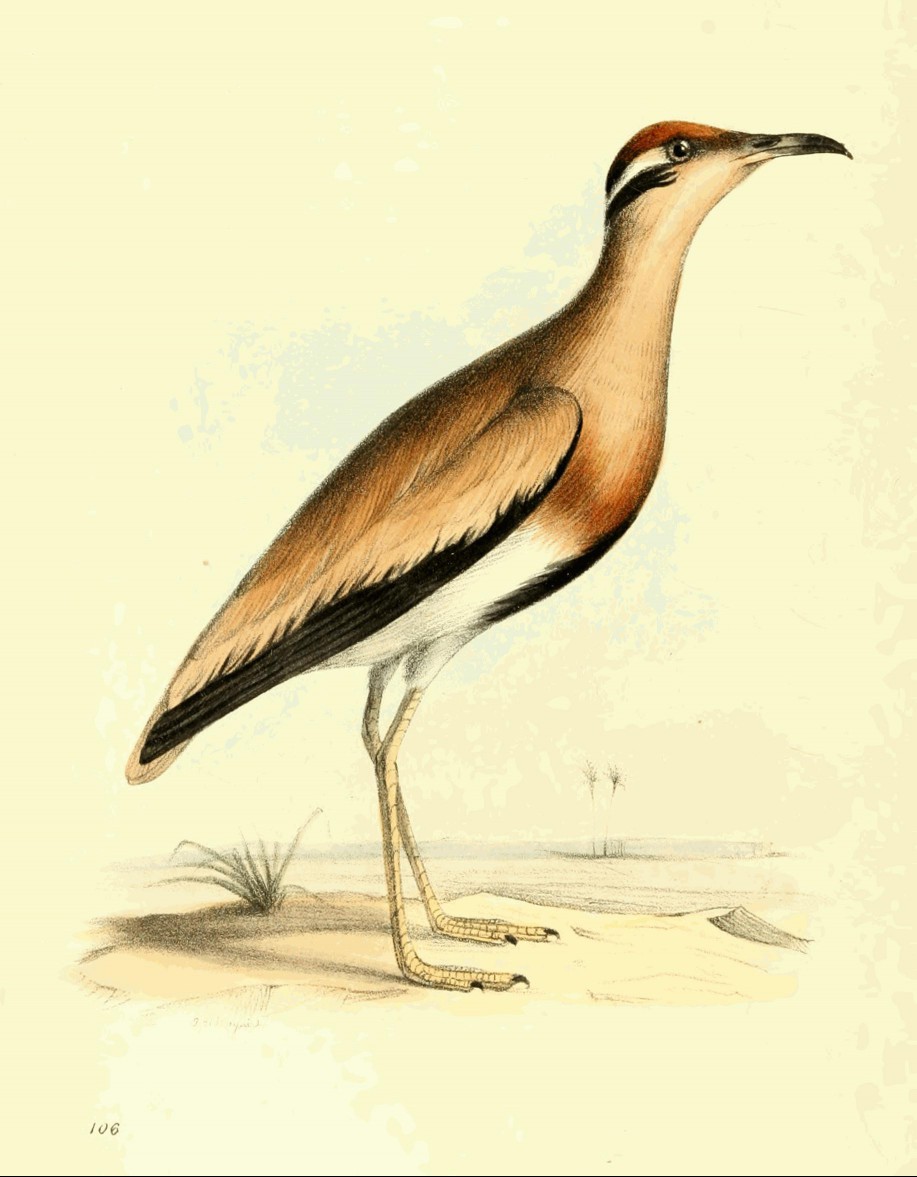
CURSORIUS Temminckii,
Black-bellied Courier.
Generic Character.
Rostrum mediocre, ad apicem compressum, mandibulis arcuatis, basi
depressâ, apice acuto, integro. Nares basales, ovatæ, aperturâ elongatâ,
laterali. Pedes longi, digitis tribus anticis omninò divisis,
interioribus brevissimis, ungue medio pectinato. Remigum penna prima
longissima.—Typus Genericus Cursorius Europæus,
Lath.Bill as long as the head; both mandibles arched, and towards the end
compressed; base depressed, the tip acute and entire; nostrils basal,
oval, the aperture oblong and lateral; legs long, with three toes in
front entirely separated, the inner toes very short, the middle with the
claw serrated; wings with the first quill longest.—Generic Type
Cream-coloured Plover Latham.
Specific Character.
C. colore columbino; vertice pectoreque ferrugineis; torquibus
nuchalibus 2; torque inferiore, remigibus, abdomineque medio nigris;
torque superiore abdominisque lateribus albis.Cream-coloured brown; top of the head and breast ferruginous; nuchal
collar double; the lower, with the quills and middle of the body, black;
the upper, and the sides of the body, white.
Dr. Latham first instituted this genus, of which two species were then
known; M. Le Vaillant discovered another in Africa; and I am happy in now
adding a fourth from the same country, in the possession of Mr.
Leadbeater. No ornithologist has paid greater attention both to the
natural affinities, and to the illustration of the genera allied with
these birds, than Professor Temminck; and I therefore feel pleasure in
naming this bird in honour of that excellent ornithologist, from whom
whenever I have differed, it has been from the sole wish of eliciting
truth. Total length from the bill to the tail eight inches; bill one inch
from the gape, and half from the end of the nostrils; the colours of the
bird are best seen in the figure; the middle of the body, and the quill
feathers, deep black; legs three inches from the naked thigh to the tip
of the middle toe, the claw of which is serrated internally; tail round;
the middle feathers not spotted; the two next with a black dot near the
tip, which, in the next pair, is further broken into two white dots; the
outer pair white. These birds inhabit the arid tracts of Africa, at a
distance from the sea, and run amazingly swift. One species has
occasionally visited England.
Pl.
107
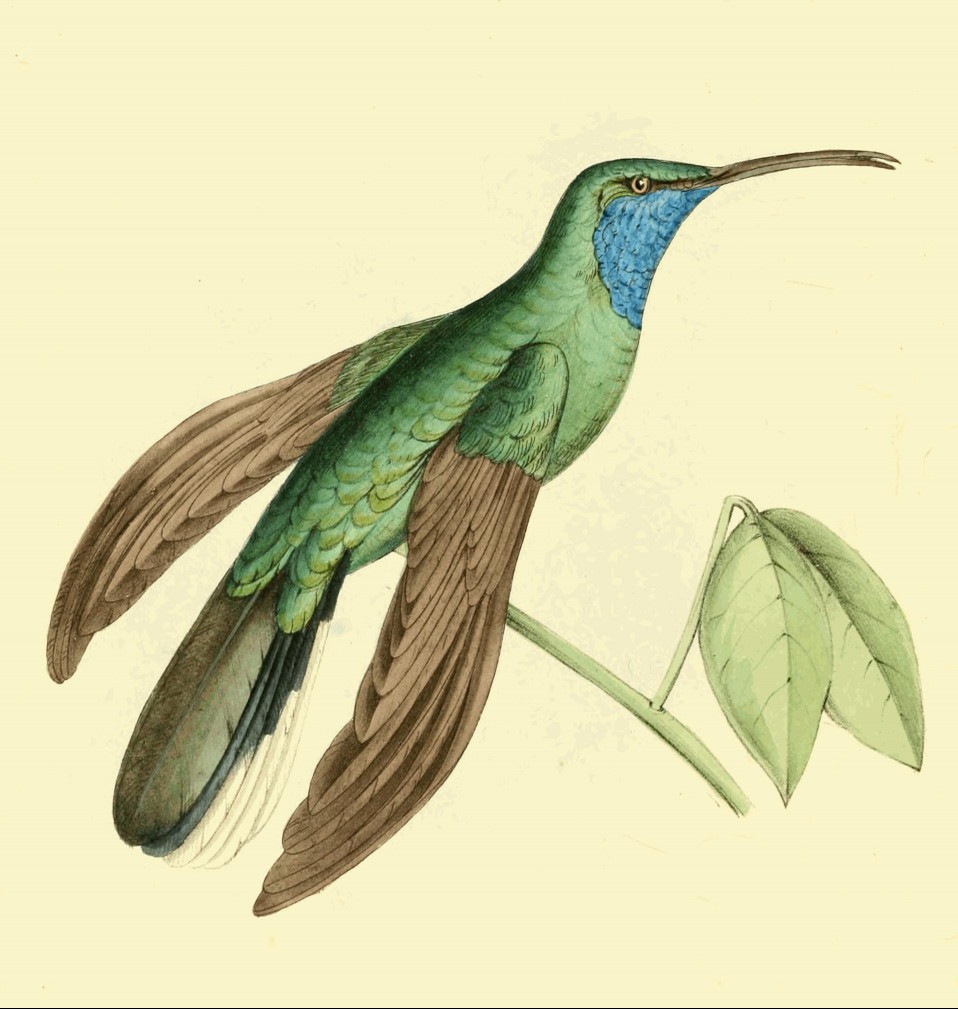
TROCHILUS ensipennis,
Blue Sickle-winged Humming Bird.
Generic Character.—See Pl. 82.
Specific Character.
T. (div. curvirostræ) aureo-viridis, mento juguloque
cæruleo-violaceis; rectricibus paribus; alis falcatis, remigum primorum
scapis dilatato-compressis.Curved-bill Humming Bird, golden green; chin and fore part of the
throat violet-blue; tail even; wings falcated, greater quills with the
shafts dilated and compressed.
I have already offered some observations on the remarkable
construction in the wings of T. falcatus, figured at pl. 83; and
the bird now before us is another unrecorded species, possessing exactly
the same formation. I was at first inclined to believe this bird was the
male of the T. latipennis, (or l'Oiseau Mouche à larges
tuyaux of Buffon), from the under plumage in that species being
uniform grey, a common indication of the female Humming Birds; but a
further comparison of the two has proved this supposition to be
erroneous. They differ, not only in colour, but in their bills; in that
of T. latipennis, the curvature is so slight, that it may be
almost called straight; whereas in this, the curve is very apparent. I
have little doubt future observations will show, that these singular
quill-feathers, now known to exist in three species of this family, are
peculiar only to the male birds.
This extremely rare bird is in my own collection, and is not
improbably unique; the figure is strictly of the natural size; the
plumage, above and below, is a uniform deep green, with a metallic
reflection; half way down, the throat is dark violet blue; tail even, and
very broad, the middle feathers obscure green, the next pair raven or
bluish-black, and the others white, with a black base.
The progress which has been made towards ascertaining the geographic
distribution of animals, leaves no doubt that this bird is an inhabitant
of either the Continent or Islands of South America; but of what
particular country is unknown.
Pl.
108
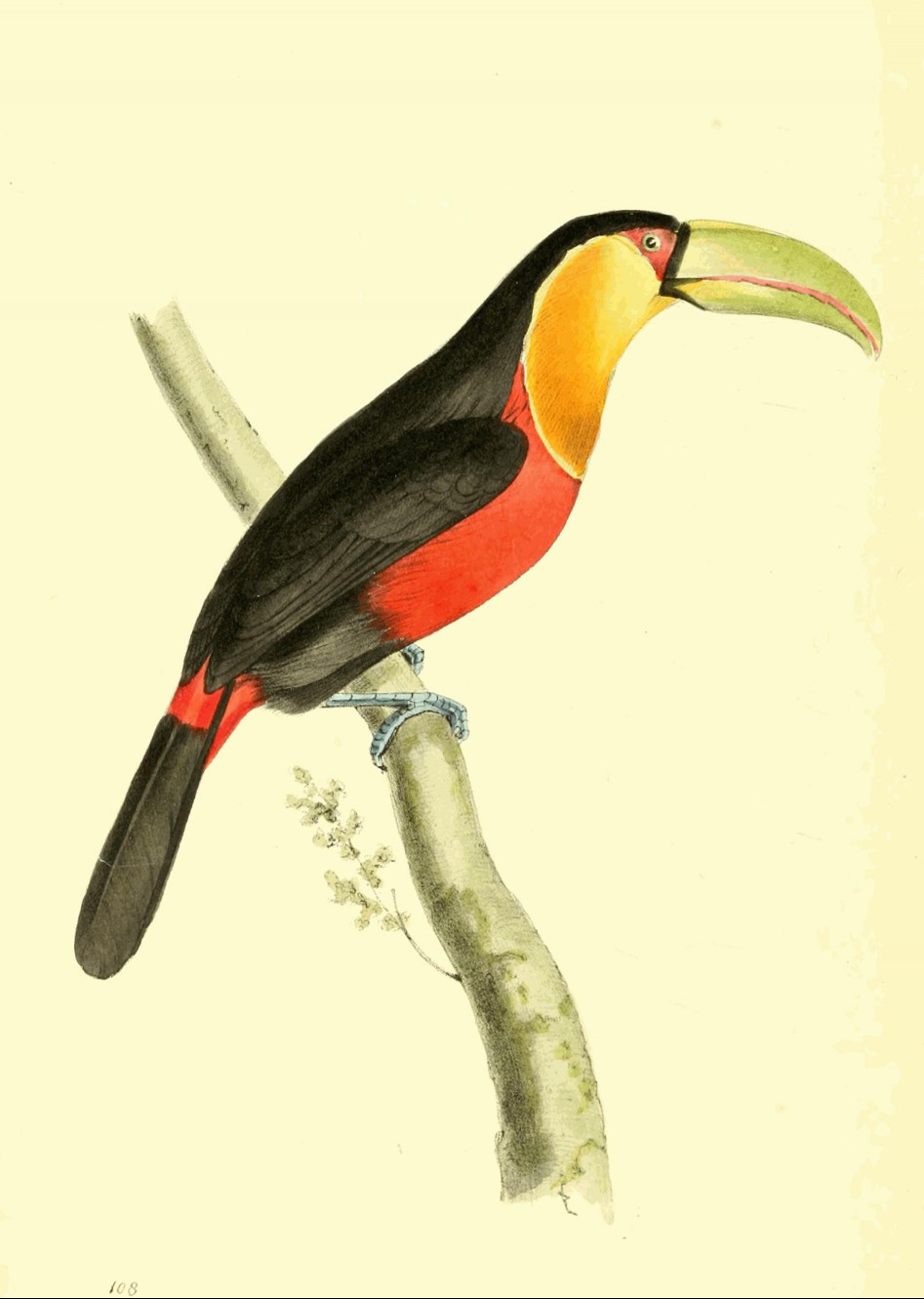
RAMPHASTOS Dicolorus,
Yellow-billed Toucan.
Generic Character.—See Pl. 45.
Specific Character.
R. niger, gulâ aureâ; fasciâ pectorali latâ tegminibusque rubris;
rostro viridi-flavo, basi fasciâ nigrâ transversâ ornatâ; mandibulæ
superioris margine laterali rubro; culmine plano.Black; throat golden-yellow; broad pectoral band and tail-covers red;
bill greenish-yellow, the base with a transverse black band, and the
lateral margins of the upper mandible red; the top flat.R. dicolorus. Gm. p. 356. Lath. Ind. Orn.
p. 135. 2. Turton. vol. i. 211.Yellow throated Toucan. Lath. Syn. 1. 325. Turton. 1.
211. Brisson. Orn. 4. p. 411. pl. 31. f. 1.
Buffon Pl. Enl. 269.Le petit Toucan à ventre rouge. Vaill. H. N. des Toucans,
pl. 8. (optimè).
This is the smallest species of the genuine Toucans yet known,
inhabiting, though sparingly, the northern and southern extremities of
tropical America. It is a species which seems to have been well
understood by Linnæus and the older ornithologists, though none of them
have described the form or peculiarities of the bill; it is probably
owing to this omission, that Dr. Shaw has created an imaginary species in
General Zoology, under the name of R. pectoralis;
compounded of the descriptions he gathered of this bird, and the Linnæan
R. tucanus. Dr. Latham's description is also inaccurate; nor is it
improved in the new edition of his Synopsis, probably from not having
himself seen the bird. Of the figures, there is a masterly delineation by
Barraband, in Le Vaillant's work, but those of Buffon and Brisson are not
to be trusted.
Total length about sixteen inches: bill three and a half; it is
shorter and much thicker along the back, than that of any other species;
this part also is broad, and quite flat; the serratures of the margin
small, and the upper mandible only edged with a line of red; the sides
are compressed, and the colours greenish-yellow; the orbits chesnut-red,
and the feet (as in all the Toucans when fresh) delicate fine blue.
Dr. Langsdorff favoured me with a specimen of this rare bird, shot by
himself in Southern Brazil; the sexes have been dissected by that able
naturalist, but to which the one here figured belongs, I am
unacquainted.
Pl.
109
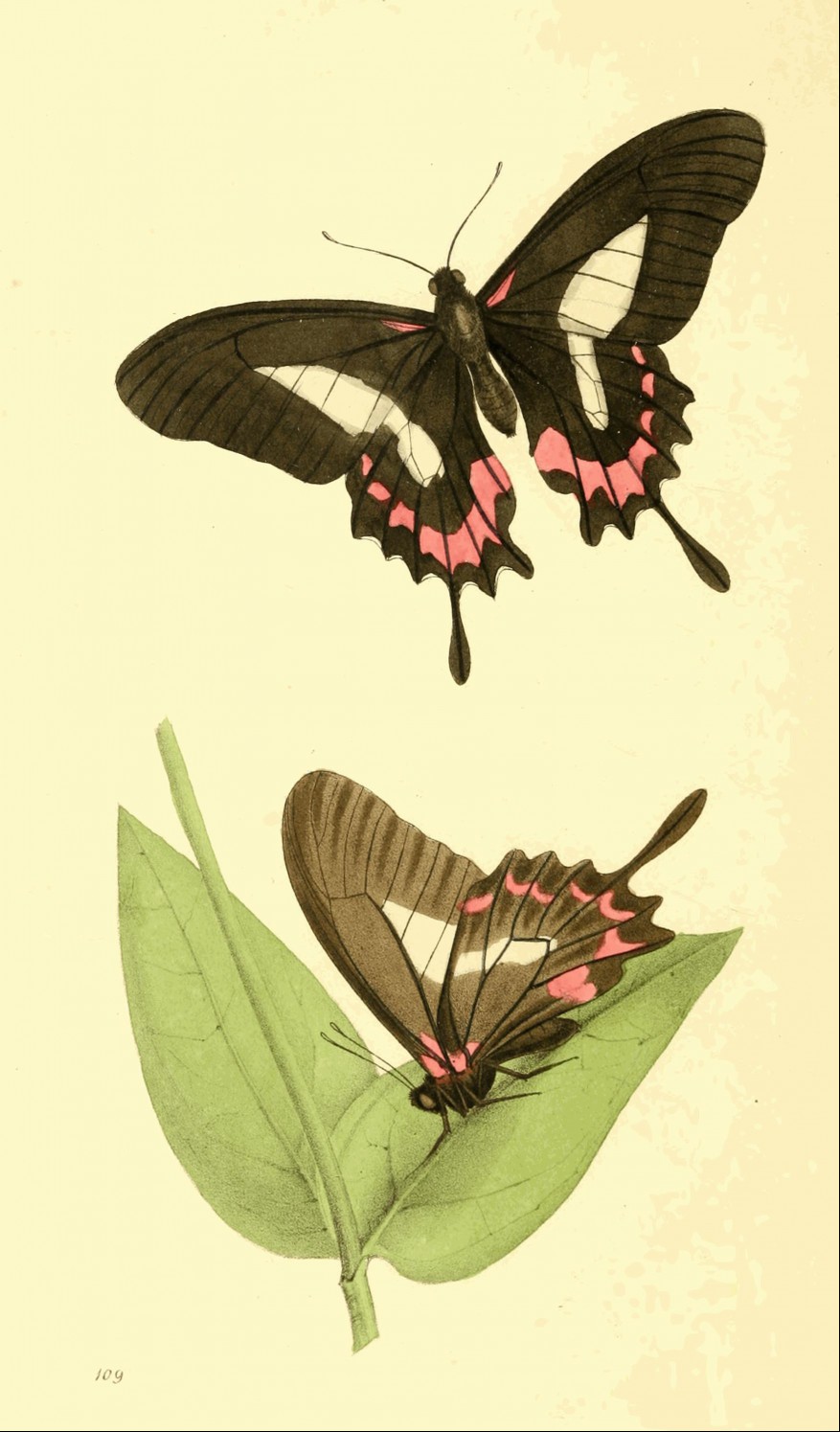
PAPILIO Harrisianus.
Generic Character.—See Pl. 92.
Specific Character.
P. (Troj. caud.) Alis atris, subtùs maculis basalibus coccineis
notatis, anticis suprà maculo coccineo basali fasciâque albâ, posticis
obtusè caudatis fasciâ marginali maculis coccineis sex insigni, fasciâque
mediâ albâ ornatis.Pap. (Troj. caud.) Wings black; anterior above with a red basal spot
and white band; posterior obtusely tailed, with a marginal band of six
crimson spots, and central white spot.
I can find neither figure nor description of this very rare Papilio.
It does not accord with any contained in MM. Latreille's and Godart's
recent monograph of the genus. It was purchased at the sale of the late
Mr. Francillon's cabinet, by N. A. Vigors, Esq., whose valuable
collections in every branch of Zoology are always open to the scientific
inquirer. It is nearly allied to Pap. Tros, Agavus,
Ascarius, and Lysithoüs (Godart), particularly to the
latter; yet it is obviously distinct from either. These affinities lead
me to think that it is a South American insect. The figures will render
any addition to the specific character unnecessary.
I have named this insect to commemorate a most assiduous and observing
entomologist of the last age, Moses Harris, whose memory will be long
cherished by our Aurelians, and to whom the scientific are indebted for
the very accurate and excellent figures contained both in his own works,
and in those of Drury; indeed, he appears the only English artist who has
faithfully represented the short and nearly concealed palpi
peculiar to this genus. The son of this excellent artist[1], still follows the profession of his
father, and, inheriting his abilities, deserves every encouragement that
the small circle of English entomologists, as well as others, can give
him.
Pl.
110

CONUS cinctus,
Purple tipped Admiral Cone.
Generic Character.—See Pl. 65.
Specific Character.
C. testâ suprà carinatâ, fulvâ, fasciis duobus albidis ornatâ;
spiræ brevis, maculatæ, basi depressâ, anfractibus concavis sulcis duobus
insculptis, suturâ alveatâ; basi granosâ, purpureâ.Shell above carinated, fulvous, with two whitish bands; spire short,
spotted, the base depressed; the whorls concave with two depressed lines;
suture channelled; base granulated, purple.
This is a very beautiful, and, at the same time, very rare shell; it
formerly belonged to Mrs. Angus, at whose sale it passed into the cabinet
of Mr. Dubois. Its general appearance resembles very much that of C.
Maldivus Lam. known to our collectors by the name of the Spanish
Admiral: the spire will, however, at once distinguish it; each volution
is strongly concave in the middle, in which part are two or three
delicate indented lines, very near each other, and following the
volutions; the suture also is sufficiently open to be termed channelled;
the spire is quite flattened at the base, (forming a sharp ridge round
the top of the body whorl), and only prominent near the tip. In the
Spanish Admiral Cone, the spire is quite smooth, the whorls being flat,
and in all the specimens I have seen, (and they are many), the suture is
quite closed up, though Lamarck (probably mistaking the present shell)
says, "spirâ canaliculatâ;" the base, moreover, is narrowed, smooth, and
black; not gibbous, granulated, (or striated,) and purple, as in this
shell.
A variety in my own cabinet presents some differences; the base is but
slightly granulated, and the tip not purple; these are, however,
subordinate characters, and constitute it only a variety.
I shall take an early opportunity of pointing out the differences
between C. generalis and Maldivus, two shells even more
likely to be mistaken for each other than those above-mentioned.
Pl.
111
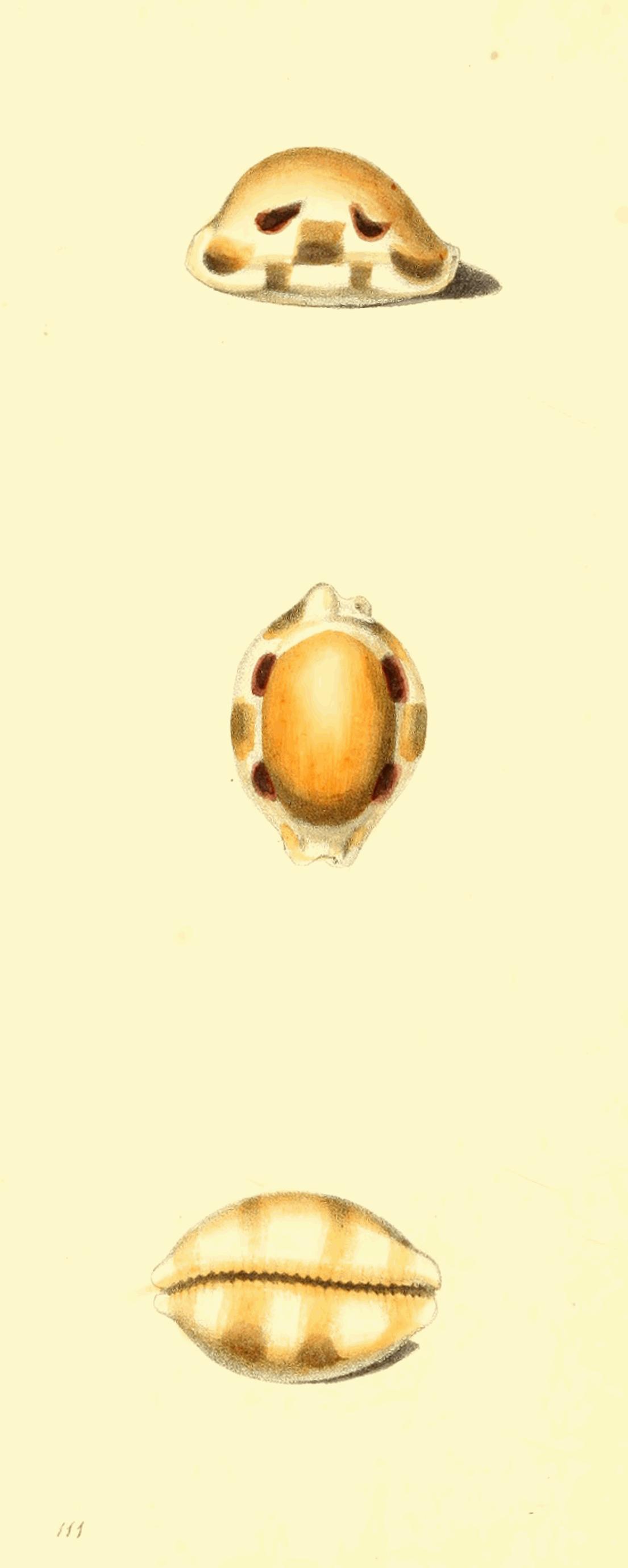
CYPRÆA tessellata,
Mosaic Cowry.
Generic Character.
"Testa lævigata, ovata, convexa, marginibus involutis, apertura
longitudinalis, angustata, utrinque dentata, ad extremitates effusa.
Spira minima, obtecta."—Lam. Ann. du
Mus. vol. 16. p. 443.Animal marinum (Pectinibranchi). Penula dilatata, testam omnino
obtegens. Tentacula depressa, subulata. Oculi juxta tentaculorum basin
externam adsiti.—Adanson, H. N. du
Senegal.Shell smooth, oval, convex, the margins turned inward; aperture
longitudinal, narrow, toothed on both sides, the extremities effuse.
Spire minute, concealed.—Lamarck.Animal marine; mantle dilated and folding over the whole shell.
Tentacula depressed, subulate, at the external base of which are the
eyes.—Adanson.
Specific Character.
C. testâ obtusâ, gibbâ, aurantiacâ, ad latera tesseris albis
fuscisque alternis tessellata.Shell obtuse, gibbous, orange, the sides with alternate tessellated
spots of white and brown.
Amidst all the changes in systematic arrangement which Conchology has,
of late years, undergone, the Cyprææ remain untouched; indeed,
they present such a uniformity of character, that the most superficial
observer cannot mistake them. A few species of Ovula, however, bear a
strong resemblance to the genus, but may be known from not having teeth
on each side the mouth. The Cowries are without exception the most
beautiful of all shells, whether the richness and harmony of their
colours, or the exquisite polish of their exterior, is considered; but
(like many other things of more consequence) their beauty is depreciated
by their frequency. The indefatigable Lamarck has described sixty-six
species, only one of which inhabits the European seas. Adanson has
furnished a minute account of the structure of the animal, and Bruguiere
has given long and interesting details of its economy.
Mrs. Mawe is in possession of this very beautiful little shell; a
string of them were presented her as coming from New Zealand: that which
formed the centre was the only perfect specimen, and from that the
figures were taken.
Pl.
112
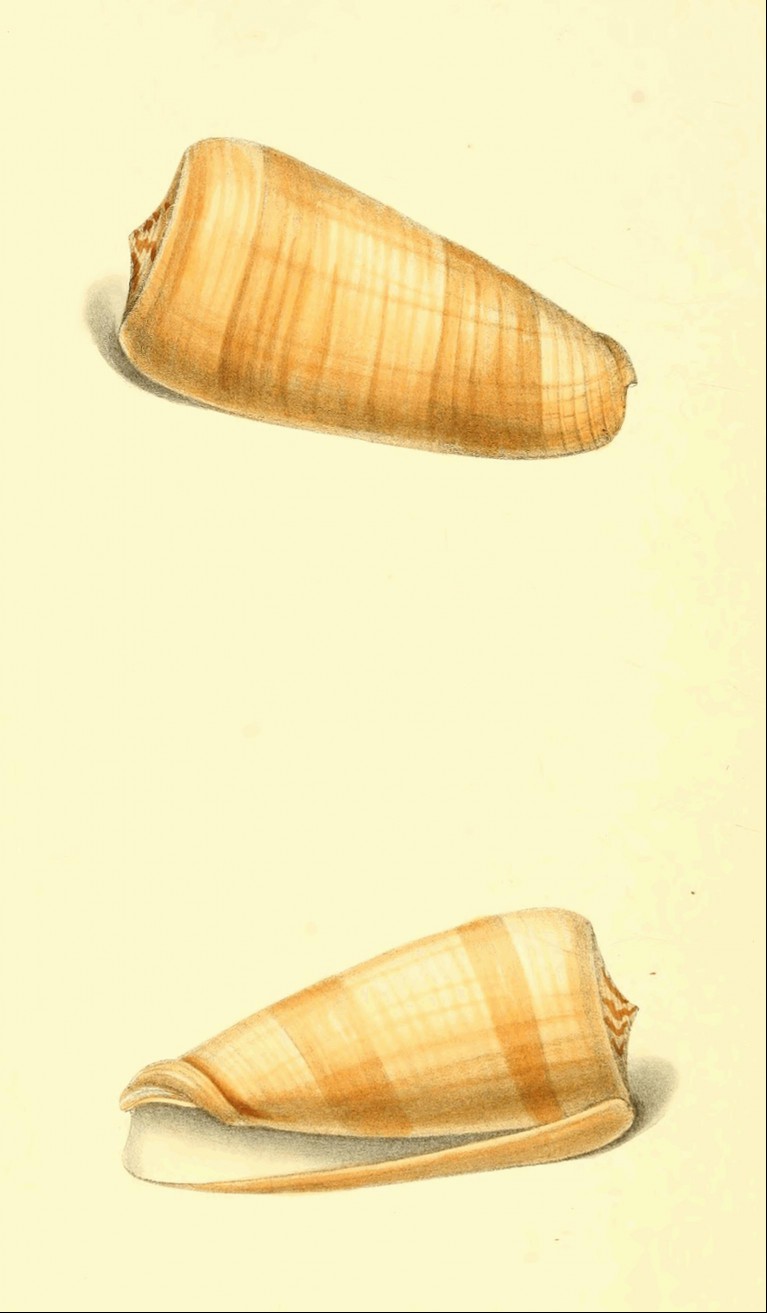
CONUS carinatus,
Carinated Cone.
Generic Character.—See Pl. 65.
Specific Character.
C. testâ sub-cylindraceâ, carinatâ, fulvâ; spiræ depressæ, concavæ,
maculatæ, apice acuto, anfractibus valdè concavis, striis numerosis
subgranosis insculptis; basi obtusâ, striatâ, cingulo gibbo
circumdatâ.Shell nearly cylindrical, carinated, fulvous; spire depressed,
concave, spotted, tip acute, the whorls very concave, with numerous
subgranulated striæ; base obtuse, striated, with a gibbous belt.
Another rare and remarkable shell of this numerous genus, from the
same collection as the Cone last described. I believe it to be hitherto
unfigured, and unknown to any writer; for I cannot reconcile it with any
of Lamarck's descriptions of species not yet represented.
I know of no other specimen than the very fine one in Mr. Dubois'
cabinet. The shell is heavy; the body whorl contracted at the upper part,
where the margin is sharply carinated; the spire much depressed and
concave; each volution is also concave, and has from three to four fine
grooves, which occupy its full extent, and which appear minutely
granulated; but this is only caused by the longitudinal lines of growth:
the tip of the spire acute; the base is wider in circumference than
usual, with a gibbous belt marked by elevated striæ, in other respects
the shell is smooth; the base of the aperture is effuse, the bands on the
body whorl pale and not well defined, and the spire slightly spotted. It
is doubtless an inhabitant of the Asiatic ocean.
Pl.
113
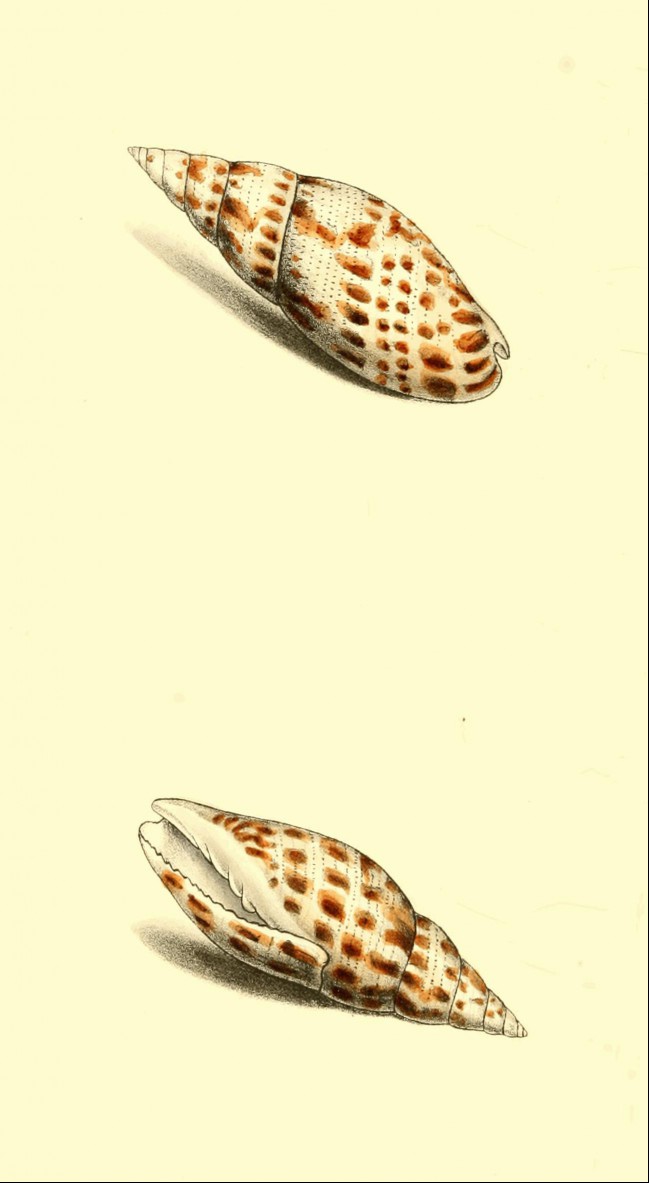
MITRA pertusa. var.
Cardinal Mitre—large spotted variety.
Generic Character.—See Pl. 23.
Specific Character.
M. sect. 3. Testâ ovato-acutâ, albâ; striis transversis
puncticulatis ornatâ, anfractu basali crasso, tesseris parvis plurimis
spadiceis vittato, tesserisque majoribus bifasciato; labio exteriore
denticulato.M. Shell ovate-acute, white, with transverse punctured striæ; the
basal whorl thick, with numerous bands consisting of small, and two of
large tessellated spots; outer lip toothed.
Much uncertainty exists respecting the shell which Linnæus intended
for his Voluta pertusa, owing to the inaccuracy of the synonyms,
which refer to species widely different from each other; the majority of
authors have, however, considered it to be the shell figured by Born and
Martini, under that name, and recently by myself in Exotic
Conchology. As a species, it is principally distinguished by the rows
of irregular brown spots which are always disposed in transverse bands,
running into larger blotches adjoining the suture, and near the base of
the body whorl, which is thick and obtuse; the lesser spots are mostly
tessellated or quadrangular, but in size they vary considerably in
different individuals, and even in the same shell; this has induced
Lamarck to separate them into two species, but which, for reasons to be
hereafter given, appears to me unnecessary.
The variety here figured is very rare, nor have I seen more than two
examples; it differs only from the usual varieties in having the spots
remarkably large. In a future plate this species will be further
illustrated, and the correct synonyms of all the varieties then given.
Inhabits various parts of the Asiatic ocean.
Pl.
114
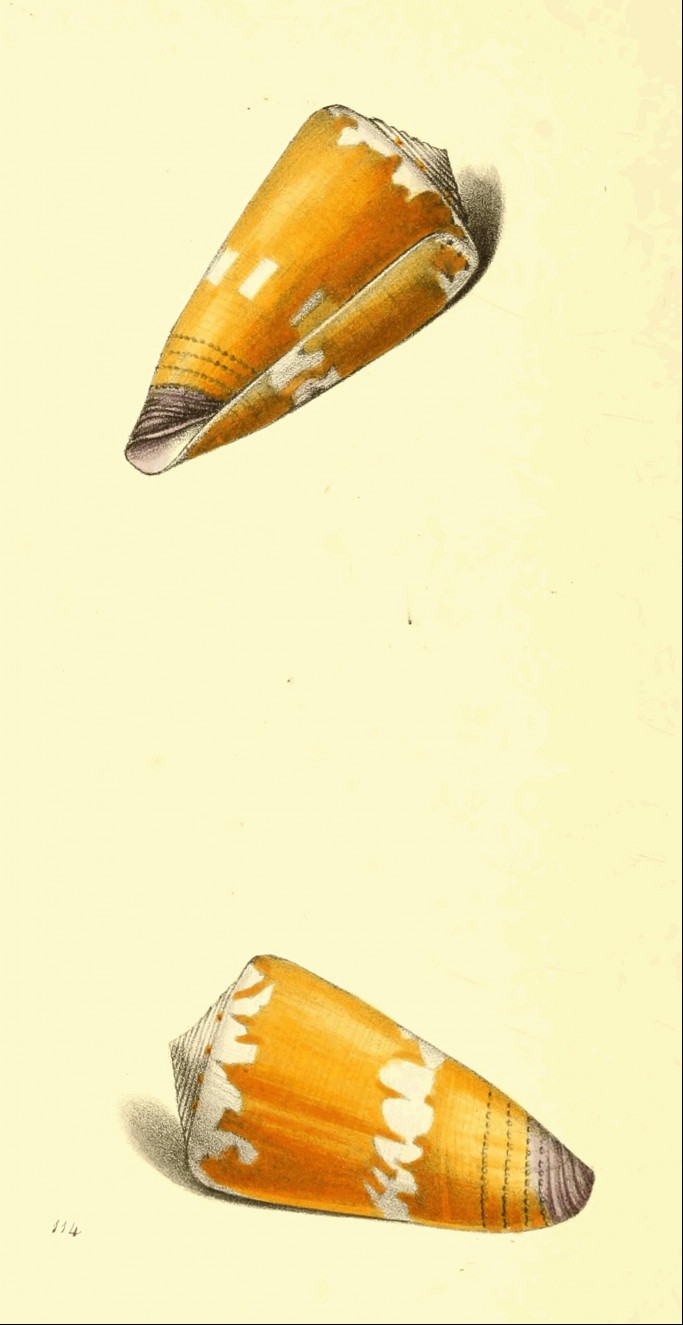
CONUS pulchellus,
Orange Admiral Cone.
Generic Character.—See Pl. 65.
Specific Character.
C. testâ aurantiacâ, fasciis albis interruptis ornatâ; spiræ
subdepressæ, anfractibus suturam juxta simpliciter sulcatis; suturâ
alveatâ; basi granosâ, purpureâ.Shell orange, with two interrupted white bands; spire slightly
depressed, the volutions with a single groove near the margin; suture
channelled; base granulated and purple.
I cannot find this very beautiful shell enumerated among the new and
unfigured species known to Lamarck; and the representations given by the
oldest conchologists of this intricate family, are too inaccurate to be
cited without much risk.
In form it approaches nearest to Conus vitulinus of Bruguiere,
having the spire not quite depressed, each volution being slightly raised
above the last, gradually to the apex; the upper margin of the body whorl
is convex: each volution of the spire has a broad and deep groove nearest
the upper edge, which thus becomes elevated, while the convexity of the
lower part of the whorl forms a channel round the suture, which separates
it from the next; this formation of the spire is very remarkable, and
unlike what I have seen in any other Cone. Another distinguishing
character is, that the whole shell is crossed by very faint, broad, and
almost imperceptible punctured lines, very near each other; in some parts
discernible with the naked eye, in others almost obliterated by the
longitudinal lines of growth: the granulations towards the base are very
sharp and nearly white, and the base itself crossed with rough,
thick-set, elevated striæ. No doubt the colour of this species will be
found to vary, when more specimens are discovered. The only one I have
ever seen, came with some other very rare shells from Amboyna, and is in
my own collection.
If the descriptions of C. canaliculatus (Malacanus Brug.) be
correct, (for it is a shell I have not seen), it must be quite
distinct.
Pl.
115

PLATYRHYNCHUS cancromus. fem.
Short-tailed Flatbill.
Generic Character.
Platyrhinchos, Temminck. Sw. Zool. Ill. (div. I.) Vol.
i. pl. 13.Rostrum tenue, breve, valdè depressum, frontis latitudinem
superans, mandibulæ superioris abruptè aduncæ, et ad apicem emarginatæ,
marginibus dilatatis, et inferioris margines superplicantibus. Nares
medii, basi membranâ pennis minutis instructâ obtectâ, aperturâ parvâ,
rotundâ, terminali, tantùm non nudâ. Rictus ampli, ad mandibulæ
superioris basin vibrissis rigidis armati. Pedes sedentes, graciles,
digitis lateralibus imparibus, digito exteriore ad medii digiti articulum
primum annexo, halluce valido.Bill thin, short, very much depressed, broader than the front of the
head; the upper mandible abruptly hooked and notched at the tip; the
margins dilated, and folding over those of the under mandible; nostrils
central, the base covered with a membrane having minute feathers, the
aperture small, round, terminal, and nearly naked; mouth large, armed
above with stiff bristles; feet sitting, slender; lateral toes unequal,
exterior united to the middle as far as the first joint; hinder claw
strongest.
Specific Character.
P. (fem.) suprà olivaceo-fuscus, infrâ pallidè fulvus; jugulo albo;
genis pennisque spuriis nigris; strigâ ante et pone oculum, maculoque
auriculari albentibus.(Female) above olive-brown; beneath pale fulvous; throat white; ears
and spurious quills black; stripe before and behind the eye, and spot on
the ears whitish.Platyrhinchos cancromus. (male?) Temminck and Laugier.
Pl. Col. Pl. 12. f. 2.
The remarkable breadth of the bill, and the extreme shortness of the
tail, in this bird, render it a very singular little creature. Though a
native of Brazil, I never met with it during my travels in that country;
and the only specimen I have yet seen belongs to Mr. Leadbeater. The
figure of P. cancromus of Professor Temminck, differing only from
this bird in having a yellow crest, leads me to believe they are sexes of
the same species; this being the female bird. The tail in the male
appears to be somewhat longer, but this may be an error of delineation,
and the description has not yet been published.
The figure is of the natural size, and below is an outline of the bill
and nostrils; these latter are depressed, and the base covered with
thickset feathers; the aperture is naked, round, and piercing the
membrane in a lateral direction, midway between the ridge and margin of
the bill, and at the end of the nasal membrane. The plumage above fulvous
brown: darker, and tinged with reddish on the margin of the quills and
tips of the wing covers: spurious quills and stripe beneath the eyes
black: the upper part of the ears are also black, the lower half whitish
yellow; chin and throat whitish; breast and body beneath pale fulvous
brown; tail remarkably short, and not projecting beyond the wings; upper
mandible black, lower white.
Since the publication of the remarks on this genus at Plate 14, a
further consideration of the subject induces me to adopt the opinion of
Professor Temminck, in placing the Todus Platyrhynchos, Gm., and
its allies, under a distinct genus; or, in other words, of detaching from
this group the second division annexed to my former definition of this
genus. Still, however, the close affinities I have there pointed out,
render the generic situation of several of these birds very doubtful;
because the transition from one to the other is so gradual that even the
most accurate set of generic characters, founded on the bill, will not
clearly define the limits between the genera Platyrhynchus and Muscipeta. Their anatomy
might do so, but on this subject we are quite ignorant.
I can gather nothing from the characters which Dr. Horsfield has given
in the Linnæan Transactions of his new genus Eurylaimos; which
does not perfectly agree with those of Platyrhynchus. It appears
to have precisely the same formation of bill, nostrils, legs, &c. as
P. cancromus, but in a higher state of development; thus
strengthening the opinion I have above expressed.
Pl.
116

MUSCIPETA barbata,
Whiskered Flycatcher.
Generic Character.
Rostrum latum, valdè depressum, lateribus aliquando dilatatis,
culmine prominente, mandibulæ superioris apice adunco, plerumque
emarginato, marginibus mandibulæ planæ inferioris margines
superplicantibus. Nares basales, membranâ obtectæ, aperturâ terminali,
ovatâ, vibrissis longis armatâ.Ob. Pedes mediocres vel breves, digito exteriore ad medii articulum
secundum annexo, interiore et medio ad basin modò annexis.Bill broad, much depressed, the sides sometimes dilated, ridge
prominent; tip of the upper mandible hooked, and mostly notched, the
margins folding over those of the under mandible, which is flat; nostrils
at the base of the bill covered by a membrane; the aperture terminal,
oval, and defended by long stiff bristles.Ob. Feet moderate or short; the external toe united to the middle as
far as the second joint, the inner and middle toes united only at their
base.Generic Types (Tem.) Todus plumbeus, Muscicapa borbonica,
Flabellifera, &c.
Specific Character.
M. Supra olivacea, subtus fulva, aureâ cristâ (maribus) insignis;
jugulo albido; uropygio pallidè flavo; caudâ nigrâ.Above olivaceous, beneath fulvous, (male,) with a golden yellow crest;
throat whitish; rump pale yellow; tail black.Muscicapa barbata. Gmelin. i. 933. Lath. In. Orn. 2,
p. 488. n. 86. mas.Whiskered Flycatcher (male). Lath. Syn. 364.
I once shot a pair of these little birds in the forest of Pitanga,
about twenty leagues west of Bahia: this is the only instance which I
know of their having been found in Brazil. The same bird appears,
however, more frequent in Cayenne, according to the older ornithologists.
But whether the bird described by them as the female be really such,
admits of great doubt, because Dr. Latham (probably on the authority of
Buffon) describes it as having a smaller bill, and a few short hairs,
instead of long bristles, at the base; the crown with a spot of yellow, a
longer tail, &c. None of these are, in general, sexual distinctions,
and, moreover, are at complete variance with the female here figured. The
sexes I ascertained by dissection. It follows, therefore, that either the
bird found in Cayenne is a distinct species, or that the bird described
as its female is not such in reality. This latter supposition I apprehend
is nearest the truth.
The figures are of the natural size, the upper representing the
female, and the lower the male bird: the head of the former is entirely
destitute of the crest which distinguishes the latter; in every other
respect the resemblance is uniform. This crest, when not erected, is
concealed, being nearly covered by the olive feathers around it. When
erected, however, it discloses a stripe down the middle of the head of
deep straw-coloured feathers, some of which are tipped with olive. The
upper mandible of the bill is triangular, and much hooked, notched, and
depressed; the colour is black, the perforations of the nostrils are
rather large, and would be naked, were they not partially covered by
numerous stiff bristles, which spring from the base of the bill and angle
of the mouth; between the eye and bill a pale stripe. The plumage above
is dull olive green, with a broad band of very pale yellow across the
rump. Wings and their covers brown; tail and upper covers blackish;
beneath, the plumage is yellowish, the chin almost white, and the breast
and vent tinged with ferruginous; the two first quill feathers are
progressively shorter than the third and fourth, which are equal, and
longer than the others. Legs and claws short, slender, and pale.
This bird would obviously belong to the second division which I had
proposed in my former remarks on Platyrhynchus, and it is in every
respect allied to P. Ceylonensis, Pl. 13. My reasons for
disturbing this previous arrangement have been already given; and, until
a complete investigation is made of the immense genus of Flycatchers, I
concur with M. Temminck in the distribution which he has proposed; viz.
the arrangement of the European species under the old genus of
Muscicapa, and of the exotic under that of Muscipeta; the
characters of which, however, are very imperfect: they are, indeed, at
variance with this bird, which has the outer and middle toe connected
only to the first joint, and the inner toe cleft to the base.
Pl.
117
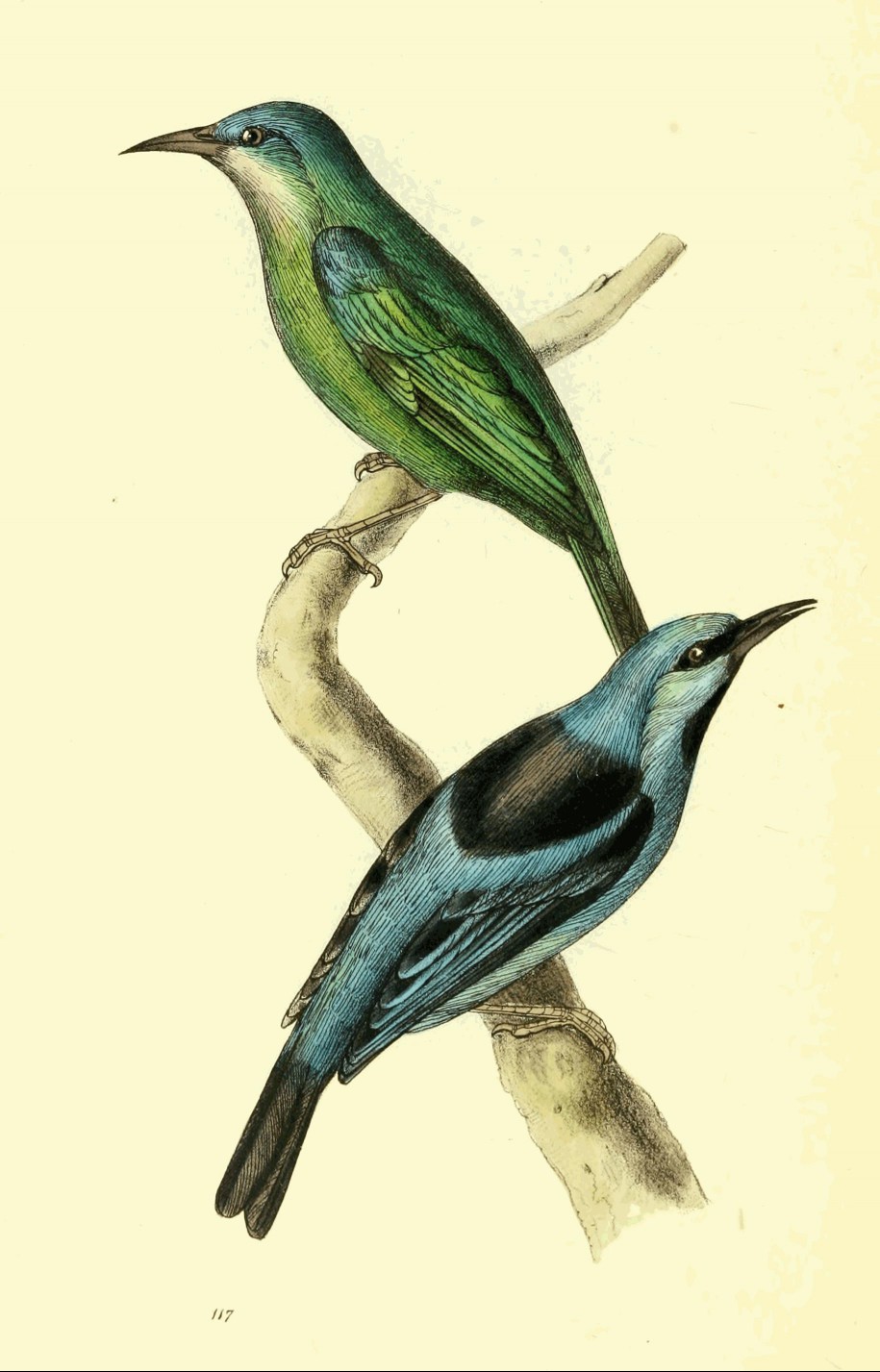
NECTARINIA cyanocephala,
Blue-headed Nectarinia.
Generic Character.
Nectarinia. Illiger. Cuvier. Cæreba Brisson.
Temminck. Certhia. Motacilla Linn.Rostrum longius, gracile, acutum, sub-arcuatum, basi crassâ, latâ, trigonâ, lateribus compressis, mandibulâ superiore apicem
juxta leviter emarginatâ. Nares basales, ovatæ, breves, membranâ nudâ, in
medio ovatè fissâ tectæ. Lingua longa, bifida, apice fibroso, haud
extensibilis. Remigum pennæ primæ tres vix pares. Cauda mediocris,
emarginata, rectricibus 12, sub-paribus.Bill slender, acute, slightly curved, of variable length, base thick,
broad, trigonal, the sides compressed; upper mandible near the tip
slightly notched; nostrils basal, oval, short, covered by a naked
membrane, in the middle of which is an oval aperture; tongue long, bifid,
not extensible, the tip fibrous; the three first quills of nearly equal
length, and longer than the rest; tail moderate, emarginate, of 12 nearly
equal feathers.Generic Types, Div. 1. Certhia cyanea, cayana. Div. 2.
Certhia spiza, &c. Linn.
Specific Character.
N. (mas.) cyanea; jugulo, dorso, caudâ alisque nigris, remigibus
margine cyaneo ornatis. (Fem.) Viridis; capite, genis scapulisque
cærulescentibus; jugulo cano.(Male.) Changeable blue; throat, back, tail, and wings black; the
quills edged with blue. Female green; head, cheeks, and scapulars bluish;
throat grey.
Male.
Motacilla cayana. Linn. Gmelin, 1. 990.
Sylvia cayana. Lath. In. Orn. 2. 545. Gen. Zool. 10.
655.Pepit bleu de Cayenne? Brisson, Ois. vol. 3. pl.
28. 1.Cayenne Warbler. Lath. Syn. 4. 502. Gen. Zool. 10.
655.Sylvia Cayenensis cærulea. Brisson, Orn. 1. p. 455.
Female.
Motacilla cyanocephala. Gmelin, 1. 990.
Sylvia cyanocephala. Lath. In. Orn. 2. 546. Gen. Zool.
10. 684.Sylvia viridis. Brisson, Orn. 1. p. 455.
Le Pepit verd. Brisson, Ois. 3. pl. 28. f. 4.
Blue-headed Warbler. Lath. Syn. 4. p. 503.
Blue-headed Creeper? Lath. Syn. 2. p. 727.
Few birds require more illustration than this very beautiful though
common species; described by most ornithological writers, but hitherto so
little understood, that the two sexes stand as distinct species in a
family of birds to which they have, in reality, no natural affinity.
According to the Linnæan system it should have been rather placed with
the Creepers than the Warblers; an error which has been continued by
every subsequent writer, even by Professor Temminck, whose skilful and
accurate perception of natural affinities is, in general, so remarkably
correct.
That these two birds, however dissimilar in colour, are the sexes only
of one species, repeated dissections in their native country have put
beyond all doubt; and that it is a genuine Nectarinia (or
Cæreba of Temminck) will appear from submitting it to a rigorous
comparison with the characters the Professor himself has laid down for
that genus.
Its habits are no less perfectly the same as the rest of the
Nectariniæ; it is one of the commonest birds of Brazil, and
appears spread over the whole extent of that country. It frequents the
same trees as the Humming-birds, hopping from flower to flower, and
extracting the nectar from each; but this is not done on the wing,
because its formation is obviously different from the Humming-birds,
which, on the contrary, poise themselves in the air during feeding. The
shortness of the bill has evidently given rise to this bird being placed
with the Warblers; but this organ is not shorter in proportion than it is
in Nectarinia spiza, (Certhia spiza of Latham).
I am unacquainted with the other varieties of this species mentioned
by authors. Of the bird here described, I have never seen any variety,
either in Brazil or in our museums. The young males, as usual before
moulting, have the colours of the female; one of them, in an intermediate
state, is in my possession. As both the figures are of the size of life,
and accurately coloured, a fuller description is unnecessary. The rich
sky-blue of the male, in some lights, becomes greenish, and in others
dark blue. The bill, like that of all the genuine Nectariniæ, is
slightly notched a little way from the tip, and the base is much broader
than high.
Pl.
118
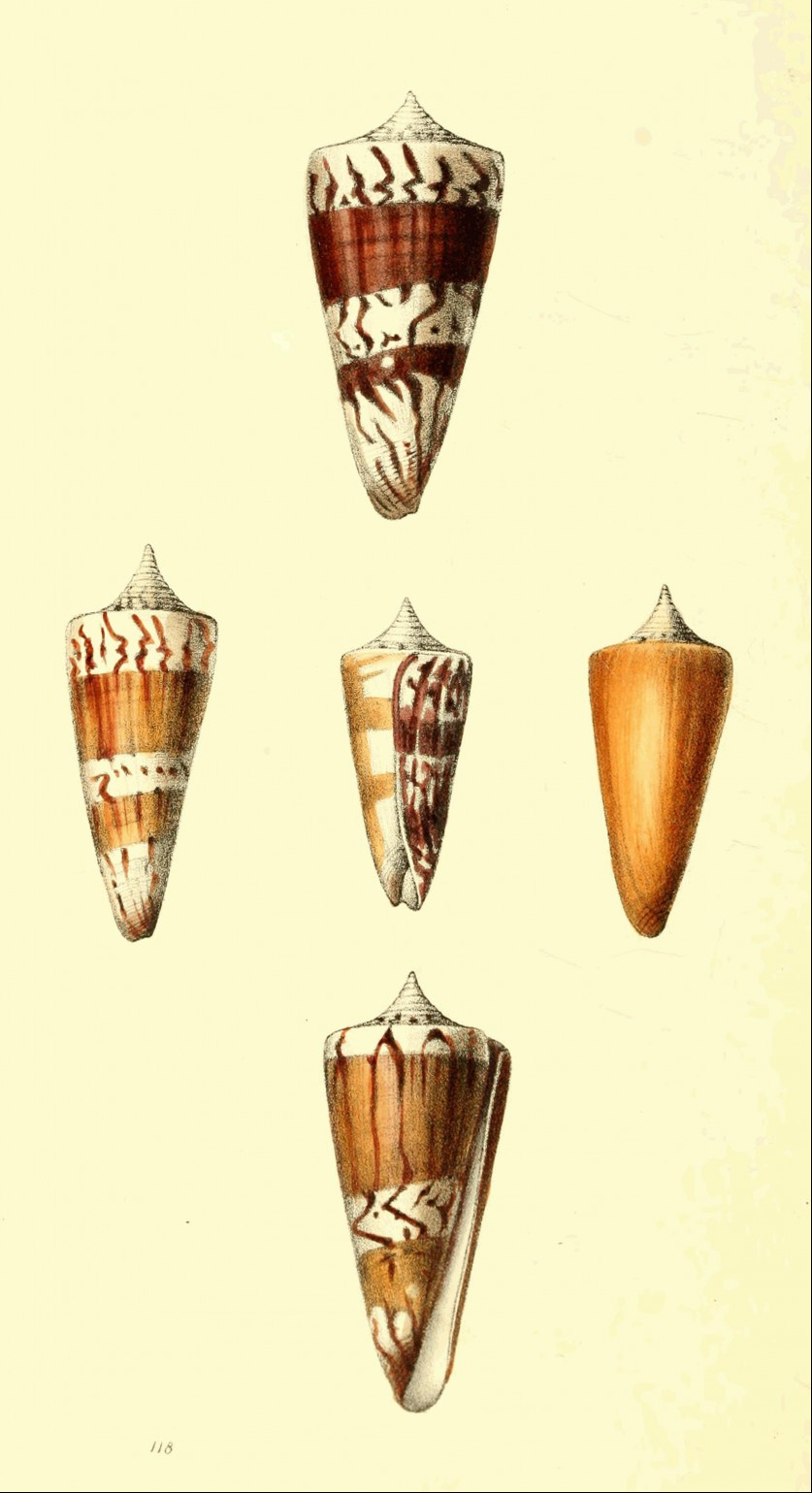
CONUS Generalis,
Flambeau Cone.
Generic Character.—See Pl. 65.
Specific Character.
C. testâ gracili, fuscâ, fasciis albidis strigis undatis
longitudinalibus interruptis ornatâ; spiræ productæ apice acuto,
anfractibus concavis, lævibus; basi nigrâ.Shell slender, brown, with white bands, interrupted by longitudinal
stripes; spire produced, the tip acute, whorls concave, smooth; base
black.Conus Generalis. Gmelin, p. 33. 75. var. a.
Dillwyn, 359. var. a. Martini, vol. 2.
p. 58. f. 645, 646. (dark variety) f. 648
to 652. (pale varieties). Gualt. 20 f. G.Conus Generalis. Brug. p. 642. Lam. Ann.
vol. 15. p. 363.
It becomes necessary to figure this elegant, but not uncommon Cone, in
order to show the young conchologist the little importance that should be
attached to colour in the discrimination of species: the figures
will likewise point out more fully the distinctions between the present
shell, C. maldivus, and C. cinctus; three species, whose
close affinity require illustration.
These relative distinctions may be comprised in a few words; they rest
principally on the spire, which in C. generalis has the upper half
much lengthened, slender, and acuminated: in C. maldivus the spire
is thick and much shorter: the whorls in both these species are quite
plain, and nearly flat: the spire of C. cinctus resembles the last
in form, but is deeply concave and striated. These characters are, I
think, very satisfactory as specific distinctions.
On the other hand, some attention to these shells lately, has
convinced me that many of the species formed both by Bruguiere and
Lamarck should be more correctly considered as varieties; inasmuch as
their specific distinctions rest, for the most part, on colour
alone: this appears, indeed, to be the leading character selected by
these eminent conchologists, and to which, therefore, they have attached
the greatest importance. From this opinion, however, I completely
dissent; on the principle, that no character which is variable can, with
any consistency, be made use of to express permanent distinctions, when
not supported by peculiarity of formation or sculpture. The great art in
framing the description of a species consists in singling out those
characters alone which are most permanent, and exist in every variety of
that species; for, when once a character is found to be variable, it no
longer becomes a distinction by which a species can be recognised. I
consider, therefore, formation and sculpture as the only certain
characters of species, and that variation of colour should alone
distinguish varieties.
It is therefore not surprising that the specific characters given by
MM. Bruguiere and Lamarck, and resting principally on the colours of
these shells, are frequently obscure, and always long; two inevitable
evils attending every attempt to describe minutely the colour, form, and
disposition of the markings of shells. In justice, however, to these
great naturalists, it should be observed, that in this attempt they have
done that best which no writer has ever done well.
The spire of C. generalis is generally spotted, and the white
band on the margin of the body whorl, more or less crossed by broad waved
stripes of a dark brown. It is an inhabitant of many parts of the Indian
Ocean.
Pl.
119
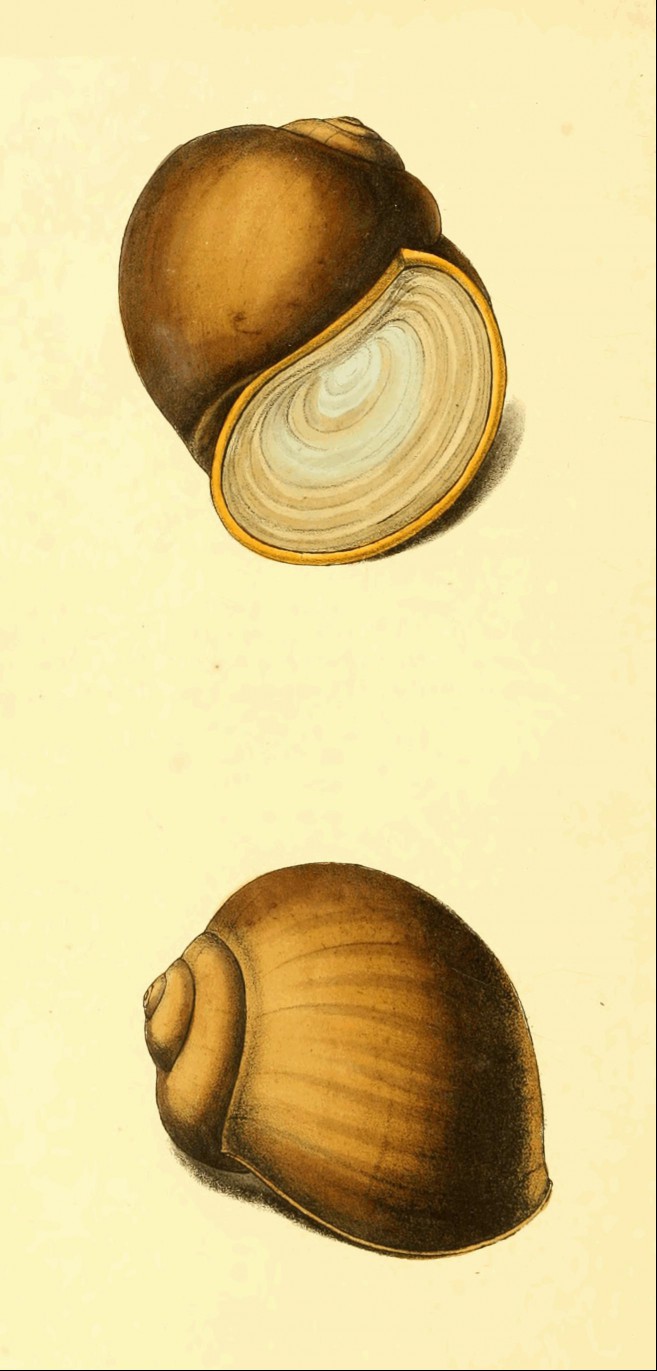
AMPULLARIA globosa,
Round Apple Snail.
Generic Character.—See Pl. 103.
Specific Character.
A. testâ globosâ, lævissimâ, olivaceâ; spirâ depressâ; aperturæ
margine crasso, fulvo, sulcato; umbilico parvo, contracto, juxta basin
posito; operculo testaceo.Shell globose, very smooth, olive; spire depressed; margin of the
aperture thick, fulvous, grooved; umbilicus small, contracted, placed
near the base; operculum shelly.Helix Ampullacea. var. Gmelin, p. 3626.
no. 43. Chemnitz, 9 tab. 128. fig. 1133.
1134. p. 105.
This is the most common of the two shells of this genus, which have
their mouths closed by a shelly operculum. It is well described by
Chemnitz, and his figures are very tolerable; yet, like all the authors
of that period, he considered it as a variety of Helix ampullacea.
From all these supposed varieties it is, nevertheless, quite distinct;
the spire is more depressed than that of any other species, and the
umbilicus is placed near the bottom of the inner lip: the whole shell is
very smooth, and, although generally of a uniform yellowish olive colour,
is sometimes marked by narrow bands of purple brown. The margin of the
outer lip is slightly reflected, and the colour, beneath the epidermis,
almost white. It is a native of the rivers of India.
From the remarks on this genus, made at Plate
103, the fact of their opercula being either shelly or horny, is
sufficiently established. These formations, however, there is every
reason to suppose, may generally be detected by the following
indications. In such species as have a shelly operculum, the margin of
the aperture is thickened all round, and has a parallel internal groove
for its reception: the probable use of this groove I have detailed
elsewhere. On the other hand, in those species which are known to have
horny opercula, this margin and groove do not exist; and that part of the
shell which is between the top of the aperture and the umbilicus, is thin
and unprotected. This latter formation is by far the most frequent, and
leads to the conclusion that the majority of these shells have their
opercula horny.
On the distinctions between this genus and Planorbis, little
need be said. The principal difference consists in the latter having no
operculum; but another, and a very remarkable one, (which seems to have
escaped all writers,) is, that the shells of the latter genus are
destitute of any columella. The Planorbis cornu-arietis of
Lamarck, has been removed by Mr. G. Sowerby to this genus. This shell, it
is true, appears to be intermediate between one and the other; but the
only affinity which it bears to Ampullaria, is in the oval form of
the aperture; while it is allied to Planorbis by its discoid form,
want of the columella, and being universally described as without an
operculum: the preponderance of evidence is clearly in favour of the
situation originally assigned to it by Lamarck.
The characters, therefore, given to the genus Ampullaria by Mr.
G. Sowerby, will be found incorrect. There was no necessity for
explaining, much less for altering, (in this instance,) the masterly
definitions of Cuvier and Lamarck. With regard to the second species
given by Mr. Sowerby to illustrate this genus, he is no less in error;
for the real A. rugosa, of all authors, is a strikingly distinct
shell from that which he has figured under this name. This will be
sufficiently obvious by referring to the figures either of Lister,
Chemnitz, or Lamarck.
Having offered these remarks on a subject to which I have paid some
attention, I wish to refrain from pointedly noticing other errors and
misconceptions into which Mr. G. Sowerby has fallen; rather wishing that
greater experience, and more matured judgment, may lead him to do this
himself, prior to the publication of the system of Conchology which he
has announced.
GENERAL ALPHABETIC INDEX
OF
LATIN AND ENGLISH NAMES
TO
VOLUME II.
| Pl. | Pl. | ||
| Achatina emarginata | 84 | Mitre, thick | 88 |
| fasciata | 74 | Muscipeta, Gen. Char. | 116 |
| vittata | 84 | barbata | ib. |
| Chesnut-banded | 74 | Natica, Gen. Char. | 75 |
| notched | 84 | effusa | 104 |
| Ribbon | ib. | melastoma | 79 |
| Ampullaria, Gen. Char. | 103 | mustelina | ib. |
| fasciata | ib. | punctata | 104 |
| globosa | 119 | spadicea | 75 |
| Anodon, Gen. Char. | 96 | sordida | 79 |
| rugosus | ib. | banded | 75 |
| Apple-snail, banded | 112 | belted | 79 |
| globular | 119 | brown | ib. |
| Aracari, lettered | 90 | black-mouthed | ib. |
| Bee-eater, black-capped | 76 | spotted | 104 |
| Botis, Gen. Char. | 77 | open | ib. |
| bicolor | ib. | Nectarinia, Gen. Char. | 117 |
| marginata | 77 | cyanocephala | ib. |
| Cinnyris, Gen. Char. | 95 | blue-headed | ib. |
| chalybeia | 95 | Oceanic snail, common | 85 |
| Conus carinatus | 112 | globular | ib. |
| cinctus | 110 | Papilio, Gen. Char. | 92 |
| generalis | 118 | Evander | 101 |
| Princeps | 86 | Harrisianus | 109 |
| pulchellus | 114 | Nox | 102 |
| terebra | 70 | Torquatus | 94 |
| Cone, carinated | 112 | Polymetus | 92 |
| Flambeaux | 118 | Pandrosus | 93 |
| Orange Admiral | 114 | Parrakeet, grey-breasted | 89 |
| Prince | 86 | turcosine | 73 |
| Screw | 70 | Paludina, Gen. Char. | 98 |
| Cowry, Mosaic | 111 | elongata | ib. |
| Courier, black-bellied | 106 | unicolor | ib. |
| Crab-eater, Cinnamon | 67 | carinata | ib. |
| Creeper, lesser-collared | 95 | Picus affinis | 78 |
| Cursorius, Gen. Char. | 106 | Platyrhynchus, Gen. Char. | 115 |
| Temminckii | ib. | cancromus | ib. |
| Cypræa, Gen. Char. | 111 | Pogonias, Gen. Char. | 68 |
| tessellata | ib. | hirsutus | 72 |
| Date-shell, banded | 97 | rubrifrons | 68 |
| grey | ib. | Psittacus murinus | 89 |
| Fly-spot | ib. | pulchellus | 73 |
| Ear-shell, small-holed Cal. | 80 | Pteroglossus inscriptus | 90 |
| Flatbill, short-tailed | 115 | Puff bird, greater pied | 99 |
| Flycatcher, bearded | ib. | River-snail, long-spired | 98 |
| Hairstreak, red-bordered | 69 | olive | ib. |
| Halcyon, cinnamominus | 67 | carinated | ib. |
| Haliotis, Gen. Char. | 80 | Ramphastos dicolorus | 108 |
| Californiensis | ib. | Sphinx, Gen. Char. | 87 |
| Hawk-moth, wild vine | 87 | Ello | 81 |
| Ello | 81 | Labruscæ | 87 |
| Humming-bird, white-tailed | 82 | Strombus dilatatus | 71 |
| sickle-winged | 83 | mutabilis | ib. |
| blue sickle-winged | 107 | little pink-mouthed | ib. |
| recurved bill | 105 | winged | ib. |
| Horsemussel, wrinkled | 96 | Tamatia, Gen. Char. | 99 |
| Ianthina, Gen. Char. | 85 | macrorhynchos | ib. |
| fragilis | ib. | Thecla, Gen. Char. | 69 |
| globosa | ib. | Galathea | ib. |
| Licinia Amphione | 91 | Toucan, yellow billed | 108 |
| Marginella, Gen. Char. | 97 | Tooth-bill, red-fronted | 68 |
| cingulata | ib. | hairy-breasted | 72 |
| faba | ib. | Trochilus, Gen. Char. | 82 |
| prunum | 97 | niger | ib. |
| Merops Savignii | 76 | falcatus | 83 |
| Mitra caffra | 88 | recurvirostris | 105 |
| crassa | ib. | ensipennis | 107 |
| pertusa, var. | 113 | Xenops, Gen. Char. | 100 |
| Mitre Brown, wh. banded | 88 | genibarbis | ib. |
| Cardinal, var. | 113 | whiskered | ib. |
SYSTEMATIC INDEX.
VERTEBROSA.
PART II.
ORNITHOLOGY.
| Pl. | |
| Halcyon cinnamominus | 67 |
| Pogonias rubrifrons | 68 |
| hirsutus | 72 |
| Picus affinis | 78 |
| Psittacus pulchellus | 73 |
| murinus | 89 |
| Merops Savignii | 76 |
| Trochilus niger | 82 |
| falcatus | 83 |
| recurvirostris | 105 |
| ensipennis | 107 |
| Pteroglossus inscriptus | 90 |
| Ramphastos dicolorus | 108 |
| Cinnyris chalybeia | 95 |
| Tamatia macrorhynchos | 99 |
| Xenops genibarbis | 100 |
| Cursorius Temminckii | 106 |
| Platyrhynchus cancromus | 115 |
| Muscipeta barbata | 116 |
| Nectarinia cyanocephala | 117 |
SYSTEMATIC INDEX.
ENTOMOLOGY.
PART II.
| Pl. | |
| Thecla Galathea | 69 |
| Licinia Amphione | 91 |
| Papilio Polymetus | 92 |
| Pandrosus | 93 |
| Torquatus | 94 |
| Evander | 101 |
| Nox | 102 |
| Harrisianus | 109 |
| ——— | |
| Sphinx Ello | 81 |
| Labruscæ | 87 |
| ——— | |
| Botis marginata | 77 |
| bicolor | 77 |
SYSTEMATIC INDEX.
CONCHOLOGY.
PART II.
| Pl. | |
| Strombus mutabilis | 71 |
| dilatatus | 71 |
| Achatina fasciata | 74 |
| emarginata | 84 |
| vittata | 84 |
| Ianthina fragilis | 85 |
| globosa | 85 |
| Mitra caffra | 88 |
| crassa | 88 |
| pertusa | 113 |
| Marginella cingulata | 97 |
| prunum | 97 |
| faba | 97 |
| Paludina elongata | 98 |
| unicolor | 98 |
| carinata | 98 |
| Natica spadicea | 75 |
| mustelina | 79 |
| sordida | 79 |
| melastoma | 79 |
| punctata | 104 |
| effusa | 104 |
| Cypræa tessellata | 111 |
| Conus terebra | 70 |
| princeps | 86 |
| cinctus | 110 |
| carinatus | 112 |
| pulchellus | 114 |
| generalis | 118 |
| Anodon rugosus | 96 |
ADDENDA ET CORRIGENDA.
| Pl. 67. | line 5, | for "plumesque" read "plumisque." |
| 16, | for "gigantia" read "gigantea." | |
| — 69. | — 11, | for "excerted" read "exserted." |
| — 70. | — 02, | for "Cane" read "Cone." |
| 5, | for "fasciique" read "fasciisque." | |
| 24, | for "renders" read "render." | |
| — 71. | — 07, | for "apertura" read "aperturâ." |
| 16, | for "urseus" read "urceus." | |
| 11 from the bottom, for "gracibus" read "gracilibus." | ||
| — 91. | — 16, | for "and Godart mentions" read "and according to Godart." |
| — 92. | — 13, | for "caudi," read "caudis." |
| 8 from the bottom, for "c. Dentatis" read "c. Dentati." | ||
| — 92. | third page, line 3, for "Medicii" read "Medici." | |
| 10, | for "Danais" read "Danaus." | |
| fourth page, line 10, dele "not." | ||
| — 95. | — 12 | from the bottom, after "angustâ" add a comma. |
| second page, line 14 from the bottom, for "Nectarinia" read "Nectariniæ." | ||
| — 115. | second page, line 10 from the bottom, after "between the" add "genera." | |
| line 5 from the bottom, for "Eurylaimos" read "Eurylaimus." | ||
| — 117. | — 06, | for "lata" read "latâ." |
In the Systematic Index to Vol. I. Conchology, Part I., for
"Acephalis" read "Acephali;" and at the head of the list of
errors, for "Corregenda" read "Corrigenda."
NOTES
[1] Mr. Moses Harris, artist, 28,
Mansion-House Street, Kensington.
Featured Books

The Golden Scorpion
Sax Rohmer
lid black; /* a thin black line border.. */ padding: 6px; /* ..spaced a bit out from the gr...

A New Piñon Mouse (Peromyscus truei) from Durango, Mexico
Robert B. Finley
miles to the southeast.Morphological differences from P. t. gratus, as well as geographicconsiderat...

Animals of the Past
Frederic A. Lucas
ife,21; early vertebratesdifficult of preservation,22; armored fishes,23; abundanceof early fishes,2...

Metabolic Adaptation to Climate and Distribution of the Raccoon Procyon Lotor and Other Procyonidae
John N. Mugaas, John Seidensticker, and Kathleen P. Mahlke-Johnson
of theirwarm-adapted ancestors, whereas Procyon lotor evolved a different set of adaptations that h...

The Extermination of the American Bison
William T. Hornaday
ast of burden5. List of bison herds and individuals in captivityPart II.—The exterminationI. Cause...

The Golden Dream: Adventures in the Far West
R. M. Ballantyne
ball at the end of it, which, strange to say, was transparent, and permitted a bright flame within t...

Away in the Wilderness
R. M. Ballantyne
oat. On his head he wore a little round cap, which he had made with his own hands, after having caug...

Ungava
R. M. Ballantyne
, as the young man, whose shout had thus rudely disturbed the surrounding echoes, leaned on the muzz...
Browse by Category
Join Our Literary Community
Subscribe to our newsletter for exclusive book recommendations, author interviews, and upcoming releases.

Comments on "Zoological Illustrations, Volume 2" :